

HEALTH • MONEY • TRAVEL • RECIPES • FASHION • TECHNOLOGY FEBRUARY 2022 Richard Carpenter On Luck, Love & Losing Karen 100 Word-Story Competition WIN £1000! A NNIVE R SARY ED I TION 100 YEARS FEBRUARY 2022 £3.99 readersdigest.co.uk A SPECIAL MESSAGE FROM HER MAJESTY THE QUEEN Ricky Gervais “We’ve All Got The Power To Be Kind”

Contents
16 IT’S A MANN’S WORLD
Olly Mann swaps beauty salons for barbershops
ENTERTAINMENT
20 INTERVIEW:
RICKY GERVAIS
The British comedy legend opens up about success, kindness, and his life partner
28 “I REMEMBER”: RICHARD CARPENTER
The iconic musician on his early career, addiction, and losing his sister, Karen HEALTH
36 LIVING WITH ANXIETY
What’s the line between worrying and chronic anxiety?
INSPIRE
54 MEDICAL MARVEL
A medical student finds the cure for his illness through his own research
70 DEWITT WALLACE
The remarkable story of the founder of Reader’s Digest Features

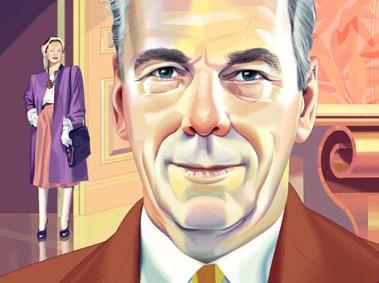
79 100-WORD-STORY
Our beloved competition is back—here’s everything you need to know to enter
82 CANINE LOVE
Jennifer Finney Boylan on what her dogs taught her about love
88 TRAVEL DANCING IN RIO
One journalist’s attempt to learn samba in time for Rio carnival
FEBRUARY 2022 • 1
FEBRUARY 2022
p70 p4 cover photograph Joby Sessions/Future/Shutterstock












has a book in them
0800 999 2280
It’s called an autobiography The gift of a
Everyone
Call our memoir experts today Why wait? Turn the story of your life into a beautiful, handcrafted book with LifeBook, the world’s leading autobiography service. Create a unique piece of family treasure to be shared by generations to come. It’s time to tell your story.
lifebookuk.com
lifetime


FEBRUARY 2022 • 3 7 Over to You 12 See the World Differently HEALTH 44 Advice: Susannah Hickling 48 Column: Dr Max Pemberton INSPIRE 68 If I Ruled the World: Barbara Dickson TRAVEL & ADVENTURE 96 My Great Escape 98 Hidden Gems: Melbourne MONEY 102 Column: Andy Webb DIY 106 Column: Mike Aspinall FASHION & BEAUTY 108 Column: Bec Oakes’ Fashion Tips 110 Beauty FOOD & DRINK 112 A Taste Of Home 114 World Kitchen: Milan ENTERTAINMENT 118 February’s Cultural Highlights BOOKS 122 February Fiction: James Walton’s Recommended Reads 127 Books That Changed My Life: Sophie Hannah TECHNOLOGY 128 Column: James O’Malley FUN & GAMES 130 You Couldn’t Make It Up 133 Word Power 136 Brainteasers 140 Laugh! 143 Beat the Cartoonist 144 A Century Of Change
p112 Contents FEBRUARY 2022 p68
In every issue

SHUTTERSTOCK

WINDSOR CASTLE
As Reader’s Digest celebrate its One Hundredth year, it is with great pleasure that I send my best wishes to you, the readers and all those associated with the publication.
Founded with the spirit of bringing the best writing to a worldwide audience, you have enlightened, encouraged and entertained individuals on a variety of subjects and important issues.
On this notable anniversary, I wish you every success for the future and hope you continue to inspire people around the world through the power of the written word for many years to come.
ELIZABETH R.
1st February, 2022.
SENIOR EDITORS Anna Walker, Eva Mackevic
EDITORIAL ASSISTANT Marco Marcelline
ART DIRECTOR Richard Cooke
ADVERTISING Jigs Pankhania
HEAD OF FINANCE Santwana Singh
FINANCE MANAGER Irving Efren
MANAGING DIRECTOR Julie Leach CHAIRMAN Gary Hopkins
TRUSTED MEDIA BRANDS INC (USA)
President and Chief Executive Officer
Bonnie Kintzer
Editor-in-Chief, International Magazines
Bonnie Munday
WE PAY...
£50 for the star letter and £30 for regular letters.
Email readersletters@readers digest.co.uk or go to readers digest.co.uk/contact-us
WE ALSO PAY...
£30 for the true stories, anecdotes, jokes in Laugh! and You Couldn’t Make It Up…, and contributions to end-ofarticle fillers and My Great Escape
Email excerpts@readersdigest.co.uk or go to readersdigest.co.uk/contact-us
SORRY!
We cannot acknowledge or return unpublished items or unsolicited article-length manuscripts. Do not send SAEs. Article-length stories, poetry and cartoons are not requested.

CUSTOMER SERVICES
Contact Customer Services for renewals, gifts, address changes, payments, account information and all other enquiries. Call 0330 333 2220* or email customer_service@readersdigest.co.uk
TALKING MAGAZINES
Reader’s Digest is also available in audio and accessible etext editions from RNIB Newsagent, for blind and partially sighted readers. Call the RNIB Helpline on 0303 123 9999 or visit rnib.org.uk/newsagent
SUBSCRIPTIONS
Annual subscriptions are available to be delivered monthly direct to your door. For our latest offers please visit readersdigest.co.uk/subscribe Or telephone us today on 01778 392461.
Gift subscriptions also available. UK rates may vary. Overseas rates: Republic of Ireland £45, Europe £50 and Rest of the World £60 for 12 month subscription.
*Calls to 03 numbers cost no more than a national rate call to an 01 or 02 number and will be free if you have inclusive minutes from any type of line including mobile, BT or other fixed line PAPER FROM SUSTAINABLE FORESTS. PLEASE RECYCLE © 2017 Vivat Direct Ltd (t/a Reader’s Digest). British Reader’s Digest is published by Vivat Direct Ltd, 57 Margaret Street, London W1W 8SJ. All rights reserved throughout the world. Reproduction in any manner, in whole or part, in English or other languages, is prohibited. Reader’s Digest is a trademark owned and under license from Trusted Media Brands, Inc, and is registered with the United States Patent and Trademark Office. All rights reserved. Printed by Pindar Scarborough Limited. Newstrade distribution by Seymour Distribution Limited. SMALL PRINT: Ensure submissions are not previously published. Include your name, email, address and daytime phone number with all correspondence. We may edit letters and use them in all print and electronic media. Contributions used become world copyright of Vivat Direct Ltd (t/a Reader’s Digest). Reader’s Digest is a member of the Independent Press Standards Organisation (which regulates the UK’s magazine and newspaper industry). We abide by the Editors’ Code of Practice and are committed to upholding the highest standards of journalism. If
think that we have not met those standards, please contact 0203 795 8886. If
are unable
resolve
if
would like
IPSO or the Editors’ Code, contact IPSO on 0300 123 2220 or visit ipso.co.uk
US YOUR STORIES, JOKES AND LETTERS OR VISIT OUR WEBSITE
you
we
to
your complaint, or
you
more information about
For all subscriber enquiries, please use the customer services number below WRITE TO US! SEND
6
Over To You
For our 100th anniversary, readers from across the country wrote to us to share their happy memories of the Digest
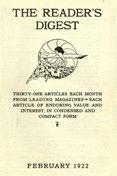
Happy Birthday, Reader’s Digest! I first discovered your wonderful magazine by chance in a hotel reception. Your mixture of content and fascinating articles immediately captivated my attention and I made sure to subscribe to the publication upon returning home.
My very first issue (September 2017) included a revealing interview with Graham Norton. It also featured “On Your Radar”, profiling the interests of your diverse readership, and the “60-Second Stand-Up”, which were both segments I looked forward
to every month.
“It’s a Mann’s World”, ie, Olly Mann’s humorous and relatable observations about his life still continue to entertain me to this day. “If I Ruled the World” is another favourite of mine and proposes some excellent ideas about how we could improve the way we run society.
What I love most about Reader’s Digest is that you frequently introduce new columnists and features, so the magazine always feels fresh and relevant. That’s why it’s stood the test of time and will, undoubtedly, be around for another 100 years!
LUKE ITHURRALDE, Darlington
Reader’s Digest has been part of my family since even before I was born. There is one thing in particular that I learned from Reader’s Digest—to reverse park! I remember reading a little snippet about how to align the car to reverse into a space and to date I do it better—with ease and confidence than most people. Every time I reverse park
into a little space and get it done in one quick step the little diagram from the Reader’s Digest from many moons ago passes through my mind. Who would have thought Reader’s Digest could be a driving instructor! I hope generations will continue to enjoy and learn from RD’s varied articles.
PRI TALWATTE, via email
FEBRUARY 2022 • 7
A NNIVE R SARY ED I TION 100 YEARS
I grew up in Bombay (now Mumbai) in India in the 1980s and Reader’s Digest was a staple in many middleclass households. My aunt had signed up to a subscription when she was a student in the 1960s and her mother, my grandmother, continued it until she passed in 2020. A few times a year, during the summer and Christmas holidays, I’d visit my grand aunt and grand uncle in the suburbs and I’d stay over for a few weeks. They had a book cabinet, which, when opened, contained Reader’s Digest magazines going back years and years. Each day of my holiday there, I’d pull out an issue or two, and after lunch, I’d sit in the cool drawing room—a respite from the hot sun outside—and read the Reader’s Digest. Somehow the unique size, the varied articles and the cool sitting room inside, with the heat outside, lended a warmth and nostalgia to the occasion.
Now that my grandma, my grand aunt and grand uncle—all beloved to me—are no longer alive, memories like this are comforting and feel

unique. This was at a time before mobile phones, before multiple TV channels, the internet… where interesting news about the world was packaged into magazines. Recently I took up a Reader’s Digest subscription in my forties. Seeing the diminutive sized magazine in my home in London allows me to think of reading it in that cool room, the heat outside, in the then quiet Bombay suburb of Santa Cruz, as I looked forward to my grand aunt waking from her afternoon siesta and our holiday activities in the evening. She had no children of her own. My parents weren’t particularly well off, so her love, and the items associated with her home—the modern washing machine, the hoover, the Reader’s Digest—all took on some meaning and represented a break from the stress of school.
Congratulations on 100 years of Reader’s Digest and for the comfort you’ve provided to many—many who have lived full lives and passed; and many who are around and remember.
SORAB SHROFF, London
I first came across the Reader’sDigest magazine when I started work in 1965. The sophistication of the articles paired with the practicality of its writers really impressed me. It had experts giving much needed advice on most essential topics.
While my new colleagues devoured the weeklies, I always absorbed myself in all the features within the Digest’s covers,and nothing has changed in the years since.
If you wish to further your education, you buy the Reader’s Digest. GLORIA
8 • FEBRUARY 2022
OVER TO YOU
WILDING, Prescot
I wanted to drop you a line about a page in your publication that had a very positive effect on me. About 25 years ago, or thereabouts, Reader’s Digest published a page entitled How to Quit Smoking. This one page showed a picture of a clock. On this clock time was divided into (if I remember correctly), 15 minutes, one hour, one day, one week, one year and 15 years. Against each time period was written the positive effect of not smoking had on the body.
I was 34 and old enough to know better than to keep on smoking. This page did it. I got to the 15 minutes without a cigarette, I got to the hour, then the day, then the week and thought to myself, Well that wasn’t so bad; I’ll just keep on going and see how far this gets me. I told myself I hadn’t “given up smoking”, just postponed the next cigarette. My last cigarette was 25 years ago, I cannot begin to tell you the health benefits that has brought me, thanks to the Reader’s Digest.
 ANN TIMLETT, via email
ANN TIMLETT, via email

My first memory of Reader’s Digest is of sitting in the waiting room of our family GP as a very small child in Leeds in the 1950s. There were no appointments, but everyone thumbing the well-worn magazines on the polished table in the centre knew exactly whose turn was next. The wall lights were dim, which made reading difficult, but I loved looking at the pictures. Mum used to give me a Reader’s Digest because it was easy for small hands to hold. I should have loved to take one home with me but was, of course, never allowed. Taking out a subscription would have been well beyond my family’s means in those days, which makes me appreciate even more the one I have now.
MAGGIE COBBETT, Ripon
FEBRUARY 2022 • 9
READER’S DIGEST

I was born in India. My dad was a busy doctor, but the best thing he did was to subscribe to the Reader’s Digest. He didn’t read anything but the Digest and the Illustrated Weekly of India, because he said they were the only classy magazines.
We looked forward to the RD every single month, not because my dad said so, but because we simply loved them. We always called it RD, and not Reader’s Digest.
I was 12 years old when I started reading “Humour in Uniform” and “Laughter, The Best Medicine”. The postman who brought in the Reader’s Digest every month did not, at all, like the day he brought it. My siblings and I used to scare him by pulling it from his hand, ripping the enclosing sleeve off and throwing that back in his bag. We used to grapple and fight for the magazine so much, that he nearly fell off his bike once! Realising what a boisterous set of youngsters he
had to encounter, he soon learned his lesson and always got off his bike before he rang the doorbell, especially on the day the RD had to be delivered!
I came to the UK when I was 13 years old. It was only when I was 17 that I fully understood the humour pages. I have an irritating habit of laughing out loud, which I did, in the wrong places. Once I was travelling to London with my parents. I had the RD with me and I was reading the jokes and laughing out aloud in the train. People were staring at me; my parents were embarrassed, but I was oblivious to all that, and just enjoyed reading my Digest.
Gradually, I started reading all the articles in the RD, and I must say I truly enjoyed reading the magazine from cover to cover. I am now 65 years old, but I have not stopped reading—I even got my own subscription.
Reader’s Digest has changed over the years, but the articles are still great. Now I start with the “Laugh” and “You Couldn’t Make it Up” pages and then read all the other articles—from cover to cover. All I can say is that RD has become a good friend to me. I love it and it has kept me sane all through this pandemic.
SUE SRINIVASAN, via email
10 • FEBRUARY 2022
OVER TO YOU STEPHEN BARNES/BUSINESS / ALAMY STOCK PHOTO
I was first introduced to Reader’s Digest a decade ago. My dear mum was enduring rounds of chemotherapy in hospital having recently been diagnosed with bowel cancer. I used to sit and keep her company in the room while she dozed during the hours spent on a drip.
A fellow patient offered me a copy of Reader’s Digest to browse through while Mum napped and I accepted it reluctantly, thinking it might be a rather dull read for a 30 year old. How wrong I was! The articles were funny, stimulating,
thought-provoking and a much needed and welcome release from our sad reality.
When my mum awoke, I’d read her excerpts. We would discuss interesting articles and have genuine fun jointly completing the puzzles. Reader’s Digest is still a real treat for me to enjoy and brings back fond memories of treasured conversations and special time with my late mum. I am very grateful for the kind person who lent me their copy and a decade on still always look forward to the next edition.
My first copy of Reader’s Digest (May 1952) belonged to my husband and I started my subscription when we bought our first home. My collection is a constant source of reference and joy. Glancing at my Digest bookcases, the variations in covers and styles, quality of print and volume of contents reflect so many changes of editorial tenure. I have always looked forward to each monthly delivery, but never more than during these last 18 months.
Congratulations to the current editorial team and contributors for maintaining the high standards. Long may you flourish.
MARY O’BRIEN, via email

FEBRUARY 2022 • 11 Send letters to readersletters@readersdigest.co.uk Include your full name, address, email and daytime phone number. We may edit letters and use them in all print and electronic media WE WANT TO HEAR FROM YOU!
READER’S DIGEST
PAULA PARKES, via email

12

SEE THE WORLD... turn the page
C o FFRINI/AFP v IA G E tty Im AGE s
Photos: © FABRICE

…DIFFERENTLY
A World Record with an emphatic message for the planet: 125,000 drawings and messages from children around the globe would become the world’s largest postcard! The mosaic seen here covered 2,500 square metres of the Swiss Alps and was laid out in 2018 by activists. It aimed to inspire governments around the world to fight climate change while committing to limit the global temperature increase to a maximum of 1.5° Celsius.

15
Splitting Hairs
This month, Olly Mann gets to grips with a change to his signature hairdo
I’m losing my hair. I mention this not to garner your sympathy; don’t worry, this column will not be an exposition on how distressing it is that my body is succumbing to the ravages of time. It’s just a fact, and, honestly, I’m fine with it.
Don’t get me wrong: had this happened when I was 25, I would have jetted off to an Istanbul clinic with a wallet full of credit cards and a sackful of shoulder-shavings faster than you could say "Elton". I would have had a baseball cap glued to my scalp, like Ron Howard. I would have hired a psychiatrist, put them on speed dial, and shed more tears than

Olly Mann presents Four Thought for BBC Radio 4, and the podcasts The Modern Mann, The Week Unwrapped and The Retrospectors
Gwyneth at the Oscars.
But at 40? I’m fine with it. I’m a married father of two, unburdened by maintaining a Tinder profile. I’m tall, and balding from the top, so everyone who is shorter than me (ie, most people) can’t even see my scalp. Most comfortingly, I cling to the knowledge I had "good hair" for the first 30-ish years of my life. Not stylistically, of course: the hairdos of my school portraits are half Boris Johnson, half Rose West. But hairdressers would always compliment me (I guess because there’s little else to chat about with a fidgety, football-hating boy?) on my "great hair".
“Ooh, isn’t it thick?”, they’d coo, as they hacked through a vast swathe of voluminous curls, making no discernible difference to the aesthetics of my lion-like mane. “I’d kill to have hair like that!”.
My follicles have had a good
illustration by
Daniel Mitchell
16 • FEBRUARY 2022 IT’S A MANN’S WORLD

17
innings, I feel. Once I’d learned which products to use (moisture-rich shampoos, leave-in conditioners) and which to avoid (sun-in hair dye—which makes me go ginger), I even enjoyed my hair’s insistence on defying typical chemical reactions, being always big and brown and bouncy, whether I’d greased it down into a 1950s quiff, or combed it up into a sandy "Jewfro". It had its own personality.
When I was an intern at The Guardian, their design editor at the time, the esteemed Jonathan Glancey, once identified me in the foyer because he’d been told my hair was "pre-Raphaelite" (I took this to mean I looked cultured and classical, rather than medieval).

In any case, it’s thinning really slowly: I’ve probably got another 20 years before I go full Terry Nutkins. Nonetheless, this raises a pertinent question: why am I still spending £50 getting my hair cut?
The answer to this is, I suppose, "habit". But if the pandemic era has taught us anything, it’s that even our fundamental behaviours—such as commuting to work, sending our children to school, or chatting to someone at a party without worrying about death—can be transformed when necessary.
For decades, I’ve frequented salons, rather than barbers; even though, for many years, I lived on
North London's Newington Green—a haven for Turkish toppers whom, I’m sure, could have cared for my curls just as artfully as Toni and Guy. I’d convinced myself I enjoyed the salon: the air conditioning, and the espresso machine, and the seductive smell of ammonia as a neighbouring lady’s beehive is blasted with bleach. I wanted my stylist to be at all times adroitly wielding her scissors, hovering over me studiously, as if sculpting me from ice—rather than hacking through my foliage with vibrating clippers.
But really, all I require these days is a short back and sides. As long as I don’t end up looking like Kevin Keegan and/or Krusty the Clown, the haircut’s a winner. So, for the first time in manhood, I’ve started going to my local barbershop.
And… it’s great! For one thing, you don’t need to book an appointment.
18 • FEBRUARY 2022 IT’S A MANN’S WORLD
I always hated diarising my haircut, as if it were elective surgery. Now I just rock up and take a seat. There are retro film posters on the walls, and vintage leather chairs, and the two guys who run the place are friendly, yet also business-like, and make a really quite decent cup of coffee (which, to be fair, strikes me as a 21st-century development in the world of Hertfordshire barbering, but a welcome one.)
Best of all, the cut costs £15, which means I’m saving… drumroll, please… £200 per year! And my hair looks exactly the same as when it was done in the salon (not that anyone ever notices. The only two comments
I ever get about my hair are either "you need a haircut!", or "have you had a haircut?"; mere estimates of condition, delivered as one might consider the status of a pigeon on the pavement: "is that bird still alive?" or "is that bird dead?" It is of no consequence to anyone else. So why spend the money?).
I’ve even begun to experiment with getting a full wet shave while I’m there. The first time my barber draped a wet towel over my nose and mouth I thought I was being waterboarded, but I’ve come to appreciate the feeling of a freshly-plucked chin.
So yes, my hair is thinning: I am older. But also, I believe, wiser. n
Pucker Up For These Valentine's Kissing Facts
Kissing might help you live longer. A German study found that men who kissed their spouses each morning missed less work due to illness, got in fewer car accidents, earned more money, and lived about five years longer than those who do not.
On average, people spend about 336 hours of their lives kissing.
Thai couple Ekkachai and Laksana Tiranarat hold the world record for the longest kiss, clocking in at a lip-smacking 46 hours, 24 minutes and nine seconds.
Lips are like snowflakes—no two lip impressions are the same.
The Ancient Romans created three categories of kissing: Osculum, a kiss on the cheek, Basium, a kiss on the lips, and Savolium, a deep kiss.
Over 400,000 tourists gather to kiss the Blarney Stone near Cork, Ireland every year, making it the "most unhygienic" tourist attraction in the world.
Source: mentalfloss.com
READER’S DIGEST
FEBRUARY 2022 • 19
Ricky Gervais
“The Point Of Art Is To Make A Connection”
By Vicki Power
As the final series of After Life, the show he has written, directed, produced and starred in, launches, Ricky Gervais explains why it’s still all about the work
Ricky Gervais could well afford to rest on his laurels, with a library of awards and a fortune estimated at more than £100 million. Yet the celebrated writer and comedian says he doesn’t care about the accoutrements of success—all he wants is to push artistic boundaries.
“I don’t want to be bigger or richer or win more awards,” says Gervais, 60. “It’s all about the work. If I can be honest and as brave as I can be in comedy or drama, then I can sleep at night. I’ve never wanted to make it safe or anodyne: there’s enough of that. You know, the point of art is
to make a connection and for me, the bigger the connection with each individual, the better.”
Gervais is talking over Zoom from his home in London’s swish Hampstead neighbourhood, where it looks like he’s sitting in a kind of trophy cavern, a dim space in which those dozens of awards are lined up behind his head. He’s promoting the third and final series of After Life , his smash hit Netflix comedy-drama about a grief-stricken man that he writes, directs and stars in. Gervais has a surprisingly earnest side but also regularly makes jokes at his own expense and bursts into loud cackles of mirth. He’s very easy to talk to.
20 • FEBRUARY 2022
ENTERTAINMENT

21 JOBY SESSIONS/FUTURE/SHUTTERSTOCK
As David Brent in The Office

Making non-anodyne TV is what Gervais has excelled at ever since he burst onto the scene with The Office in 2001, the benchmark-setting cringe comedy that catapulted him onto the world stage. He and cocreator Stephen Merchant followed it up with Extras (2005-07) and Life’s Too Short (2011-13), and Gervais’ solo projects include Derek (201214) and now After Life. He’s made Hollywood movies and continues to do stand-up comedy and podcasts. Shock has been his USP—for starters, he’s skewered A-listers as five-time host of the Golden Globes and he uses the C-word liberally on Twitter and in the scripts for After Life. His fans lap it up. “I think as
creators and broadcasters and producers and critics, we second guess people, saying things like, ‘I don’t know if they can take that’,” muses Gervais. “We cut the crusts off for them. But most people can take it. Like swearing: have you heard what people talk like in real life?! They can take swearing; they can take grief. People want to see themselves.”
They’ve seen themselves in spades in After Life. The series has become a massive hit for Netflix, its second series becoming the most-watched British comedy of the decade with over 85 million views.
“That’s mad, isn’t it?” says Gervais, shaking his head. “The one thing that even surprised me was that I’ve
22 • FEBRUARY 2022
INTERVIEW: RICKY GERVAIS
EVERETT COLLECTION INC / ALAMY STOCK PHOTO
In After Life, which Gervais wrote, produced, directed and stars in

“I DON’T WANT TO BE BIGGER, OR RICHER, OR WIN MORE AWARDS. IT’S ALL ABOUT THE WORK”
never had so many people come up to me and say, ‘I lost my wife’, or their mum or their brother. Because usually they can’t—no one starts that conversation.”
“They want to tell me that story and I encourage it on Twitter. I say thanks for your stories. And my other followers are so encouraging to them. It’s really sweet. It’s lovely.”
What might surprise many about Ricky Gervais is just how nice he
is. For a comedian who made his name playing The Office’s monstrous manager David Brent, you might expect him to be edgier, to be more cynical.
“I think people know that a joke isn’t a comedian’s true feelings,” he says. “I take on whatever view is best for the joke—I’ll pretend to be right wing, left wing, clever, stupid: whatever makes the joke best without prejudice. And I sometimes have to explain irony to people. On
FEBRUARY 2022 • 23
READER’S DIGEST
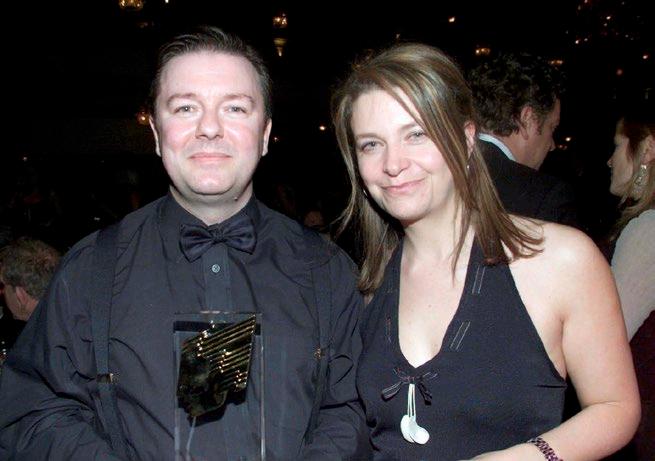
“IT’S SURPRISING HOW POWERFUL IT IS TO JUST SAY SOMETHING NICE TO SOMEONE. IT’S MAGIC”
Twitter, it’s impossible. That’s why I tweet like a 15-year-old girl, so people know it’s a joke.”
With the exception of those who are cruel to animals, his personal bugbear, Gervais is unfailingly kind on Twitter. “We’ve all got the power to be kind,” he explains. “We can make someone’s day by saying, ‘Nice jacket.’ It’s surprising how powerful it is to just say something nice to someone. It’s magic. And that’s the thing with Twitter: people are so
quick to criticise. And it’s trying to raise their own status to bring someone else down. It’s lovely when people are nice, and it shouldn’t be that surprising.” He lets out a bark of a guffaw. “It shouldn’t be surprising!”
That vibe carries into After Life, the most sentimental and heartfelt of Gervais’ projects to date. “It’s always been there,” he says of his sentimental side. “But you get braver as you get older. And you do have to be brave to be honest these days. So
24 • FEBRUARY 2022
INTERVIEW: RICKY GERVAIS
SHUTTERSTOCK
Ricky with his partner Jane at the 2003 Royal Television Society Awards
The couple have been together since their university days

many people go, ‘Oh, I want to be honest, but what if someone doesn’t like it or it makes me look stupid?’ So they’ll just be cynical or ironic. It’s much easier to roll your eyes than it is to cry.”
Gervais says he mined his own experiences of grief to understand Tony’s predicament. “We’ve all grieved a loss,” he says. “I’ve lost both parents and a sibling [his eldest brother Larry died in 2019, aged 75] and all my pets and friends and all that. But yeah, I think that, obviously, the ultimate [loss] is your soulmate, so I have to imagine that.” His own soulmate is Jane Fallon, 61, a TV producer-turned-novelist who’s been his partner since they met at
University College London in 1982.
Gervais depicts Fallon as the sensible one, calming his anxieties. Asked if he’s had any COVID-related health scares, he responds: “Every day I have a health scare—I’m a hypochondriac! If I get a sore throat, I go, ‘That’s cancer’. There’s always something. Jane’s used to it now. I’ll go, ‘My heart rate’s up’ and she’ll go, ‘You just had three coffees’. I’ll be like, ‘Oh, yeah’”. He guffaws loudly at his foibles.
Their favourite joint pastime is watching foreign TV dramas—he avoids the “bad acting” he sees on UK TV. “Not only do we not watch British TV, we don’t watch anything in English,” he says. “Scandi and
FEBRUARY 2022 • 25 READER’S DIGEST
PA IMAGES / ALAMY STOCK PHOTO

European dramas take more chances with the pacing, the subject matter. Nothing’s episodic or procedural or formulaic. Although obviously we’re getting the best programmes from each country in the world, their greatest hits.”
Despite Gervais’ prodigious work rate, he claims he is essentially a pleasure-seeker, and that even as a kid in suburban Reading he understood that money can’t buy you happiness.
“I remember when I was ten, there was a time when they were using labourers to go on oil rigs and they were earning £1000 a week,” he says. “And I remember the teacher asked
the class what we’d do with £1000 a week. The other kids said they’d buy a house or a pony. And they came to me and I said, ‘I’d work one week a month.’” I knew even then that the important thing was enjoying life.”
“You can have all the money in the world, but you can’t buy time. And I’ve always known that.”
It’s been on his mind since he turned 60 last June. “I look at it like this every day: this is the best you’ll ever be,” muses Gervais. “Every day I have now is a bigger percentage of the rest of my life. Time is more and more important. I ache more because I don’t want to give anything up. I play tennis and I can’t walk for a day, but that’s no reason to not
26 • FEBRUARY 2022
INTERVIEW: RICKY GERVAIS
After Life
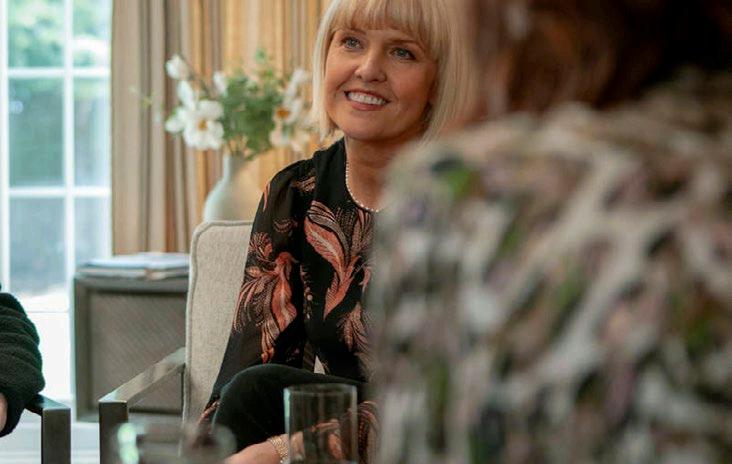
“YOU CAN HAVE ALL THE MONEY IN THE WORLD, BUT YOU CAN’T BUY TIME. AND I’VE ALWAYS KNOWN THAT”
play tennis, or I go for a run and my knees and my ankles hurt, but that’s no reason not to go for a run. I do everything I want to do. I’m like an old car. I’m going to drive where I want, and then when it stops, I’m just going to leave it there.”
Before our time is up, I mention that he’s the cover star of Reader’s Digest’s 100th anniversary issue and ask him about his memories of the magazine growing up.
Gervais thinks for a minute. “I’ve probably only got bad associations with Reader’s Digest because I associate it with going to the dentist,” he says with a giggle. “They had it in the dentist’s waiting room. I associate it with my worst two days of the year, my six-month check-up, so it probably fills me with fear.”
“But happy anniversary”’ he adds. “Here’s to another 100 years.”n
After Life launches on January 14 on Netflix
FEBRUARY 2022 • 27 READER’S DIGEST

ENTERTAINMENT 28

I REMEMBER… Richard Carpenter

As the Carpenters, Richard Carpenter and his sister Karen were one of the most successful pop duos of all time. Now 75, he looks back on their career, celebrity fans and the devastating loss of his sibling
GROWING UP IN CONNECTICUT, I would listen to all the 78s my parents bought for me to play on my Bing Crosby Junior Juke record player. It looked like a miniature version of the old Wurlitzer jukeboxes and I especially remember playing Spike Jones and The City Slickers over and over. They were vinyl 78s rather than the usual shellac, although my dad had a huge library of the latter.
REUTERS / ALAMY STOCK PHOTO
FEBRUARY 2022 • 29

DAD OPERATED A FIVE-COLOUR PRINTING PRESS. It was so big that you had to climb up to get to its second storey. And Mum was a homemaker. They were great parents. They were honest as the day is long, they were hard workers and generous to a fault. I inherited my love of music from Dad and his record collection, and Mum had a nice alto voice and would sing along to the radio in the kitchen.
I WAS FOUR WHEN MY SISTER KAREN CAME ALONG and I wasn’t too happy about it at first. I guess I’d gotten used to my little existence in my cocoon, then along comes this new baby to disrupt things. But as
we grew older Karen and I became fast friends and we enjoyed all the same things—the same music, the same type of comedy, everything. We got along wonderfully.
I STARTED PLAYING PIANO AT A YOUNG AGE, studying technique and the classics with one teacher and learning to read chords and arranging them with another teacher. By the time I was 16 I was quite proficient and could play by ear so if someone asked me to play, say, “My Melancholy Baby” I could. I looked and played a little beyond my years—I had glasses and my hair was slicked back—and I taught piano as well as earning extra dough by
30 • FEBRUARY 2022
Richard with his mother and baby sister

playing dives at weekends with a couple of older friends.
WHEN I STARTED WRITING MY OWN SONGS I’d ask Karen, who was already a gifted drummer, to sing them and at first she sang in an upper register, like a falsetto. It was in-tune but there was nothing special about it. Then when she was around 15 the lower voice—the voice— started to show itself. By the time she was 17 it was fully there and had she had a recording contract, a producer and the right song she’d have had a hit record right then.
WE FORMED THE RICHARD CARPENTER TRIO IN 1965 with
Karen on the drums, myself on piano and my college friend Wes Jacobs on tuba and bass. The next year we won the Hollywood Bowl Battle of the Bands and got to record three songs, then we added a few more people to the line-up and became Spectrum followed by Summerchimes but it never sounded quite the way I wanted. Then I got the idea that Karen and I could overdub all the parts and that’s how Carpenters was formed as just the two of us.
HERB ALPERT SIGNED US TO A&M RECORDS after hearing our demo tape in 1969 and he said, “Let’s hope we have some hits.” Our first album Offering wasn’t a hit at all but A&M
FEBRUARY 2022 • 31
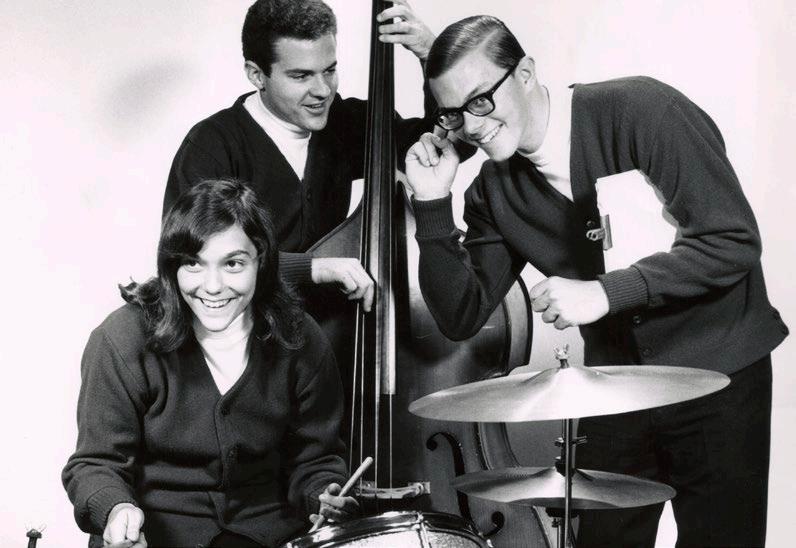
was famous for letting all acts on the label have artistic freedom and Herb gave us carte blanche. When we recorded Burt Bacharach and Hal David’s “(They Long To Be) Close To You” it went to number one in the States and luckily we were able to follow it up with other hits. I also received the greatest compliment when Burt Bacharach said in an interview of my arrangement, “Richard Carpenter not only got it ten times better than I did, he got it 11 times better than I did.”
IT’S NOT TRUE THAT WE WERE TOLD not to do anything to tarnish our clean-cut image. The label was going through a bad time in the late
1960s and they were looking for something a bit harder-edged but weren’t having much luck. Then we came along and gave A&M a major shot in the arm but a lot of people there—although not Herb—wanted to see the back of us. We were golden geese but they wanted something with edge and we didn’t have edge except in the sales department.
MEETING PRESIDENT NIXON WAS A GREAT HONOUR.
We were on a summer tour in 1972 and appearing just outside Washington when we got a message that the President would like us to drop in and say hello. We were on the road and I hadn’t packed a suit and tie but
32 • FEBRUARY 2022

they were like, “Just come as you are.” So we did, he was very pleasant, we took a picture or two, and that was it until a year later when we were asked to play for West German Chancellor Willy Brandt at a state dinner. We were in the East Room of the White House, which is enormous, and the acoustics were incredible—so much so that we had to play as quietly as possible.
VICTOR BORGE WAS A DREAM GUEST ON OUR FIRST TELEVISION SPECIAL. He was such a delightful guy and really talented. Another career highlight was opening for the comedian Don Adams of Get Smart fame in Las Vegas, after which we
headlined Vegas ourselves. And we got to meet so many amazing people over the years, like Paul Simon and Art Garfunkel, John Lennon, Paul McCartney, too many to name in fact.
I BECAME ADDICTED TO QUAALUDES without knowing they were a party drug. I had been taking them for what they were intended, namely as a sleeping pill, but they eventually took their toll and I had to check into rehab. Looking back at it now I was ahead of the curve because that was in 1979 before rehab was considered part of an artist’s resume. For the first several weeks it was really difficult but
With President
FEBRUARY 2022 • 33
Richard Nixon
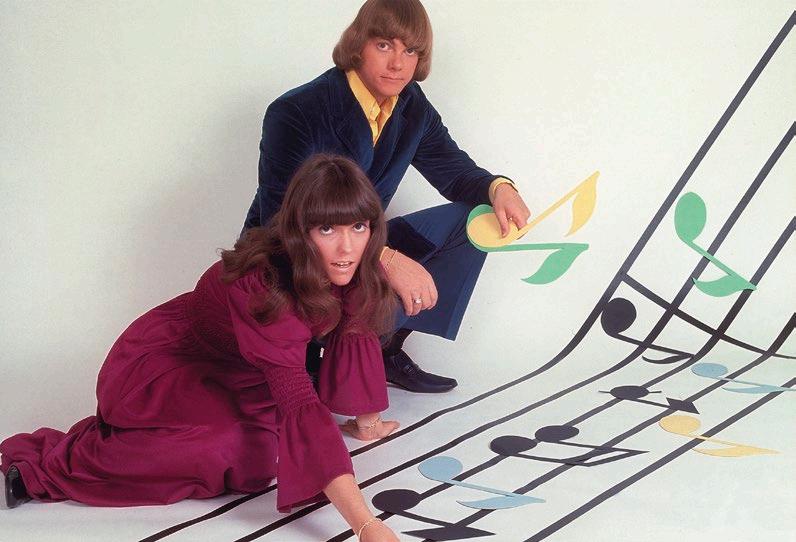
I made friends in there and by the end of the six-week programme we were having a great time.
LOSING KAREN WAS ABSOLUTELY DEVASTATING [She died in 1983 after a battle with anorexia]. I got through it as best as I could, by keeping myself busy working on some tracks which we hadn’t finished but where we had her vocals. Her scratch vocals were every bit as the masters so I was able to release new Carpenters music and work on various compilations to keep her legacy alive. It’s remarkable because our records continue to sell around the world in great numbers.
MY WEDDING DAY WAS MARVELLOUS EXCEPT FOR THE HEAT. Mary and myself got married in 1984 in the church where I’d been a part-time organist in Downey, South East LA, when I was 16. I played at a number of weddings for easy money and even though I’m not in the least bit religious, when the time finally came for Mary and me to get married, it seemed like a nice place to do it. The trouble is, back then at least it didn’t have air conditioning and our ceremony was in May in the middle of a heatwave. It was hot as blazes and when you look at the video all the guests are waving fans to try and keep cool.
34 • FEBRUARY 2022

BEING TOLD BY EVERYONE FROM THE TEMPTATIONS TO ALICE COOPER that they were Carpenters fans is both thrilling and surprising. Frank Zappa was another surprise fan. It’s funny but because of our image from the 1970s onwards it was almost like it had to be put in a paper bag, you know? Like they loved the music but they were afraid to say anything so they bought the records and hid them in a paper bag. But after 50-something years I guess it’s OK to like us now.
WRITING A BOOK HAS BEEN A NICE TRIP DOWN MEMORY LANE. It’s tilted to be more about the music than a regular biography,
even though the chaps who cowrote it with me (Mike Cidoni Lennox and Chris May) know more about our achievements than I do. My parents and I saved everything we could that had to do with the Carpenters and 20 years ago I filed it all away, thinking, Why am I doing this? It’s never going to be needed . Then the idea for the book came up and I had all sorts of stuff that they could pull out and use. n
As told to Simon Button
Richard Carpenter’s Piano Songbook is out on CD and vinyl from January 14. The book Carpenters: The Musical Legacy is out now
FEBRUARY 2022 • 35

36
A WORLD OF
Compounding crises have made everyone anxious, but how do you know if you’ve slipped into a more serious disorder— and what do you do about it?
BY Rebecca Philps
illustrations by pete ryan
HEALTH 37
Five years ago, Meredith Arthur, a 45-year-old San Francisco employee of the social media company Pinterest, arrived at a neurologist appointment in a distraught state. She spoke a mile a minute, rattling through her extensive research on the vagus cranial nerve and explaining why she thought it might hold clues to her crippling shoulder and neck pain, frequent dizziness and nausea and chronic migraines. “I was presenting my inexpert case to an expert, and she stopped me and said, ‘I know what’s wrong. You have generalised anxiety disorder.’”
For Arthur, the diagnosis was a shock. She had been so focused on her debilitating physical symptoms that she hadn’t considered that they could be linked to her mental health.
But almost immediately, it clicked.
“My brain was always in overdrive, from early childhood,” Arthur recalls. “I always wanted to work really hard all the time and solve everything.”
She would have never described herself as a worrier, however, and certainly didn’t connect her perfectionism to anxiety or its impact on her body. But in fact, physical discomfort (like stomach and chest pain, feeling restless or irritable, sleep problems, fatigue and muscle aches) is most often what drives people with anxiety to seek treatment, not distressing thoughts.
“The diagnosis changed everything,” says Arthur. “It’s like somebody picked me up off the earth, turned me around 180 degrees and put me back down. It was the same world, but everything looked a little different.”
Arthur is one of the 44 million North American adults who experience an anxiety disorder—the most common form of mental illness—every year. But beyond serious cases, anxiety is something that touches everyone to varying degrees. Typically, it’s intermittent and brought on by a stressful or traumatic event. The core features of anxiety are excessive fear and worry— followed by extreme problem solving, in Arthur’s case—and one of the major underlying factors is a feeling of uncertainty about situations that occur in daily life.
38 • FEBRUARY 2022 A WORLD OF WORRY
Enter big, bad 2021. These are exceedingly anxious times due to the unholy combination of economic precariousness, social unrest, political volatility, environmental catastrophes (pause: deep breath) and the COVID-19 pandemic. But an individualised, holistic approach to managing anxiety—including lifestyle tweaks, medication, mindfulness exercises and, to begin with, acceptance—will ensure it doesn’t rule your life.
What Anxiety Does to Your Body
Anxiety is part of your body’s stressresponse system—and it’s uncomfortable, overwhelming and sometimes plain confusing.
“I describe anxiety as a futureoriented emotional response to a perceived threat,” says Dr Joel Minden, a clinical psychologist and the author of Show Your Anxiety Who’s Boss. “We anticipate that something bad will happen. Maybe we have evidence for thinking that. Maybe we don’t. But we have a belief that something catastrophic might occur.”
Almost immediately after that, Minden says, your sympathetic nervous system, which controls involuntary processes like breathing and heart rate, kicks into high gear. This leads your adrenal glands to release adrenalin and cortisol, two of the crucial hormones driving your
body’s fight-freeze-or-flight response, which prompt anxiety’s physical symptoms. Your heart races, your blood pressure rises, your pupils dilate, you get short of breath and you break out into clammy sweats.
Meanwhile, cortisol curbs functions that your brain considers nonessential: it alters immunesystem responses and suppresses the digestive system, the reproductive system and growth processes. This was perhaps helpful for our ancestors trying to outrun a sabre-toothed tiger, but not so much when you simply walk past someone in a supermarket and, even though you’re both wearing masks, can’t stop ruminating for days afterward about whether you might have caught COVID-19 when they coughed.
“The physiological sensations you get make sense when you’re in danger,” says Dr Melisa Robichaud, a psychologist and clinical instructor in the University of British Columbia’s psychiatry department. “But they feel odd and sometimes quite scary when there’s no physical threat.”
Everyday Anxiety or an Anxiety Disorder?
For Arthur, chronic physical pain and discomfort were the most powerful manifestations of her disorder, but anxiety can show itself in many ways. You might perceive something as threatening, even when it isn’t, or go
FEBRUARY 2022 • 39
READER’S DIGEST
to great lengths to avoid uncomfortable situations. You might constantly overthink plans or spend all of your time creating solutions to worst-case scenarios that are unlikely to happen. Maybe you’re indecisive and fear making the wrong decision. Or you might find yourself unable to relax and feel restless and keyed up.
Often, those symptoms last only as long as a certain situation or problem is present (you may feel nervous about flying, but you do it and the feeling fades when the wheels touch down). But sometimes anxiety can tip into a chronic anxiety disorder. These include generalised anxiety disorder, but also panic disorder, social anxiety disorder, obsessive-compulsive disorder, posttraumatic-stress disorder and phobias. People with an anxiety disorder can also suffer from depression—and in fact, some estimates show that 60 per cent of those with anxiety will also have symptoms of depression.
The distinction between circumstantial or temporary anxiety and a more severe case isn’t always easy to make, says clinical psychologist Dr David Carbonell, founder of the Anxiety Treatment Centre in Chicago.
“There isn’t a blood test for anxiety. At some point, everybody experiences it,” he says. “It becomes a disorder when it interferes with your behavioural choices and your ability to do as you wish in life.”
For instance, that point could be
when your job requires you to fly, but you’re too anxious to even make it as far as the airport, which ultimately puts your livelihood in jeopardy. Or, more generally, when you find that anxious feelings last for a long time, beyond when a problem has passed or been resolved, and they seem to jump from one situation to the next without relief.
Despite the fact that chronic anxiety is very manageable with professional help—and some combination of medication, therapy and lifestyle adjustments—only about 37 per cent of affected people receive treatment of any kind. “I always say that I have a really good job because I specialise in treating people who have anxiety disorders,” says Robichaud, “and by and large, most everyone I see gets better.”
How to Treat an Anxiety Disorder
1. ACCEPT IT Just like happiness and sadness, anxiety is part of everyone’s lived experience—but it’s not always tolerated as such.
“People spend too much time and effort on trying to control anxiety,” says Minden. “I encourage them to remember that anxiety is a normal emotional response.” If you try to banish it, he adds, all you’re doing is putting it more at the forefront of your mind. But if you accept anxiety as part of life, you can learn to relate to it with
40 • FEBRUARY 2022
A WORLD OF WORRY
THERE’S NO SHAME IN TAKING MEDICATION
Many people avoid taking, or even looking into, medication for anxiety because of the stigmas associated with psychiatric drugs. They may worry about dangerous side effects, that they’ll become dependent on them or that loved ones will see them as weak or flawed.
But the fact is, modern pharmacological treatments for anxiety disorders are safer and produce fewer side effects than they did 30 years ago. At the same time, attitudes toward mental illnesses are improving: a 2019 survey by the American Psychological Association found that 87 per cent of adults agreed that having a mental-health disorder is nothing to be ashamed of.
If you’re ready to explore medication, Dr Debra Kissen, CEO of Light on Anxiety CBT Treatment Centre, suggests talking to a primary care doctor, who can prescribe the medications most commonly taken for anxiety.
Selective serotonin reuptake inhibitors (SSRIs) are considered a good starting medication for many forms of anxiety. Serotonin is a neurotransmitter that plays a role in feelings of well-being and happiness, as well as
thinking, memory, sleep, digestion and circulation. SSRIs increase levels of serotonin in the brain and are considered non-addictive and safe for long-term use.
Another choice is benzodiazepines, or “benzos,” which strengthen the effect of the neurotransmitter GABA— the primary inhibitory (“turn off”) signaller in the brain. Benzos are fastacting and don’t stay in your system for long, but they are considered unsafe for continuous use and are potentially addictive.
Kissen believes therapy is still crucial because the gains are hardwired into your brain. For moderate to severe anxiety, combining therapy with medication is generally the most impactful. “It’s a one-two punch where the medication is setting up the environment of your brain to make the most rapid gains as you’re doing the work of learning new ways of looking at situations,” says Kissen.
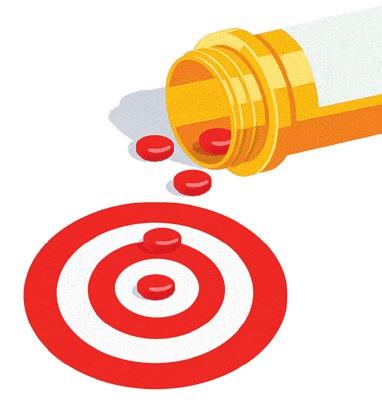
READER’S DIGEST
self-compassion or even with humour. This is a cornerstone of acceptance and commitment therapy (ACT), which has been gaining clinical validation, including by the American Psychological Association.
ACT guides people to see their unpleasant emotions as just feelings and to accept that parts of life are hard. Practitioners encourage patients to begin a dialogue with anxious thoughts, examining their causes while also keeping in mind their personal goals and values. Although anxious thoughts shouldn’t
NOTING PHYSICAL SENSATIONS OF ANXIETY ALLOWS YOU TO BE LESS CAUGHT UP IN THEM
be completely suppressed, sufferers can deliberately not allow anxiety to decide what gets their attention or turn them away from what they want to do and who they want to be.
This way of relating to anxiety has been a powerful strategy for John Bateman, the 52-year-old host of the podcast Our Anxiety Stories . When negative or irrational thoughts arise, he acknowledges them but doesn’t let them drive his decisions.
Over the years, Bateman has
noticed that if he acquiesces to his thoughts, they don’t go away but dramatically increase. But if he recognises them for what they are, just a passing thought and not a fact that needs to be acted on, they diminish. Since beginning to train his brain to think in this new way eight years ago, he’s noticed that the negative thought patterns have lessened. “I discovered that my brain is this amazing, elastic thing,” he says.
2. BE CURIOUS ABOUT IT
After acceptance, a mindfulness approach to anxiety can be useful, especially when you’re cycling through anxious thoughts and are unable to think clearly or rationally.
In his book Unwinding Anxiety, psychiatrist and neuroscientist Dr Judson Brewer recommends paying attention to the body sensations, thoughts and emotions that come as a result of feeling anxious or worried. When we notice and name the physical sensations that are arising in our bodies (my face feels hot and flushed; my breathing is shallow; my heart is beating quickly; I feel sweat prickling my underarms), we are already less caught up in it, simply through that act of observation, writes Brewer.
Many mindfulness training apps can provide you with help, including one that Brewer developed in his lab at Brown University and shares a name with his book. After three
42 • FEBRUARY 2022
A WORLD OF WORRY
months of using the app, a test group reported a 57 per cent reduction in their anxiety.
Understanding exactly what was happening inside her body and bringing her awareness to it was an empowering tool for Arthur. When she’d notice the shaky feeling in her chest or belly that radiated out to her hands and down her legs, she knew that meant adrenalin had been released. And by noting these changes as an observer, her “thinking brain” could take over from her immediate fight-freeze-flight reaction to an anxious moment—and as she began processing what just happened, her symptoms became less acute and threatening. She pictured the hormones hitting her body the same way an ocean wave hits the beach. The beach can’t fight the wave, but it remains steady and allows the wave to wash over and fall back.
3. MAKE LIFESTYLE ADJUSTMENTS
Learning to live with anxiety is an individual process, and one that requires trial and error to get just right. While acceptance is the first and most important step to take, some lifestyle changes have been
proven to take the edge off, as well.
Since fatigue and increased tension and stress leave us more vulnerable to anxiety, a well-balanced diet, adequate rest and, especially, regular exercise can help us manage it better. In one study, researchers showed that regular vigorous workouts lead people to be 25 per cent less likely to develop an anxiety disorder or depression over the next five years.
Meredith Arthur’s toolkit consists of medication—a prescription SSRI antidepressant—and regular meditation. She also shares her experiences on and edits stories about mental illness for the web platform Medium and recently wrote Get Out of My Head, an illustrated guide on how to understand anxiety and learn to navigate problems without overthinking.
Openly discussing the condition with an online community and readers has transformed her relationship with anxiety. “I’m learning to live in harmony, as much as possible, with this thing that is a part of me,” she says. “It’s not always pleasant, but I’m learning to accept and, as much as I can, take care of my anxiety.”
Crazy for Columbo
The classic detective series Columbo was so popular in Romania that when new episodes stopped being made, suspicious citizens thought the goverment had cancelled the show because of import quotas. Columbo's star Peter Falk was called in to make a public service announcement explaining the real reason behind the show's demise
READER’S DIGEST
FEBRUARY 2022 • 43

Put The Sizzle Back In Your Sex Life
There are lots of reasons couples make love less often— but many of the issues, both emotional and physical, can be overcome

Susannah Hickling is twice winner of the Guild of Health Writers Best Consumer Magazine Health Feature
Take time to talk Sex is all about communication, so make sure you actually speak to each other. It’ll help you get close and stay close. Set aside 15 minutes, preferably every day, when you can chat about anything other than children, work, money and other matters that are guaranteed to be a massive turn-off. Talk about the dream you had last night, an article you’ve read, that lovely neighbour you saw. Let your partner do the same. Tell your partner two things you love about them. Respect and mutual affection are a strong foundation for an active sex life.
Check your meds Guess how many medicines cause problems getting an erection or mustering interest in sex. Give up? It’s more than 200, including
HEALTH 44 • FEBRUARY 2 022
some blood pressure tablets, heart pills, anti-depressants, and drugs for stomach problems and an enlarged prostate. So, if you’re concerned that your meds are spoiling your fun, ask your pharmacist or GP. You may be able to change the brand, dose or timing, but don’t stop taking them on your own initiative.
Ditch bad habits
Smoking can diminish your libido and your performance. It fills your body with carbon monoxide, which reduces the production of testosterone, the hormone mainly responsible for sex drive in both men and women. It’s also thought nicotine can have a negative effect on your ability to get turned on. Alcohol is a party-pooper too—“brewer’s droop” is actually a thing, while women might have lubrication problems or inability to orgasm. Giving up smoking and cutting alcohol to the recommended 14 units will help your health and your sex life.
Gents: seek help for erectile dysfunction Emotional problems can stop you getting an erection, but so can common medical conditions, including clogged arteries, heart disease, high blood pressure and diabetes. Being overweight can cause trouble too. The sooner you see your
doctor, the sooner you can get to the root of the issue and find a solution.
Ladies: do your pelvic floor exercises Stop sniggering—exercises to strengthen pelvic floor muscles really do work on several levels. Not only do they tighten muscles “down there” after childbirth and help prevent incontinence, but they also tone the pubococcygeus muscle, essential for orgasm. To do pelvic floor—or Kegel—exercises, contract the muscle you use to stop urinary flow and gradually release it. Build up to 20 contractions three times a day.
Get physical Exercise has been shown to lift libido. Any activity— whether it’s running, cycling, brisk walking or a team sport—that raises your heart rate and leaves you puffed can boost blood flow, including to your sex organs. Men get stronger erections and, according to a study, women get more sexually aroused.
Have sex tonight
It’s true—the more you get it, the more you want it. Making love regularly increases the production of testosterone. n
For more weekly health tips and stories, sign up to our newsletter at readersdigest.co.uk
FEBRUARY 2 022 • 45
TELL YOUR PARTNER TWO THINGS YOU LOVE ABOUT THEM
Milking It
Supermarket shelves are stocked with a dizzying array of the white stuff, both dairy and non-dairy.
How to choose?
Cow’s milk Dairy milk is what most of us still pour on cornflakes and into our tea and coffee. Packed with protein—necessary for energy and overall health—and calcium, which builds stronger bones, it’s part of a balanced diet. The downside is it’s full of fat.
To get around that, choose skimmed or one per cent milk— you’ll get the same levels of nutrients. In fact, skimmed milk contains slightly more calcium than whole fat milk.
might help lower cholesterol. But it’s lower in protein than cow’s milk.
Almond milk This drink is low in calories and saturated fat, and high in vitamin E, important for healthy skin and eyes. On the other hand, it has a very low protein content and doesn’t offer the same heart-health benefits as actually eating a handful of almonds.
Soya milk If you want a plant-based drink that’s similar nutritionally to dairy milk, then soya milk is probably your best choice. It has plenty of protein, and studies have shown soya protein may lower cholesterol. It’s lower in saturated fat and calories than milk, but doesn’t offer the same calcium content, unless fortified.

Oat milk This is the most popular of the plant-based milk substitutes, which are drunk by vegans, people with a dairy allergy or intolerance, and sometimes out of simple preference for the taste, though you should always buy unsweetened versions. Oat milk has a lot going for it: it’s low in heart-harming saturated fat, high in fibre and calcium, and
Rice milk It’s very low on fat, especially saturated fat, but unfortunately contains paltry amounts of protein. It also has more natural sugars than other plant-based drinks.
Other options Made from yellow split peas, pea milk is good from a protein point of view, but some people might be allergic. Hemp seed milk is low in calories, carbs and saturated fat, but also low on protein. Coconut milk contains little protein and is high in fat, especially saturated fat. n
HEALTH 46 • FEBRUARY 2 022
Ask The Expert:
Tinnitus
Philip Robinson is an ear nose and throat (ENT) surgeon at University Hospitals Bristol and founder of the Bristol Tinnitus Service

How did you become an expert in ear problems? As a medical student I decided to become a surgeon. I enjoyed looking after children and ENT meant I could treat both adults and children. I was lucky enough to get a training programme at the Royal Ear Hospital in London and later did some research into inner ear function at the University of Michigan.
How common are noises in the ear and what causes them? About ten per cent of adults have some tinnitus and referrals have doubled since lockdown, mostly due to health anxiety. There’s frequently underlying hearing loss and usually a trigger— further hearing loss, an ear infection, sudden loud noise, neck problem, teeth grinding or anxiety. Other people have no hearing loss but have a neck or jaw problem, or stress.
What forms does tinnitus take? Generally, it’s like a hiss, buzz,
rushing or ringing. If it’s bilateral, it’s nothing to worry about. If it’s unilateral or pulsates like a heartbeat, it should be investigated. Rarely, it could be caused by the narrowing of a blood vessel or an acoustic neuroma, a benign growth on the balance nerve.
When should people worry? They shouldn’t. It’s very, very rarely likely to be serious. Seek medical help urgently if you suddenly get tinnitus and lose your hearing at the same time, sudden tinnitus with severe, persistent vertigo, or sudden tinnitus with neurological symptoms, such as headache or facial palsy.
What can people do to manage tinnitus? In the vast majority of cases it improves with time. If it doesn’t settle, then it’s best to seek a medical opinion. Treating an obvious problem like an infection or wax can often cure the tinnitus.
To dissolve wax, buy yourself some sodium bicarbonate drops from a pharmacy. If the cause is musculoskeletal, see a physio or, if it’s your jaw, a dentist. When it’s down to persistent stress, relaxation techniques and mindfulness can often be of help in solving the problem. n
For more information, visit tinnitus.org.uk
FEBRUARY 2 022 • 47
A Voice In The Dark
A seemingly unresponsive patient creates some career-changing questions for Dr
Max
In my first year as a junior doctor I worked on a stroke ward. It was a dynamic, cuttingedge unit with close links to universities and actively involved in research. A stroke is usually caused by a blood clot in one of the blood vessels in the brain—similar to how a heart attack is caused by a blood clot in the blood vessels supplying the heart. The parts of the brain downstream from the clot don’t get enough fresh, oxygenated blood because of the blockage and start to die. The unit pioneered the idea that if someone was treated quick enough with clotbusting drugs, then the damage from the stroke could be limited. This is now widely accepted with rapid-response stroke treatment units in many hospitals, but at the

Max is a hospital doctor, author and columnist. He currently works full time in mental health for the NHS. His new book, The Marvellous Adventure of Being Human, is out now
time, this was quite a novel and revolutionary idea. People were given intense treatment with drugs and physiotherapy in an attempt to minimise disability.
It was an exciting place to work. But there was a part of the ward that was reserved for those patients for whom no recovery was possible. Their strokes had been so catastrophic that there was no hope of improvement. Outside of the stroke ward, I sometimes heard it cruelly called “the cabbage patch” by other doctors, because these people were considered little more than vegetables. This always struck me as in very bad taste, but I understood that it was a misguided attempt to deal with the bleak situation these patients were in. One such patient was Mr Roberts. He was in his fifties and had been brought in after a terrible stroke which had left him entirely paralysed. He had been standing on the golf course one minute and the next, had collapsed. In that moment, his life changed forever. He could not communicate
48 • FEBRUARY 2022 HEALTH

at all and it was assumed he was effectively brain dead. The doctors discussed the very poor prognosis with his wife over his motionless body, as though he wasn’t there. She sobbed as they explained there was little hope for him and he would be like this until he likely succumbed to an infection and died.
Later that day I returned to take some blood from his lifeless arm. His head was on one side and as I knelt down I met his gaze, there seemed to be some sort of look.
It was as though he was pleading with me to do something. It was horrifying and it has preyed on my mind far more than any of the deaths I have witnessed while a doctor.
I instinctively held his hand and
looked into his eyes and smiled as warmly as I could and spoke to him as I took his blood, just in case.
The idea that he was trapped in there, a living hell on earth, haunted me until he died two weeks later. It had a profound effect on me and from then on, I have never spoken about an unconscious patient in front of them again. I always introduce myself and explain what I am doing, just in case there is part of them that is still aware. And years later, when my gran was lying dying, utterly unresponsive, I still spoke to her, reassuring her that I was there, for hours until she died, just in case there was some part of her that was conscious and scared or confused. In matters like this, you just never know. n
FEBRUARY 2022 • 49
The Doctor Is In
Dr Max Pemberton
Q: I’ve noticed narrow white lines appearing on my nails. They only appear on my thumb, and are worse on the left one. Aside from this my nails seem fine. Any idea what these are? Or how to reduce them? -
Bill
A: Dear Bill, you might be surprised to hear that one of the first things you are taught at medical school is to look at a patient’s nails. This is because while a change in colour, texture or shape can be harmless, it can also be a sign of disease. A lot of medical conditions involve changes to the nails in one way or another. Psoriasis, for example, can cause yellowishorange spots, called salmon patch dyschromia or “oily drop” sign. A nail that lifts up (the medical term is onycholysis) can be a sign of fungal infection. Pits in the nail can be a sign of certain types of arthritis. Spoon shaped nails (called koilonychia) can mean someone has a problem with their stomach or intestines, or sensitivity to gluten (coeliac disease). Yellow nails can be a sign of lung disease, as can bulbous shaped nails (called clubbing). Red lines, called splinter haemorrhages, can be a

sign of kidney disease. The list of “nail signs”, as they are called, goes on and on. The problem is that they’re often not very specific—they can indicate a number of conditions so you can’t make a diagnosis from the nail alone. It does, however, sometimes help combined with other symptoms. So in general, it’s always worth showing nail changes to your GP. In your case, I suspect you have “Beau lines”. These are lines or grooves that run the width of the nail. It means that something temporarily stopped or slowed your nails while they were growing. As this part of the under-grown nail grows, we notice it, as it moves out of the nail bed and on to the exposed nail we can see. A lot of things can cause these—fever, pneumonia, problems with circulation, or chemotherapy, but so can simple, local injury to the nail bed, which we’re often not even aware has occurred (or we forget about because of the time it takes for the nail to grow). It’s worth showing them to a GP who can reassure you. n
Got a health question for our resident doctor?
Email it confidentially to askdrmax@readersdigest.co.uk
HEALTH
illustration by Javier Muñoz 50 • FEBRUARY 2022

Just Cycle And fold away
There’s no excuse not to get on your bike this year. Get your indoor cycling fix and feel the benefits.
Great for general cardio fitness, exercise bikes can be a brilliant way of training at home. However, choosing the right bike is incredibly important, which is something that Roger Black and his team recognised when creating the Roger Black Folding Exercise Bike.
“Best Present EVER are the words from my 77-year old father who received his Roger Black fitness bike for his birthday. He said it is so simple and easy to use, with no complicated gadgets. The seat is VERY comfortable, so using it everyday is a pleasure. It folds away neatly so it can be stored behind a door if need be”
Anna, Farnham
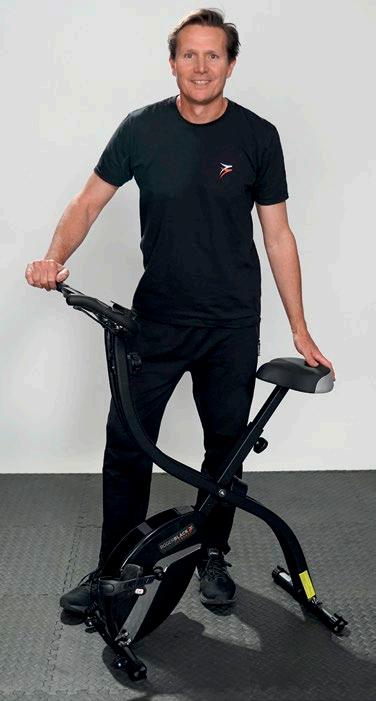

Roger Black is o ering a 10% discount on the full www.rogerblackfitness. com range of home fitness equipment for all Reader’s Digest readers. Please use discount code ‘DIGEST10’ at checkout. Standard T&Cs apply

Get Together, Remember More!
Teamwork makes brains work better, says our memory expert, Jonathan Hancock
New research shows that being part of a team has remarkable benefits for recall. But you’ll know that already if you’ve ever watched University Challenge. Every week the contestants perform amazing feats of memory. First, they work independently, racing to buzz in and solve the “starter for 10.” As we all have to do several times every day, they search their memory banks in solitary silence. But then one team gets to work together. They can confer before answering. And that’s when we see how much it helps to flex our memory muscles with others.
It’s partly common sense. In the team round, there’s less individual pressure, more time to chew over each question, and the players can consider several possibilities before giving their final, group response.
But there’s even more going on according to Canadian researchers, who’ve shown that our brains get a natural boost when they’ve got company. The study suggests two reasons why. First, when we’re with people who are trying to remember something, we can easily “catch” that
tip-of-the-tongue feeling—and so we eagerly join in with the challenge at hand ourselves.
Second, believing that others are close to remembering something boosts our confidence that we can get there too.
And you don’t have to go on University Challenge to experience these effects. Here are three ways that we can all tap into the power of team learning.
• Share the memory load. Many couples and families do this naturally. Your partner may remember birthdays, for example, while you’re in charge of remembering bin day. Having a “recall responsibility” can be motivating, and give you the confidence you need to succeed.
• Reminisce in a group. Use the “contagion” effect in teams to awaken your own memories. But also work together to trigger each other’s recall. You’ll all enjoy much richer and more multi-layered remembering as a result.
• Make memory a team game. Tackle newspaper quizzes and gameshows in a group. Confer to come up with your best joint answers. But be personally competitive, too, and trust the science. Your teammates’ mental energy should motivate and empower you to beat your personal best, and help to keep all your thinking skills sharp.
52 • FEBRUARY 2022
HEALTH























HE CURED HIS OWN DISEASE








A medical student battling a deadly disorder finally got a lifeline—from his own research
By Ryan Prior From CNN. C om





54



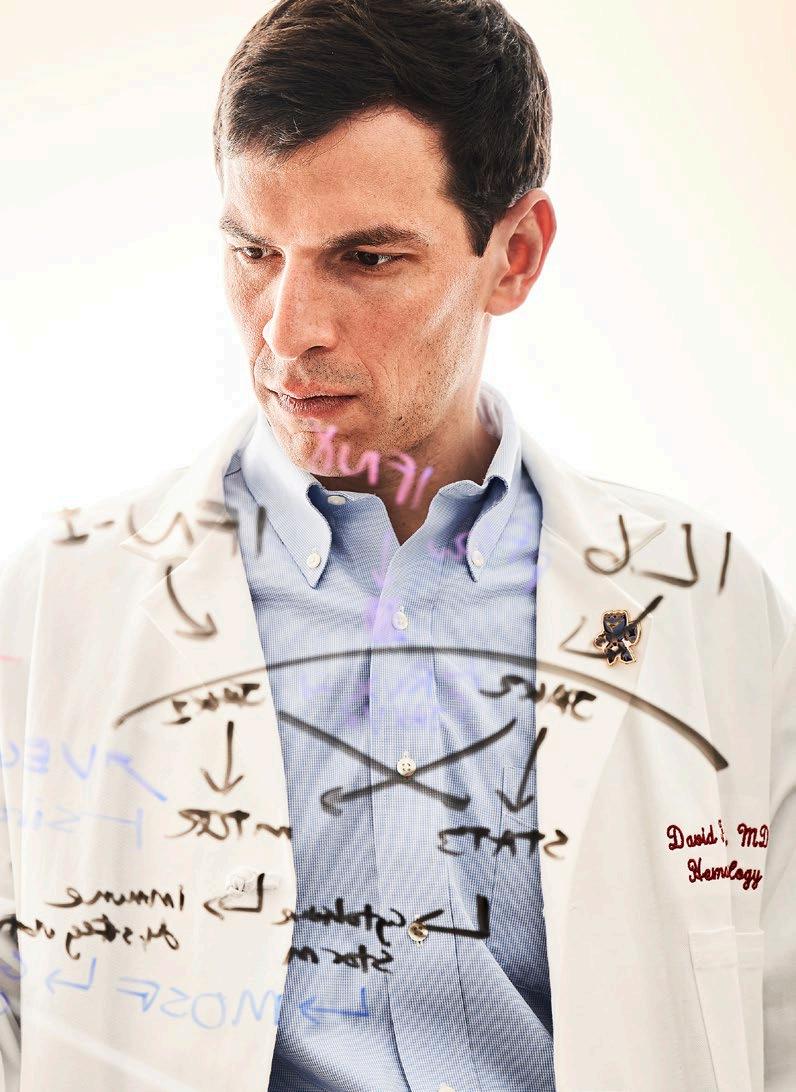
HEALTH
Photograph by Peter Murray

IT WAS JUST
after Christmas 2013, and David Fajgenbaum was hovering near death.
He lay in a hospital bed at the University of Arkansas, his blood platelet count so low that even a slight bump to his body could trigger a lethal brain bleed. A doctor told him to write his living will on a piece of paper.
David was rushed to a CT scan. Tears streamed down his face and fell on his hospital gown. He thought about the first patient who’d died under his care in medical school and how her brain had bled in a similar way from a stroke.
He didn’t believe he’d survive the scan. But he did.
David was battling Castleman disease, a rare autoimmune disorder involving immune cells attacking vital organs. It wasn’t the first time a relapse had threatened his life. Massive “shock and awe” chemotherapy regimens had helped him narrowly escape death during four previous attacks, but each new assault on his body weakened him.
“You learn a lot by almost dying,” he says.
He learned enough to surprise his doctors by coming up with a way to treat his disease. Six years later, he’s in remission, he and his wife
have a baby girl, and he’s devoting his medical career to saving other patients like him.
As a boy in North Carolina, US, David spent his Saturdays watching the North Carolina State Wolfpack American football team with his dad, the team’s doctor.
At age seven, he was obsessed with becoming an elite athlete. In school, he would wake up at 5am to run. The walls of his bedroom were covered with American football play charts.
He achieved his dream, making the Georgetown University football team as a quarterback. But in 2004, during his second year his mother died of a brain tumour.
David's obsessive focus deepened, helping him learn to appreciate life’s precious moments and understand that bad things happen to good people. “I know people far more worthy of miracles than I am who haven’t gotten them,” he says. David founded a support group for grieving students at Georgetown called Students of AMF—an acronym for Ailing Mothers and Fathers, as well as his mother’s initials (Reader’s Digest wrote about his group in 2008).

David went on to earn a master’s degree at the University of Oxford, where he learned how to conduct scientific research so that he could fight the disease that took his mum. That relentless focus and scientific rigour would one day save his life.
David entered medical school at
HE CURED HIS OWN DISEASE
56 • FEBRUARY 2022
photos, ope N i N g spread a N d story: h a N d letteri N g by m aria amador

David Fajgenbaum in 2004, in a football drill at Georgetown University (left), and how he looked in February 2011, two weeks after his third flare-up of Castleman disease



the University of Pennsylvania to become a doctor like his father— specifically, an oncologist, in tribute to his late mother.
In 2010, during his third year, he got very sick and was hospitalised for five months. Something was attacking his liver, kidneys and other organs, and shutting them down.
The diagnosis was idiopathic multicentric Castleman disease. First described in 1954, Castleman presents partly like an autoimmune condition and partly like cancer. The disease causes certain immunesignalling molecules, called cytokines, to go into overdrive. It’s as if they’re calling in fighter jets for allout attacks on home territory.
In his hospital bed, David felt nauseated and weak. His organs
were failing, and he noticed curious red spots on his skin. He asked each new doctor who came in his room what the “blood moles” meant. But his doctors, focused on saving his life, weren’t interested in them.
“They went out of their way to say they didn’t matter,” David says. But the med student turned patient would prove he was on to something.
“Patients pick up on things that no one else sees,” he says.
Castleman disease struck David four more times over the next three years, with hospitalisations that ranged from weeks to months. He stayed alive only through intense chemotherapy “carpet bombing” campaigns. During one relapse, his family called in a priest to give him his last rites.
After all the setbacks, all the organ
FEBRUARY 2022 • 57
photos: (le F t) C ourtesy peyto N williams/ a CC photos. C om; (right) C ourtesy david F ajge N baum
READER’S DIGEST
failure, all the chemo, David worried that his body would simply break. Yet despite it all, he managed to graduate from medical school. He also founded the Castleman Disease Collaborative Network ( CDCN), a global initiative devoted to fighting Castleman disease.
Through the CDCN , David began bringing the world’s top Castleman disease researchers together for meetings in the same room. His group worked with doctors and researchers as well as patients to prioritise the studies that needed to be done soonest.
Rather than hoping for the right researchers to apply for grants, they recruited the best researchers to

“I don’t think I would have felt comfortable trying the treatment on another patient; there were too many unknowns. Who knew what problems could arise when you shut down a volatile immune system like mine”
d avid Fajge N baum, i N his book Chasing My Cure
investigate Castleman. David also prioritised clinical trials that repurposed drugs that had already been approved as safe rather than starting from scratch with new compounds.
Meanwhile, he never knew whether the next recurrence would finally kill him. Staving off relapses meant flying to North Carolina every three weeks to receive chemotherapy treatments.
Even so, he proposed to his university sweetheart, handing her a letter written by his niece that said, in part, “I’m a really good flower girl.”
“The disease wasn’t a hindrance to me,” says his now-wife, Caitlin Fajgenbaum. “I just wanted us to be together.”
But in late 2013, Castleman struck again, landing David in that Arkansas hospital. It marked his closest brush with death yet.
Before he and Caitlin could send out wedding invitations, David set out to try to save his own life.
After examining his medical charts, he zeroed in on an idea that— more than 60 years after Castleman disease was discovered—researchers hadn’t yet explored.
A protein called vascular endothelial growth factor, or VEGF, was spiking at ten times its normal level. David had learned in medical school that VEGF controls blood vessel growth, and he hypothesised that the blood moles that had shown
58 • FEBRUARY 2022
HE CURED HIS OWN DISEASE
up with every Castleman relapse were a direct result of that protein spike, which signals the immune system to take action.
He also knew that there was an immunosuppressant called sirolimus that had been approved to help fight the immune system when it activated against kidney transplants.
After consulting with a National Institutes of Health expert, David asked his doctor to prescribe the drug. He picked it up in February 2014 at a pharmacy less than a mile from his home. “A drug that could potentially save my life was hiding in plain sight,” he says.
So far, it’s working. David has been in remission from Castleman for more than six years. He’s not the muscular football player he once was, but he’s close to full strength. He is now an assistant medical professor at the University of Pennsylvania, running a research lab and enrolling patients in a clinical trial for the drug that has given him his life back.
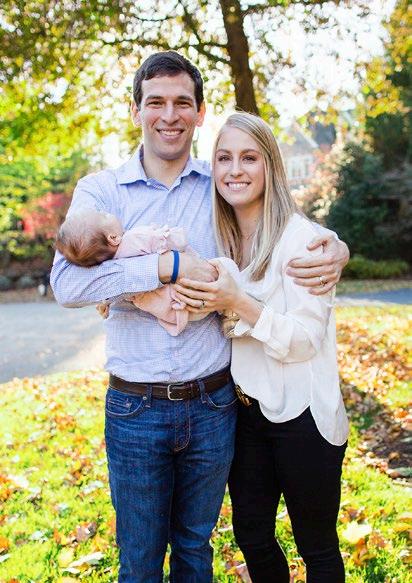
In 2018, he and Caitlin became parents when their daughter, Amelia, was born. “She’s such a little miracle,” Caitlin says. “We’re so lucky to have her.”
David hopes his story offers lessons far beyond medicine about what people can do when they’re backed against a wall.
And he feels his suffering means something when he looks in the eyes of his patients with Castleman disease. One girl, named Katie, was diagnosed at age two and endured 14 hospitalisations.
Then her doctor prescribed David’s drug after the family reached out to the CDCN. Katie hasn’t been hospitalised since and just finished kindergarten. She has even learned how to ride a bike. n
FEBRUARY 2022 • 59
F rom CNN . C om ( s eptember 16, 2019), Copyright © 2019 by t ur N er b road C asti N g s ystems, iNC ., CNN C om
David Fajgenbaum with his wife Caitlin and their daughter Amelia
photo by p eter murray

Get Into A New Exercise Routine This New Year
and join for free today
To take advantage of this limited-time offer, visit mirthy.co.uk

Do you have a New Year’s resolution to exercise more? Lot’s of us do
- the problem though, is actually finding a routine that works and actually sticking to it.
If you’ve tried to get more active before, you will already know it can be a tough adjustment, with muscles and joints complaining after every workout. The key is to take things slowly, and to listen to the needs and wants of your body.
As we all know, it’s imperative to invest in our health and wellbeing at any age, but the stakes only increase in later life.
By doubling down on self-care you can enjoy a happier retirement, minimising the risk of health conditions and illnesses that manifest in older age.
According to the NHS, “There’s strong evidence that people who are active have a lower risk of heart disease, stroke, type 2 diabetes, some cancers, depression and dementia.”
Exercise not only leads to physical health improvements but can also improve our mental wellbeing, research showing that physical activity “holds the promise of better mental health outcomes for older adults”, whilst combating conditions such as depression.
As we age, dietary self-indulgences accumulate and metabolic digestion slows, adding weight in unwelcome places.
Exercise not only improves such aesthetics, but also improves functional performance. Perhaps you want to be fit enough to go on holiday or simply able to play with the grandkids.
Such factors are invariably exacerbated
by modern lifestyles which encourage prolonged sitting at home and work. Exercise, rather than a cure, presents a prophylactic we can all use for a better life.
But despite the obvious benefits, the motivation to exercise over 50 often remains elusive. Adopting an exercise habit is hard - and sometimes it’s difficult to even know where to start.
While it’s all very well to pass a fleeting new year’s resolution, it’s harder to incorporate exercise into longer-term lifestyle change.
For this reason, it’s always a good idea to start slow and with an exercise which isn’t too taxing on the body. An excellent example of this is Pilates. You’ll probably have heard of this before - it’s a bit like yoga and is a mix of stretching and movement.
Classes are generally about an hour long and really tries to improve overall flexibility, balance and posture. These classes are usually locally run and can cost upwards of £20 per class - so the price can be a factor for many.
If you have an internet connection and a laptop, tablet or smartphone you can now join Pilates classes online, and enjoy them from the comfort of your own home. This works out much cheaper than in-person classes too!
Mirthy.co.uk is one of the most popular websites for online Pilates classes - and best of all it only costs £4.99 per month to get access to as many classes as you like.
For a limited time, you can join Mirthy entirely for free - joining takes a few seconds and then you can get full & free access to every event they run for a full month. n
PARTNERSHIP PROMOTION

Known as the "food capital of the North", Lancashire's Ribble Valley also boasts outstanding natural beauty, stunning countryside and quaint historic villages.
Visitors to this picturesque part of Britain can enjoy a trip to the 800-year-old Clitheroe Castle, which offers panoramic views of the region and a fascinating museum telling the story of the surrounding landscape over the past 350 million years. Another unmissable landmark is Pendle Hill. Renowned for its role in the 17th-century witch trials, take in its moody atmosphere while glancing out over the resplendent scenery below.
As well as its natural beauty, history and friendly communities, the Ribble Valley has one of the most exciting food scenes in the UK. From Michelin-star dining experiences through to satisfying pub grub and family-friendly eateries, there's truly something for every taste and appetite. We spoke to two players in the Ribble Valley food game to understand what makes the area so special for culinary connoisseurs.
Pendle Hill, in the distance overlooking the Ribble Valley
62
STEPHEN
FLEMING / ALAMY STOCK PHOTO

Ribble Valley My Britain:
By Anna Walker
63
INSPIRE

Steven Smith
Steven Smith, 39, is the chef and owner of The Freemasons, an award-winning inn in the Ribble Valley village of Wiswell. Visit freemasonsatwiswell.com for more information
I’ve lived in the Ribble Valley for 13 years, ever since opening my restaurant, The Freemasons, in 2009. I came to the Ribble Valley from Blackburn, where I’m originally from. I chose to open the restaurant in the Ribble Valley, as I had visited it over the years and always found it to be such a wonderful place. At that time, there was a good food and pub scene in the valley, but it was all quite similar. With The Freemasons, I wanted to push the boundaries of what pub food could be.
The Ribble Valley really is the jewel of Lancashire, with beautiful scenery all around, great pubs and places for walking, plus it’s peaceful and remote with an abundance of fresh air. It has everything you need. In nearby Clitheroe, you can walk the Tolkien Trail, a 5.5-mile circular trail inspired by Lord of the Rings author JRR Tolkien, who loved spending time writing in the Ribble Valley. There are charming

64 MY BRITAIN: RIBBLE VALLEY
Summer day on the River Ribble
historic market towns, scenic nature spots, and the Forest of Bowland and Yorkshire Dales are just a short drive away—perfect for an autumnal weekend away in the countryside.
People in the Ribble Valley are very proud to live here, and there is a great community spirit among the residents. It’s an aspirational place and there are many people that own their own independent businesses. The place is very much part of me now having lived here for over a decade.
At The Freemasons, we aim to provide the ultimate gastronomic experience in a stylish and relaxed pub setting, where everyone feels welcome. The four rooms were refurbished in 2019 and are contemporary in style, with luxury touches like a roll-top bath and dressing room at mezzanine level, Sonos sound systems and fluffy robes. Our accolades include three AA Rosettes and
five AA Gold Stars as a Restaurant with Rooms, and we were voted sixth best gastropub in the 2021 Estrella Damm 50 Best Awards and 38th place in the recent National Restaurant Awards. Guests return to us time and time again, either for an overnight stay, a meal for a special occasion or a hearty Sunday lunch. They love the relaxed atmosphere combined with the superb food and exciting dining experience.
Our overnight guests love to try our epic Tasting Breakfast (which is included with their stay), served in Mr Smith’s, my experimental kitchen space that brings you close to the culinary action. We offer special gastronomic experiences too, like the "Chef for the Day" experience and themed cookery masterclasses. They offer a great way to discover a brand new hobby while on staycation, or to elevate your home cooking skills to the next level.

65
READER’S DIGEST
Giles Shaw
Giles Shaw, 54, is the owner of Wellgate Fisheries in the Ribble Valley. Visit facebook.com/ wellgatefishmongers
I've lived in the Ribble Valley for 42 years. I came here when I lived with my parents, so it has always felt like home for me. I’ve never left the Valley because I love the place and there’s nowhere else like it. I love the warmth of the people, the setting in the wonderful countryside, and the great collection of restaurants and food producers. People feel safe here. There is little crime, an people look out for each other. There is a close-knit community here and everyone knows their neighbours, so it is always friendly and welcoming. We really have everything here on our doorstep, from the stunning scenery to fantastic food establishments—all within a close community.
My favourite spot in Ribble Valley is the village of Waddington, often called Lancashire’s best kept secret. The village is steeped in history, with King Henry VI residing briefly at Waddington Old Hall in 1465. It’s great for walks, with fantastic views, and there are a couple of great pubs to relax and chat with the locals.

The Coronation gardens in the village of Waddington
BEST OF BRITISH MY BRITAIN: RIBBLE VALLEY
66 • FEBRUARY 2022

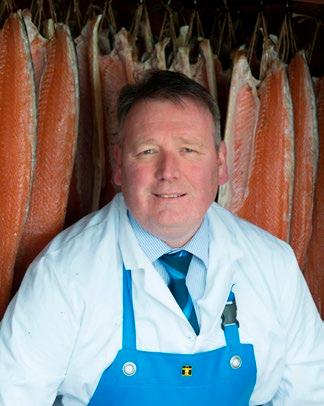
My business, Wellgate Fisheries, is a traditional independent fishmongers situated in the heart of Clitheroe. Founded in 1939 by Jack Hall, the business was later taken over by his son, before I finally bought it myself in the 1980s.
We are a member of The National Federation of Fishmongers and are passionate about providing a local service where quality really matters. We are famous for our in-house smokehouse where we produce our own smoked salmon, which is ropehung for 24 hours for a richer flavour and we supply Lancashire’s top restaurants, like the Freemasons and Moor Hall. Our fish and seafood is sourced from all over the British coast and we choose sustainable fishing practices like catches from small day boats and diver-caught scallops. n
To plan a future trip to the Ribble Valley, head to visitribblevalley.co.uk
FEBRUARY 2022 • 67
BESTPIX / ALAMY STOCK PHOTO

If I Ruled The World
Barbara Dickson
As a multi-million selling recording artist with an equally impressive Olivier Award-winning acting career, Barbara Dickson OBE is one of the UK’s best-loved performers
Single use plastic would be completely abolished. No plastic bags would be handed out and that would be a great step forward to getting rid of waste, especially in sea water. This would benefit marine life and also we would have to be mindful of bringing a bag to shopping trips. If you need a bag, it should be possible to get a paper one. The new idea of using compostable bags for veg in the supermarkets is a step forward, but it’s not enough. I come from a generation that didn’t waste much and we’ve become a throwaway society.
I’d make everyone put their phones away in restaurants and bars. In fact all public places other than buses, railway stations and airports; anywhere other than necessary use. We spend no time in conversation and getting to know each other nowadays. Strangers are in the main, just like us, and it would be helpful to smile and interact with more people in our lives in a natural way.
68
I’d ban all cosmetic surgery, other than that of a reconstructive nature. I think it fills people with false hopes about their lives and doesn’t lead to happiness. Happiness is generated from within and we have a society obsessed with youthful looks and the devaluation of age as a natural process. The elders are required to advise the youth, but they are not consulted in our Western Society. Life has its cycle and we need to get used to that.
I’d ban UPVC windows (plastic) and the inappropriate renovation of old property. Artisan cottages and little modest houses, even sturdy 1960s council properties have been ruined by disastrous updating. We need to use appropriate materials in our renovation to stop ugliness around us. They’re a blot on the landscape in our lovely country.
I’d ban cancel culture. It’s a blatant misappropriation of opinions by a few. We have to be able to engage in disagreement in our lives, without blaming others for a difference of opinion. In extremity, this is very damaging and dangerous and people have been threatened and harassed for their views. It reminds me a lot of communist states where citizens were made to wear dunce hats for disagreeing with the State. We must be more actively tolerant of each other.
Screaming children should be taken out of church and not allowed to disrupt the services. I had three children and as soon as one kicked off, they were hoicked out of their seat and taken outside! It’s pretty much usual for children to misbehave in church, but it’s not, in my new world, acceptable for them to cause chaos.
I would ban all competitive television shows, where a person is “eliminated” each week. I loathe this desperate set of values we seem to have encouraged, where people search for “success” in terms of show business, without having been given the advice and support they deserve to make a career out of their new found fame. I remember when folks won the football pools, they were given financial advice to help them adjust. It’s so easy to fall off the ladder if you’ve gone up too quickly.
I’d ban celebrity culture completely: giving people attention because of their “influencing” on Instagram without them having any expertise in any way. I want to be educated by public figures, and feel that the frivolity of the “new” celebrity we have to tolerate, is misguiding young people and setting false horizons for them in their lives and futures. n
Barbara Dickson tours nationally from March 17, 2022. Tickets available from venue box office and ticketline.co.uk
FEBRUARY 2022 • 69 INSPIRE
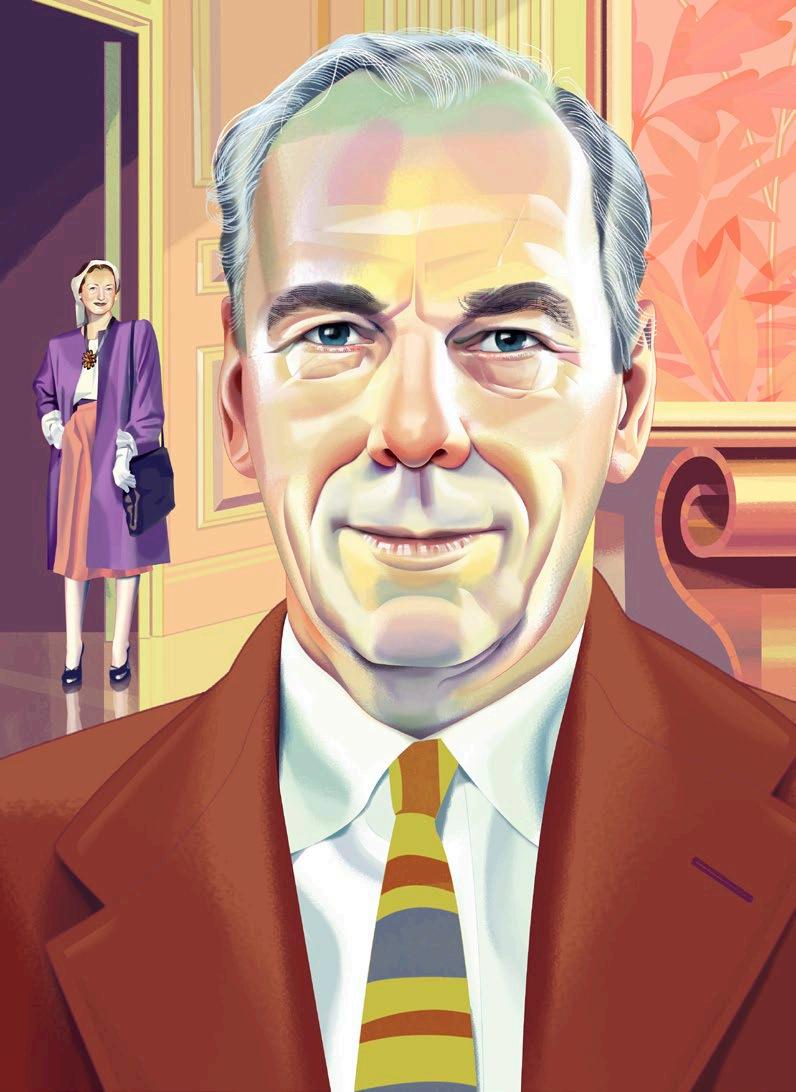
INSPIRE 70
U N F O R G E T TA B L E
DeWitt Wallace
This month marks 100 years since Reader’s Digest got its humble start. Here is the remarkable story of the man who, with his wife, Lila, built it into a global success.
By Charles Ferguson
71
illustration by Nigel Buchanan
HE WAS A QUIET MA N WHO SAID LITTLE PUBLICLY. DEWITT WALLACE SPOKE INSTEAD THROUGH READER’S DIGEST, WHICH BECAME THE WORLD’S LARGEST INTERNATIONAL MAGAZINE. IN ITS PAGES HE TOLD MORE STORIES AND BROUGHT MORE INFORMATION— AND LAUGHTER—TO MORE READERS THAN PERHAPS ANY OTHER MAN WHO LIVED.
The scene is Greenwich Village, New York City, one morning in January 1922. The Village, where rents are low, is a quaint bohemian place peopled by artists, poets, and writers. Those who deal with the printed word come to New York to be near literary markets.
At No 1 Minetta Lane, in a basement storeroom office, the last copies of the first issue of Reader’s Digest, with a February 1922 cover date, are being readied for shipment. The work is supervised by DeWitt Wallace and Lila Acheson Wallace, founders and co-editors of the magazine. They have hired habitués of the speakeasy upstairs to help.
Finally, the last of 5,000 copies are wrapped, addressed, trussed in postbags, and set outside. A taxi will take them to the nearest post office, from where they will be sent to subscribers. Then will come days of anxious waiting to see if the little newcomer is indeed what the world has been waiting for.
Lila Acheson Wallace, 32, is
brunette, blue-eyed, and petite. A social worker, she had been an English teacher before the war. She has been Mrs DeWitt Wallace for three months.
DeWitt Wallace—Wally, as he came to be called—also 32, is tall and lean, and moves with easy athletic grace; in his teens, he’d played semi-pro baseball. In the eyes of his family he is something of a flop. His father, James, is a Greek scholar and university president. DeWitt is a university dropout who has gone from one job to another. Fired most recently by a firm in Pittsburgh, he has come to New York to publish a homemade magazine.
It measures 5½ by 7½ inches. Consisting of 64 pages including the covers, the magazine is half the thickness of your little finger. This “pocket size” will be its first bid for attention, the dimensions signifying that all within is compressed and condensed. As for content, it’s just informative, helpful articles—no fiction, no pictures, no colour, no ads.
UNFORGETTABLE DEWITT WALLACE 72 • FEBRUARY 2022
Will the little magazine appeal to readers? For two years, professionals in the business have been saying no. So now with the help of his new bride and a couple thousand dollars, much of it borrowed, the amateur is going to try to wing it on his own.
LESSONS FROM LIFE
His brothers and sisters knew DeWitt, the third son of James and Janet Wallace, as dependably unpredictable. He was a prankster at school, attending Macalester College in their home city of Saint Paul, Minnesota, where his father was a professor. Although the virtues of academic excellence were regularly extolled to all the Wallace kids by their parents, the family finances were dismal. Wally determined he would one day make a fortune.
He spent the summer of 1911, when he was 21, selling maps doorto-door in rural Oregon. His first day out, he sold only 12. So he talked with veteran salesmen in hotel lobbies, picking up their strategies. Selling fascinated him. At night, he read magazines, writing notes to retain useful ideas about getting ahead in business. As he widened his circle of acquaintances, he discovered he could learn from anybody.
And this was an age that saw information emerge, when change itself became the big news of the 20th century. Wire services and
Shown here is the first issue of Reader’s Digest. DeWitt and Lila did much of the work under a New York speakeasy
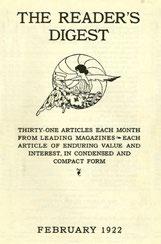


FEBRUARY 2022 • 73 READER’S DIGEST
R ’ S dige S t a R chive S
PhotoS: Reade
newspapers flooded readers with every latest detail and speculation. Their emphasis was on speed. Yet many harried readers found themselves so carried along by a tide of information that they could not distinguish between what was meaningless, and what facts fit into a larger pattern. DeWitt found newspaper treatments tentative, hasty. A magazine—halfway between newspaper and book—offered time to discern the significant, to develop an
what I’ve read during the day, and from time to time I go through the file recalling articles from memory. I do not see why time thus spent is not as beneficial as if spent studying books.” Sometimes a quote or simple outline didn’t suffice. Wally would then copy down in tiny but legible script the essence of the article as a whole, condensing it in the writer’s own words.
To DeWitt, the world of business was emerging not simply as a way
THE YOUNG DEWITT MADE FULL USE OF LIBRARIES, DEVOURING BOOKS ON
SUBJECTS HE DIDN’T KNOW A LOT
ABOUT
underlying theme, while still dealing with the fresh and new.
It was also a pivotal period in the history of man’s aspirations. Self-improvement was the key, and success could be achieved through learning. But truth was transient: with new discoveries it had to be grasped and regrasped.
DeWitt, alive to what was fresh and new in a rapidly changing world, devoured magazines. He jotted down anything that might be of use to him, a practice he had started at age 19. To his father, James, he explained: “I have 3x5-inch slips of paper, and when I read an article I place all the facts I wish to preserve or remember on one of these slips. Before going to sleep at night I mentally review
of earning a living, but as a different kind of educational system. For the youngest son of a high-principled academic family to go into the money-making business would raise questions from some about moral values because, to many, progress meant materialism. Yet for the great majority, including DeWitt, man’s material progress promised a new age, a time of fulfillment when everybody would have enough of everything.
This belief—the American dream— got support from the life story of American industrialist Andrew Carnegie. One of the world’s richest men, he published his philosophy of philanthropy, which declared that a successful businessman was
74 • FEBRUARY 2022 UNFORGETTABLE DEWITT WALLACE
morally obliged to continue to accumulate wealth in order to give it away. Carnegie also knew the value of reading and how it democratised privilege. He gave $60 million to build some 2,500 libraries throughout the United States and the Englishspeaking world, some of which DeWitt spent time in devouring books on subjects he didn’t know a lot about (once while delivering maps, Wally stopped to watch a courtroom trial. The contest of wits between attorneys fascinated him. So one rainy night he walked to one of Carnegie’s libraries and came away with The Art of Cross-Examination by Francis Wellman. He read the book in its entirety, then wrote his father fervently about the experience).
For a self-directed learner like Wallace, a system designed to supply any seeker with useful information on almost any subject was ideal, and he made full use of libraries.
DeWitt attended university but in spring 1912 dropped out for good. He took a desk job at Webb Publishing Co in Saint Paul, handling inquiries about Webb’s agricultural textbooks. At night, he continued collecting kernels of practical wisdom from his magazine reading. Could his notes provide the basis for some kind of publication offering distilled business counsel and pointers for achieving success?
After leaving his job, he got to work and in several months produced
a 128-page booklet, Getting the Most Out of Farming. It listed and described the most useful bulletins put out by the government about agriculture. He then set out in a second-hand Ford on a five-state selling trip, aiming especially at banks and seed stores that might buy the booklet in volume to give away to farmers.
In several months he sold 100,000 copies and paid off his expenses. He netted nothing, yet he had learned how to put out a publication.
He was considering how to follow up when the idea hit him: he could do a periodical aimed not just at farmers but at all readers interested in informing and improving themselves, and in getting ahead in the world.
Needing to make a living until he could launch such a magazine, Wallace took a job with a manufacturer of calendars; this was in late 1916, a few months before the United States entered the war. But the big idea was there in his mind. Maybe his recording of the essence of articles he’d read could serve as the basis for something. Among his notes was this one:
“Never fear, there is a strong undercurrent of desire for knowledge. Supply it and every dollar’s worth of printed matter will come home to roost.” The observation would be validated in the coming years.
FEBRUARY 2022 • 75 READER’S DIGEST
“A GORGEOUS IDEA”
The notes were interrupted by the Great War. On the fifth day of the Meuse-Argonne offensive in October 1918, shrapnel fragments struck Sergeant Wallace of the 35th Infantry Division in the nose, neck, lung, and abdomen. One piece of metal came within a hair’s breadth of slicing open his jugular vein. “In which case,” a medic amiably explained, “the only way we could have stopped the bleeding would be by choking you to death.”
Instead, the lucky young man was blessed with a few months of convalescence at a US Army hospital. Ambulatory and at leisure in a place supplied with magazines, he now concentrated on his idea: a generalinterest digest. He’d read, select articles, and boil them down as he copied them in his chisel-clear handwriting.
Once back home in Saint Paul, over six months in the library he built a stockpile of choice articles. Finally he put together 31—one for each day of the month, each cut to two pages or less—and had a printer run off several hundred copies of this sample Reader’s Digest. It was dated January 1920. To finance the project he had tapped his older brother Benjamin for $300. His father at first refused a like amount, pointing out that DeWitt was hopeless at managing money. But James Wallace was persuaded to help by the argument that readers were “anxious to get at the nub of things.”
Proudly, Wally started showing his dummy around Saint Paul and then to the big publishing houses, willing to give his invention away to anyone who’d publish it and sign him on as editor. One after another, publishers turned down the idea as naive, or too serious and educational.
Dejected, the ex-sergeant found his fortunes at low ebb. There was a single compensating bright spot. One day, he ran into Barclay Acheson, a university friend. DeWitt had once spent the Christmas holidays at the Acheson home, where he was much taken with Barclay’s sister, Lila Bell—“a dream of a girl.” Nothing came of it at the time: Lila was already engaged.
During the war she had made a career of helping to improve conditions for female factory workers, and now she was still at it, working for the YWCA in New York. Wallace, on hearing from Barclay that she had not in fact married, fired off a telegram to her: “CONDITIONS AMONG WOMEN WORKERS IN ST PAUL GHASTLY. URGE IMMEDIATE INVESTIGATION.”
By chance Lila was already scheduled for a temporary assignment in Saint Paul. On her first evening there, Wally proposed; on the second, she accepted. Only after they were engaged did he give her a copy of his sample magazine. “I knew right away it was a gorgeous idea,” she said later.
76 • FEBRUARY 2022 UNFORGETTABLE DEWITT WALLACE
Though practical considerations prevailed—she returned to New York, and he took a job writing promotional copy for Westinghouse Electric in another city—he never stopped thinking about his own magazine.
In 1921, Wally was laid off. That did it. In his gloom, he saw anew the brilliance of a suggestion that had been given him by a fellow worker—
of the city, and they formed The Reader’s Digest Association.
AFTER THE FIRST ISSUE CAME OUT, NOBODY CANCELLED THEIR SUBSCRIPTION. SO THE PAIR GOT WORKING ON A SECOND
why not sell the magazine directly to readers, by mail?
Immediately, on his portable typewriter in his rented room, he began pounding out letters soliciting subscriptions. He hunted for lists of people—nurses, preachers, members of clubs. From university catalogues, he got names of faculty members.
The pitch had to be particularly good since what he was peddling existed only in his mind. But he offered a provisional commitment— the subscription could be cancelled and all money refunded if the reader wasn’t satisfied. For four months, he wrote and mailed out letters, each with an individually typed first page. Then, in October 1921, he left for New York, and Lila.
Together they did two things: They got married at a church in the small town of Pleasantville, 30 miles north
Settling into a Greenwich Village apartment, the couple got out another batch of letters before going off on a two-week honeymoon north of the city. Replies from these letters brought the number of paid subscribers to 1,500, each subscription accompanied by $3; they had enough cash to put out a first issue, maybe even a second.
That first issue of Reader’s Digest featured, in its lead article, the great inventor Alexander Graham Bell and his belief that self-education is a lifelong affair: “The very first essential of any real education is to observe. Observe! Remember! Compare! It is the foundation of all education.” The article was an accurate reflection of the mind of DeWitt Wallace, university dropout, self-educated man, and founder of Reader’s Digest.
To help pay the printer, Lila had sublet one room of their small apartment, sharing their kitchen and bath with another couple. Now they waited. What would they do if even one third of the subscribers wanted their money back…
Continued next month in our March issue
FEBRUARY 2022 • 77 READER’S DIGEST












Excellent light, it’s made reading so much easier.
 Mrs Verrell East Sussex
Mrs Verrell East Sussex


















































Read in comfort for longer
Do you struggle to see small print and detail, even with reading glasses?
The right light is just as important as having the right lenses - it helps you enjoy cherished hobbies for longer in comfort, without straining to see.
Serious Lights bring daylight indoors. They use bespoke
technology to deliver incredible clarity that lets you lose yourself in your favourite books without experiencing the uncomfortable e ects of eyestrain.
See the di erence with your own eyes and rediscover your love of literature.



Enjoy clear detail again
30 day in-home trial
Recommended by over 500 opticians

Compact Light WORTH £150 with any Serious Light order when you use code 100W2, while stocks last FREE







giL h t u p yourlife indoors ™ Readers ® For
085 1088 seriousreaders.com/100W2
Advice. For a Brochure. To Order: 0800
HAND M ADEIN GREAT BRITAIN DAYLIGHT WAV E LENGTHTECHNOL O G Y ( T )M







To celebrate the 100th anniversary of Reader’sDigest we’re relaunching our muchloved 100-word-story competition with prizes of up to £1,000 to be won

Our 100-word-story competition is your chance to show the world your story-telling talents. There are three categories—one for adults and two for schools: one for children aged 12–18 and one for children under 12. Your stories should be original, unpublished and exactly 100 words—not a single word shorter or longer! Entries are now open. The editorial team will pick a shortlist of three in each category and post them online on June 1. You can vote for your favourite, and the one with the most votes will scoop the top prize. Voting will close on May 1 and winners will be published in our September issue. Visit readersdigest.co.uk/100-wordstory-competition to enter.
Light up your life indoors with a Serious Light. Proud sponsors of the 100-word-story competition. seriousreaders.com/100words
79
-
In Association With
Previous Winner
MONKEYS WITH MONEY AND GUNS
by Matt Soden, Chelmsford
Shaving the chimp and getting it into a suit was one thing, but getting it elected? Madness. Gullible, yes. The people weren’t stupid…were they? Sure, he looked like a businessman and he had even learned to talk, but what he knew about running a country you could write on the outside edge of a dollar bill—plus the animalistic urges remained. Less fiscal, more fist-full.
Let the people decide! Oh, I didn’t think…The world waited to see how this monkey business would end, as he sat beating his chest, staring at the big red button on his desk.
 illustration by Daniel Mitchell
illustration by Daniel Mitchell
Rules: Please ensure that submissions are original, not previously published and exactly 100 words long (not including title). Don’t forget to include your full name, address, email and phone number when filling in the form. We may use entries in all print and electronic media.
Terms and conditions:
There are three categories—one for adults and two categories for schools: one for children aged 12–18 and one for children under 12.
In the adults category, the winner will receive £1,000 and a Serious Readers High Definition Floor or Table Light (value up to £399.99) and one runner-up will receive £250.
In the 12–18s category, the winner will receive a £200 book voucher or an 8GB Kindle Paperwhite and a £100 book voucher for their school, and the runner-up will receive a £100 books voucher.
In the under12 category, the winner will receive £100 of book vouchers or an 8GB Kindle Paperwhite and £100 of book vouchers for their
school, and the runner-up will receive a £50 books voucher.
Please submit your stories by 5pm on May 1, 2022 either online at readersdigest.co. uk/100-word-story-competition or via post addressed to:
Reader’s Digest
100 Word Story Competition
Warners Group Publications
West Street
Bourne
PE10 9PH
The editorial team will pick a shortlist of entries, and the three best stories in each category will be posted online at readersdigest.co.uk on June 1, 2022.
You can vote for your favourite, and the one with the most votes wins the top prize. Voting will close at 5pm on June 30 and the winning entries will be published in our September issue. The entry forms and full terms and conditions are on our website.
80 • FEBRUARY 2022 100-WORD-STORY COMPETITION

















































































If only you could still see detail and colours without the frustration of straining to do so. This was precisely why our Founder rst built a better light for his mum


Enjoy clear detail again
30 day inhome trial









Serious Daylight Technology™ uses special-purpose 36v purple LEDs
electronics to project a powerful light beam that will transform your visual experience. When you switch a Serious Light on, you’ll enjoy crystal clear clarity when reading and see the vibrant colours that make craftwork such a pleasure.



First and who su ered with macular degeneration. Wavelength and proprietary only light to Warwickshire

No Ordinary Light Compact Light WORTH £150 with any Serious Light order when you use code 100W1, while stocks last FREE
Recommended by over 500 opticians













giL h t u p yourlife indoors ™ Readers ®
085 1088 seriousreaders.com/100W1
For Advice. For a Brochure. To Order: 0800

INSPIRE 82

In WeDogsTrust
What I learned from my constant companions
BY Jennifer Finney Boylan
83
FROM GOOD BOY: MY LIFE IN SEVEN DOGS illustrations by Kendra Huspas K a
Indigo

It seemed like it had only been a few years ago that Indigo, our black Lab, had first barged through our door. Her underbelly showed the signs of the litter she’d recently delivered, and between the wise, droopy face and the swinging dog teats, she was a sight to behold.
She had a nose for trouble. On one occasion, I had come home to find that she’d eaten a five-pound bag of flour. She was covered in white powder, and flour paw prints were everywhere, including, incredibly, on the countertops.
I asked the dog what the hell had happened, and Indy just looked at me with a glance that said, I cannot imagine what you are referring to.
Time raced by. Our children grew up and went off to university. The mirror, which had reflected a young mum when Indigo first arrived, now showed a woman in late middle age. I had surgery for cataracts. I began to lose my hearing. We all turned grey: me, my spouse, the dog.
In August 2017, I took Indigo for one last walk. She was slow and unsteady on her paws. She looked up at me mournfully. You did say you’d take care of me when the time came, she said. You promised, Jenny.
She died that month, a tennis ball by her side.
Not long after, I got a call from the
Bed ’n’ Biscuit, our dog daycare. One of their customers was dying, and her dog, Chloe, needed a home. Given our recent loss, they asked, might our family be interested in adopting her?
I told the Bed ’n’ Biscuit we were sorry but we wouldn’t be adopting any more dogs.
I’d owned a succession of dogs since 1964, each one of them a witness to a particular phase of my life. But with the loss of Indigo, all that was over. The days of my dogs, I now understood, were done at last.
Then one morning, as I was passing the Bed ’n’ Biscuit in my car, I pulled over. I could at least lay eyes upon this Chloe. What harm could it do?
She had a soft face.
When Chloe entered our house, she was cautious, uncertain. She spent hours that first day going to every corner, sniffing things out. Finally she sat down by the fireplace and gave me a look. If you wanted, she said, I would stay with you.
Playboy

Everything I know about love I’ve learned from dogs. But everything I know about loss I’ve learned from them, too. They fill our hearts. They leave floury paw prints all over the house. They lick the tears from our faces. And then, in what seems like no time at all, they’re gone.
IN DOGS WE TRUST 84 • FEBRUARY 2022
It reminds me a little bit of what people say about childbirth: if you really remembered how difficult it was, you’d never go through it more than once. And yet, year after year, dog after dog, I’ve forgotten the grief of losing them—right up until the moment they give me that look with their grey faces: Jenny, you promised.
IT’S IN OUR LOVE FOR DOGS THAT WE CAN MOST EXPRESS HOW HARD IT IS TO BE HUMAN
The pain of their loss doesn’t seem to be lessened one bit by the fact that many of the dogs I’ve owned have been kind of terrible.
My first dog, for instance, was a badtempered dalmatian named Playboy, a resentful hoodlum who loved no one but my father.
We lived in the farm country of eastern Pennsylvania then, and Playboy had no qualms about chasing donkeys, cows and even, on one occasion, a leather-jacketed Hell’s Angel racing by on a Harley. That dog once stole the Christmas turkey right off the table. He bit people. There were times when my sister and I hated his guts. We were fairly sure the feeling was mutual.
And yet he was devoted to my
father, a soft-spoken man who had always wanted to be a medievalhistory professor but who wound up working at a bank instead. At the end of the day, Dad would come through the door with the Evening Bulletin and tug off his tie, often with an air of grim exhaustion. Then he’d sit down in a leather chair and Playboy would lie down at his side and roll around until his paws were in the air. My father would rub the dog’s belly. “Who’s a good boy?” he’d ask. “Who’s a good boy?”
It was a good question.
What did I learn about love from Playboy? That it is perfectly fine if everyone hates you, as long as you are deeply loved by one person.
Sausage

In adolescence, I had another dalmatian—a sad, overweight blob named Sausage. I got her for my 11th birthday, and for several years I adored her, carrying that dog around like a Raggedy Ann doll. Some nights she slept in my bed, her head upon the pillow next to mine.
“I’ll always love you,” I told the dog. “We’ll always be best friends.”
But the promise I made as a child was hard to keep once I became a surly teenager and Sausage developed some obscure condition that caused her to lose the hair on her tail. An unsettling brown goo oozed out of her eyes.
FEBRUARY 2022 • 85 READER’S DIGEST
Friends who came over to my house made fun of Sausage. They said my dog was gross, and they were not wrong.
More unforgivably, though, my dog was uncool, a reminder of the nerd I myself had been not so long ago.
So I turned my back on her. I made other friends, some of them boys who owned hot rod cars with T-bars.
It was from Sausage that I learned this awful truth: sometimes love fades, and as you age, it can be hard to keep a promise you made when you were young.
Matt the Mutt

At the end of her first year of uni, my sister brought home a terrible dog named Matt the Mutt, who’d been raised in her dormitory. She handed him over to my parents—he’s yours!—and headed west. Just like that, the reign of Matt the Mutt began.
For the next eight years, the dog bounced around the house, lifting his leg pretty much wherever he pleased, knocking people over, barking incessantly. Anyone coming through the door—including my tired father with his briefcase and his newspaper— would be instantly assailed by the bouncing, howling creature.
Matt the Mutt was a love machine, a regular Pepé Le Pew. He would copulate with pretty much anything: furniture, the postbox, even the nowgeriatric Sausage. Above all, he lived to
make love to my grandmother’s leg. Which was fine, I guess; my grandmother thought it was funny. “He’s got more spunk than your grandpa!” said she. From Matt the Mutt I learned this: sometimes the happiest people are the ones who make everyone else’s lives impossible.
Brown

When I was in my twenties, my parents got a Labrador named Brown. This time we swore—just once!— we’d own a dog that was not completely insane. In this our hopes proved nugatory.
Brown developed a strange addiction to running water. She would move a kitchen chair to the sink with her snout and open the tap with her teeth. Then she’d stand on the chair, biting the running water. Later, the dog became obsessed with chewing her own paws, something the vet described as a lick granuloma.
We’d hoped that this time we’d have a normal dog. But from Brown I learned, instead, that sometimes people who seem the most normal turn out to be the craziest.
Still, it was Brown who provided me consolation when my father died of melanoma. As I sat in a chair in my mother’s house, weeping, the dog came over and put her head in my lap. Do not be dismayed, for I am thy Dog, she said. Whoever lives in love, lives
86 • FEBRUARY 2022
IN DOGS WE TRUST
in Dog, and Dog in him. Brown looked at me with stead fastness and adoration, and her tail thumped against the floor. There had been scars on her legs. Maybe, with time, they could be healed.
Lucy

I got married just after I turned 30, and we moved to a farmhouse in central Maine, where I got a job teaching English at Colby College. There we were joined by a yellow dog I bought from a pig farmer. We called Lucy—a Kennebec Valley flycatcher—on account of her fondness for biting flies right out of the air. Sometimes she’d look at me as if to say, They might be flies to you, but to me they are sky-raisins.
Lucy would give me other looks, usually in shades of disdain. When my daughter was nine, she wrote an essay for school: “Our Dog Hates Us.” It was true, too. Everything about our family seemed to annoy Lucy. For a while, this made me feel a little puny, until at last I realised that Lucy was just lonesome for the place she had loved first: our neighbour’s pigsty.
And so from Lucy I learned this: sometimes all people want is the thing they had when they were young.
Each of these dogs had taught me something about the perilous nature of devotion. Some people will tell you that the magic of dogs is that their love
for us is unconditional, but I’ve never found this to be the case. What’s unconditional is the love we have for them.
At 60, I’m pretty sure that if there is any reason why we are here on this planet, it is to love one another. It is, as the saying goes, all ye know on earth, and all ye need to know.
And yet, as it turns out, nothing is harder than loving human beings.
That’s where dogs come in. It’s in our love for dogs that we can most express how hard it is to be human, how glorious and how sad.
Chloe

After Chloe joined us, I had hopes of having a conversation with her previous owner, the woman who’d been laid low by cancer. I wanted her to know that her dog had found a good home and that we’d take care of her.
When I finally got through, though, I learned that Chloe’s owner had died.
It snowed that night, and I woke up in a room made mysterious by light and stillness. In the morning, I sat up and found that Chloe had climbed into bed with us as we slept.
Well? she asked. I touched her soft ears in the bright, quiet room and thought about the gift of grace.
“If you wanted,” I said, “I would stay with you, too.” n
FEBRUARY 2022 • 87
READER’S DIGEST

LEARNING SAMBA IN RIO
To dance at Carnival would be a dream come true. But I was not a natural talent
By Sebastian Kempkens From Die Zeit photographs by Evgeny Makarov
The author, centre, plunged feet-first into the fun of Carnival
TRAVEL & ADVENTURE 88
If it looks so easy, why does it feel so difficult? That’s what I ask myself as sweat runs down my forehead. My T-shirt is stuck to my body, I am gasping for air. I tell myself these hardships won’t stop me. I am on a mission: to learn how to dance the samba…
It’s February 2019, and I had arrived in Brazil a few days prior, having picked the Carnival season for my vacation. I’m from Rhineland in Germany, and I love Carnival. Countless times during the celebrations in Cologne, I’ve partied in pubs dressed as a bear, a banana, or a cow. I have boozed, kissed, and danced my way down Zülpicher Strasse with people from France, Spain, and Colombia.
So I thought it would be great to experience Rio de Janeiro’s legendary Carnival. In Brazil the celebration has Catholic roots as an annual feast before the 40-day fasting period of Lent. It has since transformed into one of the world’s biggest festivals, with costumed dancing groups called blocos parading on the streets.
I especially wanted to join the grand finale parade at the Sambódromo stadium and do the samba with thousands of dancers, cheered on by tens of thousands of spectators. For me, that would be the crowning glory. And making that happen sounded very simple: register with one of the samba schools that is
allowed into the Sambódromo, buy the proper outfit, and rehearse.
There was just one problem. The only dance lessons I’d ever taken dated back to a crash course before a school dance ten years ago. I was not a natural talent. And samba— involving quick, lively moves accompanied by music of the same name—is highly complex. It was brought to Brazil long ago by African slaves; in Angola, the word semba meant the implied touching of the bellybuttons of two dancers, which was an invitation to dance.
Rio has more than 100 samba schools, but the nationally televised parade includes just 13. I wanted to be with one of them. So when I arrive five days before Carnival, I call one of the most renowned, Unidos da Tijuca.
“My name is Sebastian,” I say. “I’m from Germany and I’d like to learn samba so I can be in the Sambódromo parade.”
Silence. Is the man on the other end of the line too polite to laugh? Too shocked to shout?
“Let’s see what we can do,” he growls. “It depends on your skills.”
89
FEBRUARY 2022 •

From Ipanema in the south of the city, the taxi heads along Copacabana toward Rio’s centre. To my right, the sea is turquoise; bare-chested guys on the beach keep a football in the air seemingly without effort. To my left we pass the glass facades of fancy hotels, and then the favelas, or slums, rickety wooden structures that blend into the hills like colourful mosaics.
Soon the taxi driver points to a lonely looking concrete monstrosity with two grandstands facing each other like an unfinished stadium: the Sambódromo. It’s hard to imagine that the year’s biggest party will take place there in a few days.
We stop in an industrial area not
far from the city centre. On a wall is a sign: “Cidade do Samba”—City of Samba. I walk onto a huge square bordered by tall warehouses, which are the headquarters of the major samba schools. In front of Unidos da Tijuca, where I’ll take lessons for 60 euros an hour, is a man in a yellow muscle shirt and flip-flops, leaning against the wall and holding a protein shake: Fabio, my dance master. As he leads me inside, Fabio, who is responsible for 750 of the 3,500 Tijuca dancers, tells me in a whisper that this is a kind of holy place, “like a church.”
This is where the floats are built.
I see a tree-sized figure of Jesus enthroned on a carriage, surrounded by his disciples. Next to it is the
90 • FEBRUARY 2022
The grand finale takes place at the Sambódromo stadium
replica of a slave boat as big as a school bus. Plastic figures of women and men look down from the railings, their hands in chains, their faces contorted in pain.
“No photos,” says Fabio. Competing schools a few dance halls away must not find out what Tijuca has planned.
In his office on the third floor, Fabio explains that celebrating Carnival is about more than fun. There is a start line and a finish line for the parade in the Sambódromo. Each school has 85 minutes to complete the distance between the lines. Any faster or slower means you lose points. Judges give scores for the drummers, costumes, floats, and dance steps.
I see trophies in the offices here, but Tijuca hasn’t won in a long time. “The pressure is on,” says Fabio, sounding like a football coach. “We have to deliver!” Am I his trump card? Hardly.
Fabio has spent the past few months in countless auditions picking his stars, the men and women who will dance in the limelight. He has been training with them several times a week. Most dancers, however, perform a simple choreography. A few steps, repeated over and over. If all goes well, I will be part of this rank and file.
We move to a makeshift dance studio where I am to learn the basics.
Fabio demonstrates: a step onto the right heel, then onto the left, the right, the left. The seemingly endless
repetition is an introductory lesson and warm-up. “One, two, one, two,” Fabio calls, then adds a little jump, arms swinging. Not a lot of moves, yet every part of the body is in motion.
When we’re through, Fabio highfives me, “You’re athletic, that’s good.” It’s only later, when I am in the taxi, euphoric and soaked with sweat, that I wonder about his praise. Athletic? Me?
That evening I go to Rio’s Botafogo, a neighbourhood of galleries and nightclubs. I sit in a wicker chair on the sidewalk and people-watch while sipping on a caipirinha (a local cocktail made with lime juice and cachaça, a cane-sugar-based spirit). The passing crowd looks ready for Carnival: there’s a man wearing a raffia skirt and fishnet shirt, smiling blissfully; a group of women, their nipples covered with black tape; an elderly man sporting a giant afro wig.
The next day Fabio and I dance laterally, diagonally, back and forth. For the first time, we do step sequences. I swing my right foot behind my left, tap my heels, scuttle in the opposite direction, just as Fabio demonstrates. I feel weightless, in the midst of a transformation, playfully shaking off my dark German soul.
Then we step in front of the mirror to dance, and I think: Oh, Fabio, I’m sorry! Because what I see doesn’t reflect the light-footed Neymar I had
FEBRUARY 2022 • 91
READER’S DIGEST
Samba is highly complex and involves quick, lively moves

imagined myself to be only moments ago. Instead, I look like I’m relearning how to walk. Angular, clumsy movements. Every step an effort, a declaration of war on the samba. I’m like a geriatric Bavarian folk dancer gone astray.
But Fabio laughs, claps, and cheers me on. I deeply admire his ability to not only bear with me but apparently have fun doing it. Or am I not as bad as I think? Is there still hope?
The next day is the final training session, the moment of truth. Fabio starts the choreography that he wants me do in the parade. He snaps his fingers, swings his arms, shoots across the room with steps so fast he doesn’t seem to touch the floor. I try to follow suit, running and jumping, snapping and clapping, giving it my all, and I realise: I can’t do it.
Fabio takes my hand to guide me, but I stand there like a stubborn donkey refusing to budge. I suffer cramps in my calves, my body is done, and I feel helpless. And there is Fabio next to me: graceful, poised, smiling. I don’t think he’s even sweating. So I keep going.
Afterwards, we sit on the sofa. I know the moment is here—the moment when, like a medical diagnosis, I’ll find out that despite heroic efforts, my condition is incurable.
Fabio begins. “Maybe I should have told you this already,” he says, but at Carnival a few years ago, Tijuca’s theme was Germany. There were giant foam beer mugs on the floats, and men in lederhosen and Goethe costumes pranced through the Sambódromo. Fabio had allowed
92 • FEBRUARY 2022
a number of German tourists to participate. It was a decision he came to regret bitterly: half of them showed up drunk the day of the parade, and the other half had forgotten their dance steps. The result? Tijuca tumbled in the judges’ rankings. Ever since then, he’s been very sceptical of Germans.
I sink into the sofa. How embarrassing! Here I am, some kind of clueless megalomaniac reporter who thought he could just dance his way onto the team. I am about to start apologising when Fabio puts his hand on my shoulder like a second-hand car dealer about to make a proposition too good to turn down. He has an excellent bloco to suggest for me, he says. That’s where I should go and perform everything he has taught me.
And, of course, he says, I should come to the Sambódromo anyway, “as a spectator.” Fabio has dropped me as a dancer in the big parade, but manages to make the alternatives seem just as good. The man is a hero.
The meeting point for my bloco is a kiosk in the city centre, just behind the gilded facade and turquoise domes of Rio’s opera house. I stroll through a deserted downtown, past office buildings and shuttered stores. No one is working. Every few metres, music blares from a dark alley, and there is a beer booth with a few revellers.
At the meeting point, I soon feel like part of a conspiratorial community: there are people with glitter on bare skin, people wearing neon colours and feathers. Women are in swimsuits and fishnet tights, and men wear skimpy shorts and nothing else. I put on a pair of golden swimming trunks and slip on a Hawaiian shirt. Pop music blares from the kiosk’s speakers. We toast each other and Carnival.
Then, trumpets sound. The crowd starts to move. A band is waiting for us on the street, more trumpets, trombones, drums, and rattles. We run and dance behind the musicians, and the farther we parade, the wilder it gets. It’s like a partying dance caravan in the middle of the city.
We block main streets, run past squat colonial buildings and glass office buildings, and even head right through a small shopping mall. It’s pure anarchy. I’ve lost track of where I am—and of my Hawaiian shirt— but that doesn’t matter; I’m only following the drumbeats.
Then it starts pouring, and we hop arm-in-arm through the puddles, cheering towards the sky and thanking the rain god. The band plays ABBA and the Beatles, and I dance samba the way Fabio taught me.
At some point, a woman pulls me into the middle of the band. Perhaps she has seen my stumbling efforts, perhaps she has sensed the
FEBRUARY 2022 • 93 READER’S DIGEST

sweat I have sacrificed over the past few days. We dance together, her feet flying, her hips swaying, me improvising—and eventually our bellybuttons kiss.
The next evening, I’m sitting in the Sambódromo waiting for Fabio’s team. I have never seen a party like this. Old and young squeeze into the stands, cheering each float. The rich are crowded into boxes lined with artificial turf, the poor are squatting up high on the concrete benches swilling canned beer. Everyone is screaming and clapping nonstop.
The performances look like a psychedelic dream filled with princesses and warriors, glitter and pomp. Men in scuba-diving gear dangle from a float, arms moving as if they are swimming. Women in gorgeous gilded costumes pass,
waving flags to the rhythm of the music. A turtle with a fluorescent shell pushes past, as big as a cruise ship.
Tijuca is the last school to dance; it’s almost four o’clock the next morning. At this point I am quite drunk. Red flares give the start signal. I watch Fabio as he runs along the floats, shouts instructions, cheers, corrects. In the end, Tijuca makes seventh place. Once again there’s no trophy for them, but at least they are not relegated.
On my flight home, it occurs to me that maybe it’s a good thing I was just an observer of the Sambódromo grand finale. Maybe samba and Carnival are about dancing until you can’t anymore. And that if you can’t dance…don’t. n
94 • FEBRUARY 2022
From Die Zeit (September 2020), Copyright ©2020 by Die Zeit Revellers gather at Rio de Janeiro’s Botafogo beach
Buckingham Palace virtually all yours
Explore the historic residence of British royalty from the comfort of your own home
Are you sitting comfortably? Then we’ll begin. History and stories abound about Buckingham Palace and its surroundings. Using pictures, old paintings, Google earth - and 360 degree views of the most spectacular rooms - this fascinating virtual tour will bring the palace and its past to life.
Your guide (and history bu ) Loona Hazarika will accompany you through the tour, where you’ll find out about all about the preparations needed for a royal banquet, visit the drawing room with a secret door, learn of rumours of a secret tunnel and virtually visit the gallery that has largest collection of Canalettos in the world.
Take a virtual stroll down the Mall and around St James’s Park to hear stories about Henry VIII’s jousting ground, how the Stuarts made it in to a pleasure park and curious facts such as how the British taught the French to bottle champagne and who exactly the grand old duke of York was (in fact he wasn’t all that grand at all).

This engaging one-and-a-half-hour virtual tour takes place on 2nd February 2022 and you can join in online at www. mirthy.co.uk. There’s also a recording available to watch for 7 days afterwards for anyone who misses the live event. ■
FOR MORE INFORMATION
At Mirthy we understand that currently, not everyone feels comfortable being out in shared spaces. Which is why our virtual events bring the world to you. Join Mirthy’s online community and try over 50 classes & events for free.
Simply visit www.mirthy.co.uk


PARTNERSHIP PROMOTION
Welsh Wonders My Great Escape:
Our reader Carolyn Ross discovers the beauty of north Wales
It’s embarrassing to admit that only now at the grand old age of 64 I have discovered the breathtaking beauty of north Wales. Lured from Buckinghamshire to the region by the Portmeirion classic car run, my husband’s 1964 Daimler Dart effortlessly steered us through a magnificent route which teemed with dramatic hills, mountains, lakes, rivers, streams and waterfalls and many, many sheep.
North Wales is lush, green and wet. The Daimler Dart has a soft top which can sometimes prove problematic to put up, especially when time is of the essence. We left our hotel the first day with breakfast under our belts, and the top down. Within a few miles it became apparent that this was a bad move, as a light drizzle became a downpour. Gamely we wrestled with the hood, waving wetly but cheerily as our fellow classic motorists passed


by tooting a sympathetic horn. Ten minutes later we had the hood up and, bearing a passing resemblance to drowned rats, dived into the interior where we generated a steamy mist all the way to Caernarfon.
Along with its medieval castle, this pretty town possesses infinite streets and passages studded with delightful inns, including the Black
TRAVEL & ADVENTURE
96 • FEBRUARY 2022




No trip to Wales would be complete without visiting its highest mountain. The run took us to Llanberis where we abandoned the cars in favour of a train that took us halfway up Mount Snowdon. Hordes of climbers were trekking up the footpaths to the summit where, we were told, there were no facilities open. It was shrouded in mist so there was nothing to see, and it was heaving with people. So we contented ourselves with a blustery stroll around the halfway point at 3,500 feet, allowing ourselves to be shoved hard by sudden gusts of chilled air, refreshing as a cold shower, and gazed down at a quiet lake which changed with a chameleon-like quality from slate grey to brilliant turquoise as the sun came in and out from behind the scudding clouds.
There was more we saw, and so much more we didn’t see. There was also momentary hysteria when we came across a quest of an alternative route to the next rendezvous point.
Each day of our trip finished with a welcome libation bathed in evening sunshine at the Portmeirion Hotel and in happy anticipation of a divine dinner menu. n
Boy which was built around 1522, and which proved to be a more than agreeable locale in which to enjoy a cappuccino while drying off.
Tell us about your favourite holiday (send a photo too) and if we print it, we’ll pay £50. Email excerpts@readersdigest.co.uk
FEBRUARY 2022 • 97

SOUTH LAWN CAR PARK Melbourne
It’s likely that you won’t travel all the way to Australia to visit a car park. But if you happen to be in Melbourne, then do pause in this unusual garage—if not for its serious architectural pedigree, then for its cinematic history.
Below the University of Melbourne’s main, leafy campus in Parkville, ten minutes’ walk from the city centre, South Lawn Car Park was completed in 1972. Dreamed up by Dutch structural engineer Jan van der Molen, it resembles a low, shadowy forest of concrete mushrooms—wholly distinct to the neat, cheery greenery above.
Consisting, specifically, of reinforced shells with parabolic arches atop short columns, van der Molen’s design was soon being lauded by architectural historian Miles Lewis as Australia’s “most important non-residential design”.
So striking is the now-listed car park that it has frequently lured film crews. South Lawn’s most famous credit, however, came when hosting the police-garage scene in the original Mad Max movie—when Mel Gibson’s character is delightedly introduced to the “last of the V8s”.
Despite its gothic looks, van der Molen’s space is also lifegiving. Those concrete shells’ deep bowls enable large trees to be planted on South Lawn’s roof, with pipes inside columns helping to drain their soil.
Try to arrive and leave at different ends. Framed by two sculpted Atlas figures, the car park’s grotto-style western entrance uses a salvaged doorway from the demolished Colonial Bank of Australasia while its eastern door off Wilson Avenue hails from an 18th-century house in Dublin, Ireland.
By Richard Mellor
IGOR PRAHIN / ALAMY STOCK PHOTO 98
HIDDEN
GEMS

99

Equity release: safeguards and protection
What is equity release?
Equity release can help you to access tax-free cash from the value of your home. With a Lifetime Mortgage, the UK’s most popular form of equity release, you can access your property’s wealth in a tax-free lump sum or reserve some funds for later use.
Releasing equity is a great way to gain funds in your leisure years as there are no required affordability checks, with how much you can release being primarily determined by the value of the home and the age of the youngest homeowner instead.
What are the advantages of a Lifetime Mortgage?
Lifetime Mortgages can be highly varied and include different features to protect your interests, based on your unique situation. At Reader’s Digest Equity Release, we have filtered the products currently offered by different lenders to

provide our customers with a selection of the most suitable, with qualified advice available to then help you assess your options.
Your adviser will also discuss with you the alternatives to equity release, and the impact of each option, to reach a decision as to whether equity release is the best solution for you.
What protections are in place?
The Equity Release Council (ERC) is the industry body which aims to ensure best practice from providers, protect customers, and reduce risk. They hold their members to a set of guidelines, and these guidelines are at the forefront of the service that Reader’s Digest Equity Release provide.
With a Lifetime Mortgage you have the right to remain in your home for life and you will also retain full ownership. You will
also never owe more than the value of your home thanks to the no-negative-equity guarantee built into all plans provided by ERC-approved lenders. The loan is only repaid when the youngest homeowner no longer resides in the property, either after they have passed away or moved into permanent long-term care.
As you are releasing equity from your home now, the funds remaining for your estate in the future will be reduced. An expert adviser will be able to help you to manage the impact that releasing equity will have on the value of your estate and entitlement to means-tested benefits. They will discuss the features and risks and provide you with a personalised illustration so that you can accurately view how the loan will change over time.
If you’re interested in how equity release can help you, call us today. n
PARTNERSHIP PROMOTION
more information visit: or call 0800 029 1233 www.Readersdigest.co.uk/er2 Reader’s Digest Equity Release is a trading style of Responsible Life Limited. Only if you choose to proceed and your case completes will Responsible Life Limited charge an advice fee, currently not exceeding £1,490.
For
Sharing The Love (And Money)
ON THE MONEY SPECIAL
On The Money is here to help with your problems. So, with Valentine’s Day around the corner and in true agony uncle tradition, this month I’m helping some readers with their relationships.
These two questions showcase some pretty common worries when you’re getting serious with your significant other. I’m sure you’ll relate and hopefully you can use my answers as a chance to chat to your partner about how you both manage your money

102
How do we split our income when our baby arrives?
Q: My partner and I are expecting our first child and I’m wondering what the best way to share our finances is. We live together but don’t have any joint bills, as we live with my mum. We just pay her rent individually, and we are in the process of saving up for a mortgage deposit.
We have the same monthly income as we work at the same place, but come maternity leave, things are going to change dramatically where I am concerned. I really don’t want to ask my partner to send me money all the time as I’m so used to being independent and having my own money. What would you advise?
- Emily
Congratulations! That’s going to be such an exciting time for you, but also a big change to your finances.
I’d suggest that first of all you both work out a combined budget. Though you don’t have any bills to pay, there will still be some ongoing costs, not to mention the significant expense of having a child.
Any joint expenses, from supermarket shopping to baby
items, could be best paid for from a joint current account. You’ll both be able to see where the money is going and on what. So if you need to spend it, it’s there—just make sure you stick to your budget and don’t overspend.
You then need to chat about what money you’re going to keep for yourselves. Obviously your combined income is going to be less than before, so you’ll have less to spend in this way. But if you can agree how this remaining cash will be split, you can then work out if he’ll need to give you some extra money each month, or whether you’ll keep more of your maternity pay and he’ll pay more of the joint expenses.
I always think it’s best to keep that money in individual accounts. If he is sending you money, get it set up as a standing order so it’ll always come through without you needing to ask. This way you can spend it as you wish and when you want.

FEBRUARY 2022 • 103
MONEY
Should I pay my boyfriend’s mortgage?
Q: I’m hoping to move in with my longterm boyfriend next month, into a house he owns. He is expecting me to contribute, which I am happy to do. But he wants me to pay half the amount of the mortgage each month, and I’m not sure this is wise as I will essentially be paying for his house. What’s the best thing to do?
- Daniella, 36
A: This isn’t the most romantic answer, but ultimately it comes down to what could happen to your relationship down the road.
If you were to get married or enter a civil partnership, then you’d automatically get legal rights to the property, even if you didn’t at a later date take out a joint mortgage.
But if this didn’t happen and you broke up (or he died before you), he’d still have his property with some of the mortgage paid off. But you’d not only lose your home, you’d be back to square one getting on the property ladder.
I think it’s worth exploring something called a cohabitation agreement. This can set out who owns what at the start and how much each of you will be contributing to the mortgage from that stage on.

This gives him the protection for the equity he’s already built up, but it also means that you’re able to get that money and any gain on that portion at a later date if things don’t work out.
However, to do this properly it could cost a grand or more. There are DIY options, though it’s still better that both of you seek independent legal advice.
Hopefully it’ll end up being a unnecessary piece of paper, but I think it’s worth going down this path to give you security.
104 • FEBRUARY 2022 MONEY
My top tips for talking to your partner about money
I think the conversation most couples avoid is the one about money. But it also happens to be one of the most important.
Because we often leave it until crisis point, talking about money tends to happen when we’re angry or upset. That, however, is not going to be constructive!
Try to reserve judgement here, and make sure you actually listen to your partner. And don’t leave the chat until late at night when you’re already tired.
If you can, try to head off difficult chats and get in there early. Even before you start talking numbers, try to get a sense of how you both feel about money. What were finances like growing up? Have you had problems or worries in the past—or even now? Do you think of yourself as a spender or a saver?
These conversations will help you understand why you and your partner act in certain ways. Maybe not having much money as a kid makes you save more than you need to now, or perhaps you’re scared to ask for help and explanations, and so you just keep on spending.
From this base, move on to talk

about your joint plans. Do you want kids at some point? Would you like to retire early? These goals will help shape your joint approach to money, and be the bedrock for future chats.
And you should do these regularly. Go though the joint bills, refer back to your goals, and discuss any changes you might like to make. This should help keep conversations about the money part of your relationship healthy.
Got a money question for our resident expert? Email it confidentially to onthemoney@readersdigest.co.uk

Andy Webb is a personal finance journalist and runs the award-winning money blog, Be Clever With Your Cash
READER’S DIGEST
FEBRUARY 2022 • 105
All About Appliqué
Give your old clothes and accessories a new lease of life
For this month’s craft project, I’m focusing on one of my favourite sewing techniques— appliqué. Put simply, appliqué is the process of applying small fabric pieces to a larger one, to create layered design. It’s often used to upcycle or personalise clothes, because it gives a professional, lasting finish. And it’s very easy too, so even beginner crafters can get stuck in!
You will need
• A sweatshirt
• Thin felt sheets (or you canuse another lightweight fabric)
• Matching thread
• Fusible webbing (eg, Bondaweb)
• Pins
• Fabric scissors
• Sewing machine
• Iron or heat press
• Optional: satin stitch foot for your sewing machine

What to do
1 Cut out some shapes from your felt sheets that you would like to applique. Large, simple shapes work best— I used a red square, blue circle and yellow triangle (inspired by the iconic Bauhaus aesthetic). For reference, my shapes measure approximately 15cm in width, to fit a medium men’s sweatshirt. Scale up or down as you prefer.
2 Roughly cut out the same shapes in fusible webbing (such as Bondaweb), then apply it to your three felt shapes by following the instructions on the packet. Trim away any excess webbing.
3 Pin your felt shapes onto your sweatshirt, roughly where you would like them to go. Slowly put the sweatshirt on (be careful of the pins, they’re sharp!) and make sure you like the positioning of the shapes. You might need to adjust them a few times until they’re just right.
4 When you’re happy with the positioning of the felt shapes, remove
106 • FEBRUARY 2022 CRAFT & DIY
the pins and fix them in place with an iron or heat press (according to the instructions on your fusible webbing).
5 Adjust the stitch on your sewing machine to a narrow zig-zag with a short length (4mm wide and 0.8mm length). If you have one, fit a satin stitch foot—this has a slight hollow to allow the densely packed appliqué stitches to pass under, without interrupting the movement of the foot. If you don’t have a satin stitch foot, you can use your regular foot.
6 Stitch around the edges of the shapes with a matching thread. Aim for the zig-zag stitch to be two-thirds on the appliqué piece, and one-third on the background. When you get to a corner or tight curve, go very slowly. You might need to lower the needle and pivot the project slightly to get round the corner.
7 When you finish sewing around the edge, stitch over the first section by approx 5mm, then back stitch for 5mm. This will tie the stitches in place and prevent it from unthreading.
Once you’ve got the hang of it, you’ll want to make all the embroidered sweatshirts you possibly can! And it’s not just limited to sweatshirts—use this method to customise anything: bags, coats, T-shirts, aprons and much more.



Mike Aspinall runs one of the UK’s most popular craft blogs, The Crafty Gentleman, where he shares free DIY tutorials
FEBRUARY 2022 • 107
Lessons In Layering
As the cold weather continues, Bec Oakes shows you how to bundle up in style
Although it’s the shortest month, February can feel like a real drag. The joy of Christmas is long over and the optimism of the New Year has gone out the window alongside those resolutions. And, it’s so bloody cold; our only means of survival in the frigid weather is to bundle ourselves in layer upon layer of cosy clothing.
Layering isn’t just a way to stay warm, but a great way to make a style statement. Gossamer-thin turtlenecks under crisp cotton shirts topped with an oversized leather blazer and blanket scarf? Nothing could be chicer. From classic techniques to more experimental clothing combinations, layering can be fashionable and functional, sartorially effective and practical.
jackets worn at once. Joseph’s SS20 Resort collection included a cobaltblue jacket layered over a matching kilt and trousers. And, at Balenciaga’s AW21 ready-to-wear show, hoodies were layered under Fairisle knits.

Experiment with different textures, patterns and weights to truly get the most out of the pieces you own. Well-chosen layers give a wardrobe a new lease of life without having to spend a penny, and the outfit possibilities are endless.
And, beyond looking chic, there are many other reasons to embrace layering. To start, it’s bang-ontrend, with plenty of layered looks hitting the runways over the past few seasons. Alberta Ferretti’s autumn/ winter 2021 show saw frill-neck blouses, crew-neck knits and bomber
It’s admittedly tricky to strike the right balance. Done right it can be incredibly chic but can just as easily go wrong, adding bulk and leaving you resembling Joey from Friends. To avoid this, never layer your bottom half. You also need to consider the thickness of the fabrics you’re wearing. Start with your thinnest and end with your thickest. Your base layer should be smooth and lightweight. Then, add thicker, chunkier materials on top.
A belt is a really useful tool for making layered looks feel more flattering. If you feel an outfit is
FASHION & BEAUTY 108 • FEBRUARY 2022
shapeless or bulky, try cinching a belt over everything at the waist. It not only helps to define your silhouette but also helps with heat retention.
As for how to layer your clothing in 2022, try these trending outfit combinations. Spotted on the catwalks, Instagram and city streets, the most popular way to layer this season is doubling up on your outerwear. Blazers are a style staple but not snug enough to wear alone, so slip a wool overcoat over one for a look that equal parts sharp and cosy. Or, try your trusty denim jacket under an ever-popular puffer coat for the perfect off-duty ensemble.
Embrace monochrome and go head-to-toe tonal for a subtle yet sophisticated statement. Play with different textures to avoid it looking flat. Or take on one of the season’s biggest trends by picking saturated tones as seen at the AW21 presentations for Prada and Versace.
A superfine knitted turtleneck is easily one of the most versatile pieces in your wardrobe. Slip one under a whole manner of knitwear—from chunky knit jumpers to cropped sweater vests. Two jumpers are definitely better than one! n

Hero Pieces
The lightweight turtleneck
Whether you choose a luxurious cashmere or a basic cotton blend, lightweight turtlenecks in neutral colours such as black, white and grey provide a great base to any layered look. Japanese retailer Uniqlo offers inexpensive pieces in every colour you could ever desire.
The belt
A belt is the perfect way to add definition to an otherwise bulky layered ensemble. Thick or thin? It’s up to you. But choose a classic style in good quality leather to ensure longevity. The likes of Maje and Sandro offer truly beautiful pieces but if you’re working with a smaller budget, you can’t go wrong with Marks and Spencer.
The blanket scarf
Bec Oakes is a Lancashire-based freelance journalist with particular passions for fashion and culture writing
Drape it over your shoulders or wrap it tight around your neck, during the bitterly cold winter, an oversized blanket scarf will become your best friend. Subtle neutrals can be found at every price point; Burberry cashmere is classic, while Zara rules the high street. Or, bring joy to your everyday attire with a colourful statement piece. The checked Velly scarf by Acne Studios is a popular choice with dupes found everywhere from ASOS to Asda.
FEBRUARY 2022 • 109
Passing The Buck
Jenessa Williams examines the beauty benefits of buckwheat
What is it?
A foodie fruit seed with a strong, nutty flavour, you might be used to finding buckwheat in the health shop shop or gluten-free aisle as a substitute for traditional flour, pasta or porridge. Increasingly, the beauty industry has been getting in on the action too; heralded as a soothing ingredient, buckwheat can be found in day creams, night creams, shampoos, cleansing gels and much much more.

dark circles under the eyes) and is high in polyunsaturated fatty acids, which helps to maintain skin elasticity and reduce puffiness.
Does it actually work?
What are the supposed benefits?
Supercharged with complex B vitamins and amino acid proteins, buckwheat is thought to be highly beneficial for the skin and hair, helping to stimulate healthy keratin production and create softer, thicker textures with no brittleness. It is also a source of copper, iron, magnesium and manganese, beneficial for those who suffer from digestive issues or are concerned about their heart health. Buckwheat also contains rutin, (which helps to aid against sun damage), flavonoids (which can help to improve circulation and reduce
If you have noticed your hair and nails thinning or otherwise looking dull, a vitamin deficiency of some kind might be a logical explanation. Consult with your doctor, who might suggest dietary tweaks or supplements that involve buckwheat. Consuming buckwheat as part of your diet is the best method for holistic health, beauty and wellbeing, but if you’re looking to use it as an extra beauty tool, the key is to not go overboard. Instead of rushing out to purchase a whole armful of "miracle" products, try introducing a weekly hair-mask, or a gentle eye cream massaged in before bed. By being patient and examining the effects over time, you’ll know just how much your skin loves this ingredient, and how much to invest. n
FASHION & BEAUTY 110 • FEBRUARY 2022
BECOME A CARBON REDUCING HERO

Worcester Bosch has launched its latest sustainability campaign to encourage the nation to become Carbon Reducing Heroes. But how can you become one?
Many of us would agree that we could do more to reduce our personal footprint upon the world, with statistics revealing that 71% of us worry about climate change every single day.
But, whilst in reality there are lots of ways we can make a difference, knowing how to do this is often a real difficulty.
This is why the UK’s leading boiler manufacturer Worcester Bosch has introduced its latest sustainability campaign, which looks to inspire consumers to become ‘Carbon Reducing Heroes’. The new initiative aims to educate homeowners on the choices they can make to reduce their carbon footprint, including when it comes to home heating and hot water. And the smallest changes really can make the biggest difference.
On average, over half of your annual household energy bills come from heating our homes. Added to the fact that 15% of the UK’s carbon emissions come from home heating, we need to find solutions that allow us all to make greener choices when it comes to keeping warm. The good news is, Worcester Bosch are
already years into this process – but they need your help.
By choosing to make the switch to a newer, more efficient boiler, you will have taken the first big step to heating your home more sustainably, as well as future proofing your home for emerging greener technologies.
Worcester is actively encouraging installers across the UK to support the campaign in order to offer you the advice and confidence to start making greener choices when it comes to home heating.
To become a Carbon Reducing Hero, head over to the Worcester Bosch website and receive hints and tips on the small changes you can make to live more sustainably at home. You can also find information on the company’s Future of Heating Hub. n
FOR MORE INFORMATION ON CARBON REDUCING Hero
please visit www.worcester-bosch.co.uk/ future. You can also view the company’s new ad on its YouTube channel, social channels and on your TV screens throughout November.

SPONSORED CONTENT

A Victoria sponge cake is one of those classic English cakes that everyone can recognise by its airy vanilla sponge, scrumptious jam filling and fresh cream. It also holds a special place in my heart as I remember helping my mum create the best Victoria sponge cake as a child. Mum made the cakes and my job was to spread the jam and dollop the cream on top. Now, mum can relax as I have created my own sumptuous vegan version using homemade jam, fresh strawberries and a light whipped dairy-free frosting. My recipe has now become a favourite in our household, just as it was when I was growing up. You know it’s good when my dad asks for a second slice!
METHOD:
1. Preheat the oven to 180°C fan/200°C/400°F/ gas mark 6 and line 2 x 20cm (8-inch) round loose-based cake tins with greaseproof paper. If you only have one, you will have to bake the cakes separately. Just remember to cover your batter with a tea towel and give it a quick stir before baking the second cake.
2. In a bowl, whisk the milk with the apple cider vinegar until fully combined. Set aside for 10 minutes to curdle. This creates a vegan buttermilk.
3. In a large mixing bowl, sift the flour, caster sugar, baking powder and bicarbonate of soda. Mix well to combine. Add the oil to the buttermilk and whisk to combine.
4. Add the buttermilk mixture, vanilla extract and lemon zest to the dry ingredients and mix with a wooden spoon.
5. Divide the cake batter equally between the lined cake tins. Tap the tins on the worktop a few times to remove any air bubbles. Pop the cakes into the centre of the oven and bake for around 35–40 minutes (checking at 35 minutes). You will know they are baked when
112
HOME A TASTE OF Holly Jade Vegan Victoria Sponge
they are springy to the touch, and a knife or skewer inserted into the centre comes out clean.
6. Place the cakes on a cooling rack and allow to cool slightly before removing them from the tins. Put the cakes on the rack to cool fully. Once cool, pop them into a sealed container to keep them fresh before frosting. The cakes can be stored in a sealed container and frosted the following day. Add the fresh strawberries just before serving to prevent the cake from becoming too moist.
FROSTING
1. In a bowl or stand mixer, cream the butter or margarine and cream cheese together on high, then add the icing sugar and vanilla extract. Whip until smooth and wellcombined, adding a dash of milk if needed. As this is a naked cake, the frosting needs to be quite thick to keep it stable.
2. Transfer the frosting to a piping bag fitted with a large round-tip nozzle.
3. Pipe a thin layer of frosting over one of the cakes leaving a 2.5cm (1-inch) border. Spread the strawberry jam over the top and then sprinkle over some chopped fresh strawberries.
4. Pipe a decorative border around the edge, then sandwich the other cake on top. To make it more decorative, add some jam to a piping bag and pipe in between the frosting.
5. Pipe a frosting decoration on top of the cake and decorate with fresh strawberries. Finish with a dusting of icing sugar, if using.
INGREDIENTS:
Serves 4-6
Cake
• 480ml dairy-free milk
• 2 tsp apple cider vinegar
• 470g self-raising flour
• 350g caster sugar
• 1 tsp baking powder
• 1 tsp bicarbonate of soda
• 120ml sunflower oil
• 1 tsp vanilla extract
• 1 medium lemon, zest only
Frosting
• 60g butter/ margarine
• 2 tbsp cream cheese
• 400g icing sugar, sifted
• 1⁄2 tsp vanilla extract
• Dash of dairy-free milk, if needed
• 4 tbsp strawberry jam
• Handful of strawberries
• Dusting of icing sugar (optional)

Store in the fridge in a sealed container. Best eaten within a few days. Leave at room temperature for 15 minutes before serving.

Extracted from TheLittle BookofVeganBakesby Holly Jade (Ebury Press, £20)
FEBRUARY 2022 • 113
FOOD
World Kitchen
Milan: Ossobuco alla Milanese
This month, chef and organic farmer Susy Massetti tells us all about the sumptuous wonder that is a traditional ossobuco Milanese…


‘‘
The ossobuco is one of the best known dishes of Italian cuisine and it is traditionally served with the classic risotto alla Milanese: a rice dish prepared with rendered beef fat as well as bone marrow and saffron. The original recipe is quite ancient, records of it go back to the Middle Ages, and of course pretomato times, hence a very simple braised method which counts on the quality of the meat as well as the richness of the bone marrow for its flavour. Post 1700 the ossobuco started to be prepared with tomato as well as with the classic Italian soffritto, carrots, onions and celery.”
114 • FEBRUARY 2022
FOOD
Method:
1. In a heavy bottomed pan (ideally a dutch oven) melt the butter over med-low heat. Add the onions and let them sweat until translucent.
2. Season the meat with salt and pepper. Lightly toss the ossobuco slices in flour and shake off the excess.
3. Push the onions on one side of the pot, place the meat on the other side and let it sear for 3 minutes on each side.
4. Bring the onions back to the meat ad toss well.
5. Add 1 cup of the broth and bring it to a slow simmer. Cover the pot and let it cook for 20 to 30 minutes. Add the broth 1 cup at a time and cook for further 2 hours checking a few times that the broth is has completely evaporated.
6. After 2 hours and 15 minutes of cooking you can start preparing the risotto: heat stock and saffron in a 2-qt saucepan over medium heat; keep warm.
7. Heat beef fat in a medium size saucepan over medium-high heat.
8. Add the onions and cook until translucent, about 4 minutes.
9. Add rice and toss well, about 1 to 2 minutes.
10. Deglaze with the wine and let it evaporate stirring the rice for about 3 minutes.
11. Add 1⁄2 cup warm stock; cook, stirring, until absorbed.
12. Add the marrow and continue adding stock, 1⁄2 cup at a time, let it absorb before adding more.
13. Once rice is tender and creamy, (15 to 20 minutes minutes in total) turn the heat off. Add the grated Parmesan and mix well to combine and taste for seasoning and serve. At this point your meat should have rested for at least 15 minutes. Top it with the gremolada and serve with the risotto.
For more recipes and food inspiration from Susy, visit her Instagram account, @susy.massetti
Serves: 4
Cooking time: 2.5 hours
Ingredients:
For the ossobuco:
• 4 slices of veal hind shank, cut at 2-inch thickness
• 100gm AP flour
• 60gm butter, unsalted
• 1 large onion, diced
• 500ml of beef broth, kept warm
• Sea salt & pepper, to taste
For the gremolada:
• 1 lemon zested
• ½ garlic clove
• 2 fillets of anchovies
• 1 cup chopped parsley
For the risotto:
• Rice
• 6 cups chicken stock
• 1 tbsp saffron threads
• 3 tbsp rendered beef fat
• 2 oz bone marrow (if beef fat and marrow is not available substitute with 4 tbsp butter, unsalted)

1 medium yellow
onion, minced
2 cups Arborio rice
1 cup dry white wine
1⁄2 cup grated Parmesan
sea salt & black pepper, to taste
FEBRUARY 2022 • 115


That’s right… With these “Long Canes” you can pick and enjoy scrumptious raspberries this July and August!







Raspberries usually produce their fruit on the previous year’s growth, however they are often sold in garden centres cut back as short canes – great value, but you have to wait an extra year for fruit. With these long canes, you will get fruit this summer, because they have not been cut back!

You’ll get deliciously sweet, juicy, bright red fruits in July and August. Expect a pound of fruit per cane for the next 4-5 years, along the full length of the nearly spine-free canes. Grow them in rows or in a wigwam shape in a large tub, to really maximise your crops in even the smallest space. ITEM: 330002.
Buy 5 Raspberry long canes for £19.99 and GET 5 COMPLETELY FREE –saving £19.99 today – AND save over £200.00 on fruit over the next five years!

● Simply delicious home-grown berries in July & August

● Pick your first crops THIS SUMMER!
● Save up to £200.00 on fruit over the next five years!
● Incredibly easy to grow and pick your fruit – even on a patio or balcony!

Raspberry Long Canes

5 Long Canes + 5 FREE! • Pick Crops This Summer ONLY £19.99 ● SAVE £19.99!




Use ‘Premium Professional Compost’ and make your container gardening results go from good to GREAT! “GROWING SUCCESS GUARANTEED Your Best Compost Ever OR Your Money

T









his is your opportunity to grow like a pro’ – risk free! It is a rare opportunity to use our Premium Professional Compost and if you don’t experience dramatically better results, we will refund you!
This compost is NOT usually available to consumers and you will not find it in garden centres or DIY outlets. It is a trialled and tested, superior blend, made from the highest quality ingredients and is not to be confused with other cheap and cheerful compost. Used and trusted by professional gardeners, it will give perfect & consistent results – every time GUARANTEED! ITEM: 100064.










YOU SAVE £19.99!
RASPBERRY LONG CANES SAVE £19.99 LESS THAN WHEN YOU BUY 10 FOR JUST £19.99 £2 .00 EACH TOTALLY WINTER HARDY
DON’T FORGET! NEW! Blooming Fast Soluble Feed – 500g The only fertiliser you need for more flowers, more fruit, and better roots and shoots! Use on all your plants for quick, longlasting results! ONLY £8.99 SAVE £1! Item Code 100062 “Bumper Cropping Raspberry Long Canes… Pick Simply Delicious Fruit This Summer!” BUY 5 GET 5 FREE!
PREMIUM PROFESSIONAL COMPOST 80 LITRES + FREE DELIVERY! WAS £33.96 £19.98 SAVE £13.98 NOW
Back”


(Maincrop)

(Salad)




1 If you’re not totally happy with your order, return it within 30 days and we’ll replace or refund in full.

2 Should any hardy plants fail to thrive thereafter, we’ll replace free of charge. You just pay the P&P. Peter McDermott, Head Gardener
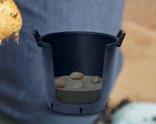

Harvest up to 30lbs of simply delicious potatoes within weeks of planting! SAVE £20.00 when you buy the Complete Kit for just £19.95!



Imagine growing the freshest, tastiest crops of delicious homegrown potatoes – all from your own patio, with no backbreaking digging whatsoever! Simply add compost and water and enjoy the unbeatable fl avour of the freshest new potatoes just 10 weeks from planting! Plant now and pick your first crops as soon as May! ITEM: 350007.
The freshest, tastiest, delicious ‘tates’ you’ve ever tasted!


6 ‘Turbo Tubers’ each of 3 varieties selected for a range of harvest dates
3 durable and reusable 30L pots AND organic fertiliser included!
Harvest in succession for 4 months from May
COMPLETE PATIO POTATO KIT
in JUST
WEEKS From Planting!
NO Digging! NO Effort! NO Garden Required! Harvest
10
COMPLETE PATIO POTATO KIT
SAVE £20.00 COMPLETE PATIO POTATO KIT JUST £19.95 +P&P STEP 1 Half fill your 30L pot with compost and place your Turbo Tubers about 4” deep STEP 2 As your potato plants establish and grow, just keep topping up the compost STEP 3 Feed and water (don’t soak) for a heavy crop of delicious, tasty new potatoes HOW TO PLANT, GROW AND ENJOY IN 3 SIMPLE STEPS! SAVE £20! YOUR COMPLETE KIT INCLUDES:
Includes: 6 turbo tubers each 3 varieties of seed potatoes - Charlotte, Pentland Javelin and Desiree, 3 Heavy Duty 30L Pots and 1Kg Organic Potato Fertiliser NOW ONLY £19.95 SAVE £20.00!
Seed Potato
• 18
‘Turbo Tubers’ (6 x 3 varieties) Normally £5.99 each
• 3 Heavy Duty 30L Pots Normally £14.99
– just
weeks from planting.
soft new potatoes.
Delivery to UK only and a £6.00 surcharge will apply to the following postcode areas: AB, DD8-11, GY, HS, IM, IV, JE, KA27-28, KW, PA20-80, PH19-50, TR21-25
© YouGarden Ltd 2022
• 1kg Organic Potato Fertiliser Normally £6.99 Charlotte
All-time-favourite variety! Perfect as a new potato in salads or for boiling. Desiree
Red skin, yellow flesh. Great for boiling, mashing or as jackets with lovely crisp skin. ‘Pentland Javelin’ (Early) Fast cropper
10
Abundant, gorgeous,
Orders despatched within 7 working days.
& ZE. Offer subject to availability and in the event that this offer is oversubscribed, we reserve the right to send suitable substitutes. Images show mature plants. See website for full product details and T&Cs. Following Brexit there are a number of changes that prevent us from trading in N. Ireland. For further details please visit www.yougarden.com. Offer available while stocks last.
DOUBLE GUARANTEE to you! 2 EASY WAYS TO ORDER NOW! www.YouGarden.com/RD102 USE CODE RD102 Calls cost 5p per min plus your network’s access charge. 0844 502 0050 NEED A REFILL? POTATO ‘TOP UP’ COLLECTION £16.96 -
My
SAVE £8! ITEM: 350062

THE SOUVENIR: PART II
Two years after the release of the critically acclaimed art house drama The Souvenir, director Joanna Hog returns with the equally yearning if not more lacerating follow up. Let us refresh your memory: in Part I, we watched the slow disintegration of a toxic relationship between a young film student, Julie (the moodily dreamy Honor Swinton Byrne), and her manipulative drug addict boyfriend, Anthony (the evercharming Tom Burke). Contemplative and enigmatic in a quietly depressing sort of way, the film culminated in Anthony’s death from a heroin overdose in a public toilet.
Part II finds Julie recuperating from her loss and turning her final film school project into a memorial for her troubled partner. As spellbinding and poetic as its predecessor, the film dives even
deeper into nightmarishly surreal art sequences reminiscent of The Red Shoes. As she works through her trauma and searches for her voice as a filmmaker, Julie takes on the role of passive observer: detached from the speeding world around her and emotionally numb, she just lets the pain wash over her as she takes pictures and blankly stares into space.
Part II is beautifully slow and elegiac, adorned with dragged out sequences of mesmerising nothingness, like some of Tarkovsky’s greatest moments—yet there’s something uncomfortably miasmic and stagnant about it, now that it’s devoid of Anthony’s exhilarating presence. Nevertheless, it’s an engrossing piece of cinema which includes one of the greatest final scenes we’ve seen in recent years.
By Eva Mackevic
READERSDIGEST.CO.UK/CULTURE 118 • FEBRUARY 2022 FILM
© PICTUREHOUSE ENTERTAINMENT
H H H H
H
Mother-Daughter Duos
Honor Swinton Byrne is the daughter of the great Tilda Swinton who plays her mother in both Souvenir movies. Here are some other famous motherdaughter duos who have appeared together on screen…

MIA FARROW and MAUREEN O’SULLIVAN
The two played mother and daughter in Woody Allen’s classic 1986 comedy, Hannah and Her Sisters. Maureen was a famous IrishAmerican actress best known for portraying Jane in MGM’s Tarzan series of films of the 1930s and 40s, and was listed at Number Eight on The Irish Times list of Ireland’s greatest film actors in 2020.

LENA DUNHAM and LAURIE SIMMONS
Laurie is a US artist, photographer and filmmaker who appeared in her daughter Lena’s debut film, Tiny Furniture, which was inspired by her mother’s art career. Lena made the film using her parents’ money and asking her friends and family to be part of it. Her real-life sister Grace also makes an appearance.
MELANIE GRIFFITH and TIPPI HEDREN

LAURA DERN and DIANE LADD
Diane Ladd famously played Laura’s overbearing mother in David Lynch’s 1990 cult classic, Wild at Heart—a delightfully tacky story of young lovers on the run. However, it wasn’t the first or the last film that they’d been in together. With 1991’s Rambling Rose, they became the first mother-daughter duo to earn Oscar nominations for their roles in the same film.
Tippi achieved worldwide recognition for starring in two of Alfred Hitchcock’s classics: The Birds and Marnie, and is now one of the last surviving stars from the Golden Age of Hollywood cinema. She co-starred with her daughter Melanie in 1981’s Roar: one of the “most dangerous films ever made”. During filming, Griffith was mauled by one of the lions on set and had to have facial reconstructive surgery.

FEBRUARY 2022 • 119
2019’s starry murder-mystery
Knives Out was one of Hollywood’s last pre-pandemic hits, but following it has taken time: knotty plots don’t grow on trees, and COVID made it hard to squeeze ensembles into drawing rooms. TV, thankfully, has stepped up to sate the armchair sleuth. Only Murders in the Building (Disney+), one of last year’s highlights, pairs series co-creator Steve Martin with Martin Short and Selena Gomez as nosy neighbours who investigate a death in their chichi Manhattan apartment block, less out of a sense of existential threat than as something to do in the afternoons. While initially light in tone—there are podcast jokes—its mystery soon deepens, and Martin’s late-life romance with cellist Amy Ryan introduces notes of real poignancy. Classy, old-fashioned entertainment, of a kind you may have thought had died off. Where Only Murders… does

one thing (witty, literate character comedy) skilfully, The Afterparty (Apple TV+) succeeds in being many things at once. Overseen by The Lego Movie’s Christopher Miller, its hook is that every suspect in the murder of bratty popstar Xavier (Dave Franco) gets their own episode in their own genre—so lovelorn Aniq (Sam Richardson) offers his alibi in romcom form, while growling bully Brett (Ike Barinholtz) rips through a Fast & Furious-style action movie. Something for everyone, then: as detective Tiffany Haddish puts it, “My goal is to find out who killed Xavier. But it’d be nice to have some fun in the process.” She does; we do, too. It’s a funny, clever puzzle-show, pivoting on scenes that assume new meanings when revisited from different angles. Don’t try and work out how they got it all to fit together. Just be grateful that they did.
by Mike McCahill

Retro Pick:
MonkS1-8 (PrimeVideo)
This century’s worthiest inheritor of Peter Falk’s Columbomantle? Tony Shalhoub, note-perfect (and Emmy-winning) as an OCD-dogged detective.
TELEVISION
120 • FEBRUARY 2022
The Sound Of Love
This Valentine’s Day, the Reader’s Digest columnists reveal their favourite love songs
James Walton, Books “Brown Eyed Girl” by Van Morrison. A song that brilliantly captures both the sheer excitement of young love and the melancholy that comes with looking back on it. Plus, you can dance to it—or, rather, you can’t not.
Susannah Hickling, Health “What Other Guy?” by Adam Cohen. Once, when I was dating a guy who was very undemonstrative, I went to France to see family. While I was away, he sent me Adam Cohen’s “What Other Guy?” and said it reminded him of me. It’s a very intimate song and, coming from this guy who was so closed about his feelings, I felt it was a very romantic gesture. I played it over and over at the campsite where I was staying. I’d never imagined that he’d miss me, but it was clear he did.
Olly Mann, “It’s A Mann’s World” “Mr Harris” by Aimee Mann. Most 20th-
century songs about agegap relationships feel unsavoury these days. But “Mr Harris” by Aimee Mann, from 1993, remains a delight. It’s delivered from the perspective of a younger woman to a much older man (“His hair is white but he looks half his age / He looks like Jimmy Stewart in his younger days”), and it’s got the kind of melody that sticks in your head for days. My wife is actually only one month younger than me, but I’d love her to feel this way about me one day!
Jenessa Williams, Beauty “Don’t Delete the Kisses” by Wolf Alice. Blending cinematic guitars with a deep narrative storytelling, Wolf Alice’s “Don’t Delete the Kisses” is the perfect dose of nostalgia-capture from those early days of fresh love, with all the heartpounding uncertainties and possibilities that they entail. It doesn’t necessarily ride off into the sunset the way that
traditional love songs do, but its soaring chorus is a reminder to hold nothing back in the pursuit of telling that special someone how you really feel.
Jonathan Hancock, Memory “I Love You Always Forever” by Donna Lewis. It’s a happy, catchy pop tune about the simplicity of love. And it came out around the time I met my wife Lucy, so it’s full of lovely memories—and still how I feel, 25 years on!
Richard Mellor, Travel “Just Like Heaven” by The Cure. Behind their punky sound, there’s always something fiercely tender about The Cure’s music. “Just Like Heaven” is my favourite: a beautifully intimate relationship is portrayed over an irresistible melody before, heart-breakingly, the bubble bursts. “Why won’t you ever know… that I’m in love with you?” I reliably cry every time.
MUSIC 121 FEBRUARY 2022 •
February Fiction
A tale of intrigue and deception is our pick for February’s page-turner
WhateverGetsYou ThroughtheNight
by Charlie Higson (Little, Brown, £14.99)
Since his Nineties TV triumph as the co-creator of The Fast Show, Charlie Higson has been best known for his thrillers aimed at younger readers. Particularly successful—and rightly so—was a series featuring James Bond as an Eton schoolboy already saving the world on a regular basis.
In his first adult thriller for 11 years (and just his second in the last 25), Higson throws in plenty of old-school nods to 007: among them a car chase, a boat chase and a villain with a mountaintop lair. But he also

James Walton is a book reviewer and broadcaster, and has written and presented 17 series of the BBC Radio 4 literary quiz
The Write Stuff

combines them with such up-todate concerns as internet conspiracy theories and the sexual grooming of adolescent girls.
The setting is pre-pandemic Corfu where sinister billionaire Julian Hepworth is using that lair of his as a girls-only tennis school/breeding ground for sexual exploitation. So can the slightly enigmatic good guy McIntyre and his tough-but-sexy sidekick Aimee penetrate Hepworth’s supposedly impenetrable security and rescue the captives?
But, as it transpires, all this is just for starters in a novel packed with several subplots, a large and varied cast of supporting characters and thoughts on everything from the Greek debt crisis to the distorting effects of social media (one of the book’s intriguing ideas is that people like Hepworth deliberately spread conspiracy theories in order to
BOOKS
122 • FEBRUARY 2022
disguise what they’re actually up to— which isn’t a bad conspiracy theory in itself).
For a while, in fact, it seems as if Higson might bitten off more than he can chew, as we hurtle from one apparently unrelated incident to the next, pausing only to hear further information about how the world really works. Gradually, however, the links between these components tighten in a richly satisfying way, until the book reaches an exhilarating extended climax at a spectacular party thrown by Hepworth to show everyone how great he is (spoiler alert: it doesn’t quite work out that way).
All in all, my confident prediction is that any readers whose hearts might have sunk a bit as yet another new character appeared in the first third of Whatever Gets You Through the Night will be thumping with excitement long before the end.
Name the character
Can you guess the fictional character from these clues (and, of course, the fewer you need the better)?
1. In the book of that name, he lives in the House at Pooh Corner.
2. He was an acknowledged influence on Marvin the Paranoid Android in Douglas Adams’s The Hitch-Hiker’s Guide totheGalaxy.
3. He’s a donkey.
Paperbacks
ThePowerofHope
by Kate Garraway (Penguin, £8.99). The broadcaster’s unsparing memoir about her husband Derek Draper’s devastating—and continuing—long-COVID, which began in March 2020.
TheRoadTrip
by Beth O’Leary (Quercus, £8.99). Addie and her ex have to share a long journey to a wedding two years after their bitter break-up. A touching and funny novel from a rising star.
Two-WayMirror:TheLifeof ElizabethBarrattBrowning
by Fiona Sampson (Profile, £9.99). Revealing biography of the Victorian poet—much more famous in her day than husband Robert.
Kitchenly434
by Alan Warner (White Rabbit, £9.99). Don’t let the deliberately low-key opening put you off this terrific, sometimes alarming novel narrated by the increasingly creepy minder of a 1970s rockstar.
Glossy:TheInsideStoryofVogue
by Nina-Sophia Miralles (Quercus, £12.99). How a magazine first founded in 19th-century New York conquered, and shaped, the fashion world.
Answer on p126
FEBRUARY 2022 • 123
READER’S DIGEST RECOMMENDED READ:
An Olympian Read
The history of exercise is a surprisingly complex one, as chronicled in this month’s recommended read
In around 400 BC, the Greek physician Hippocrates (aka “the Father of Medicine”) wrote that, “Eating alone will not keep a man well; he must also take exercise.” This was a fact well understood in Ancient Greece. Every town had at least one gymnasium—some public, some requiring gym membership— and athletes’ sweat was a muchprized commodity, selling for the equivalent of thousands of pounds and used, somewhat unglamorously, for the treatment of haemorrhoids (there were also, of course, the Olympic Games).
But then came the rise of Christianity when exercise became associated with paganism and so fell out of favour. Only with the Renaissance was it rediscovered, along with much else from the classical world. In 1569, an Italian doctor called Girolamo Mercuriale published The Art of Exercise, a book full of advice that’s still recognisable
today: “We in no way dispute that exercise can sometimes be hard and, when it is being performed, unpleasant. But good health is not incompatible with some discomfort.”
Taking Mercuriale as his starting point, Bill Hayes fascinatingly traces exercise’s gradual evolution into the multibillion-pound industry it is now—by way of some genuine scientific breakthroughs and several passing crazes. He’s especially good on the growth of bodybuilding from the early 20th century to Arnold Schwarzenegger; and on how aerobics conquered the world in the 1980s when Jane Fonda did wonders for both female fitness and the sales of VCRs. He also throws in plenty of his own experiences, including as the long-time partner of the psychologist (and swimming obsessive) Oliver Sacks.
Here, though, we go back to the 19th century when, for the first time, women were about to become a major part of the story:
BOOKS
124 • FEBRUARY 2022
‘‘
The first verifiable claim for what is now called a ‘bicycle’ (a term not introduced until the 1860s) belongs to a German baron, inventor, and civil servant, Karl von Drais, who invented his Laufmaschine (German for ‘running machine’) in 1817. Drais conceived of it as an alternative to horses, which had become scarce due to recent crop failures. His woodframed machine—the first patented, two-wheeled, steerable, humanpropelled vehicle—was intended not for exercise or recreation but for transport—and emphatically meant for men alone. Its wheels were iron. It did not have pedals and a chain; instead the rider propelled it forward by pushing off the ground with one foot, then the other.
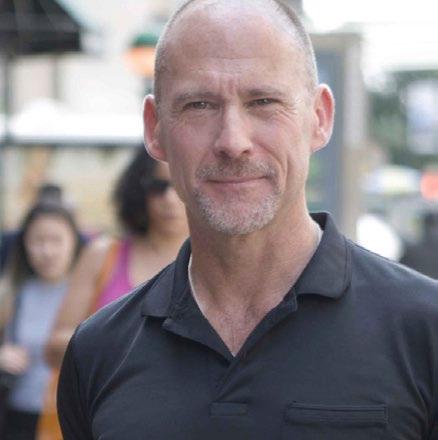
Variations of Drais’s invention would follow over the next 75 years. Some were built with three wheels to make them more stable and some with four. Pedals were introduced— an advance over scooting along
Sweat:A Historyof Exercise by Bill Hayes is published by Bloomsbury at £20
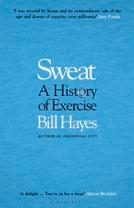
with your feet—but so too were extremely large front wheels paired with small back wheels, which meant your feet were far above the ground. Commonly known as ‘high wheels’ or ‘penny-farthings’, these models could be ridden at faster speeds—an obvious advantage—but were also less stable.
The real breakthrough didn’t come until the 1880s, with the introduction of the ‘safety bicycle’, so called for being safer to ride than the high wheelers they quickly replaced. Safety bicycles came with two spoked wheels of roughly equal size—short enough that a rider’s feet could touch the ground—and closely resembled the bicycles we ride today. They prompted a dramatic shift in how bicycles were used and by whom. These were no longer considered dangerous toys for men and boys— novelties, really—but increasingly
FEBRUARY 2022 • 125
as a legitimate form of transport and recreation, and most radically, as suitable even for women.
By the 1890s, a ‘ladies’ version had been designed; it had a step-through frame, without the high horizontal bar linking back wheel to front, so that women could more easily mount and ride their bikes, and could be purchased with a ‘skirt guard’, which prevented long skirts from becoming entangled in the rear wheel and chain. The very parts such garments covered up in public (the glutes, quads, hamstrings, and calves) were those worked most strenuously in cycling— muscles most women had never had the opportunity to strengthen and develop as effectively before.
To my mind, it’s not an exaggeration to say that this was one of the most significant advances to date in the history of exercise for women and girls worldwide. The link between these new femalefriendly bikes and the burgeoning women’s suffrage movement was undeniable, as the great American women’s rights activist Susan B Anthony so eloquently observed in 1896: ‘The bicycle has done more for the emancipation of women than anything else in the world. It gives women a feeling of freedom and self-reliance. I stand and rejoice every time I see a woman ride by on a wheel… the picture of free, untrammelled womanhood.’
Bill Hayes’s Top Three Exercise Books and Videos
JaneFonda’sWorkout(video available on streaming platforms). Don’t let the 1980s leg warmers fool you: Fonda’s original Workout video hasn’t dated one bit. In fact, the pandemic has made it even more timely for exercising at home.
TotalImmersion by Terry Laughlin: While readingabout swimming isn’t a substitute for actually swimming, this insightful guide is filled with terrific tips and drills that translate easily to the pool.
TheSecrettoSuperhuman Strength by Alison Bechdel
The brilliant cartoonist traces her own history of (sometimes obsessive) exercise in this stunning graphic memoir.

Answer to Name the Character:
Eeyore, the famously miserable donkey in the Winnie-the-Pooh books by AA Milne (sample quote: “I make it 17 days come Friday since anybody spoke to me”). Douglas Adams was a big Milne fan as a boy.
BOOKS ’’
126 • FEBRUARY 2022
Books
THAT CHANGED MY LIFE
Sophie Hannah is a British poet and novelist, hailed as “the queen of psychological suspense”. Her new book, The Couple at the Table, is published by Hodder & Stoughton, out on January 27, £16.99

The Power of Now by Eckhart Tolle This book introduced me to a new way of looking at the world, based on the idea that we suffer as a result of the stories we tell ourselves. That’s what causes all our emotional pain. For example, if your friend lets you down, you might tell yourself: “She doesn’t care about me.” And if you believed that, you’d feel awful. Tolle points out that if we avoid interpretations, the only truth might be: “My friend and I agreed to meet at seven. It’s now eight and she’s not here yet.” That’s just a statement of fact, and could have any number of meanings ascribed to it, many of which wouldn’t be upsetting.

The Black Prince by Iris Murdoch I can honestly say that, despite having studied English Literature at university, I was unaware of the richnesson-all-levels-simultaneously that a novel could achieve until I read TheBlackPrince. It’s as much of a fun thrill-ride as it as a serious philosophical examination of human nature. It’s about love, betrayal, divided loyalties, rivalry, ambition and the heartbreaking ludicrousness of everyday life. Only at the end of the book do we discover that it’s also a highly original mystery novel. Murdoch’s characters and her dialogue reflect, with an accuracy that is both hilarious and slightly chilling, the way people would speak if they didn’t feel obliged to mask their true, messy psyches.
The Body in the Library by
Agatha


Christie A flawless mystery puzzle story by the Queen of Crime, and the first of her novels that I ever read. I soon became an obsessive fan! Some say, “Oh, Agatha Christie’s a brilliant plotter, and her puzzles are great, but that’s all.” I believe a puzzle is the most important component of any great story. Puzzles arise as a direct result of psychological depth, because people hide things and have secret fears. Solving the puzzles of individual people is the single most useful activity you can engage in if your aim is to arrive at a deeper understanding of the world.
FEBRUARY 2022 • 127
FOR MORE, GO TO READERSDIGEST.CO.UK/CULTURE
The Story Of The Pod
James O’Malley dishes on the history of the podcast, and why it’s so popular
In the modern world, we’re being constantly bombarded with information as our days consist of switching from one screen to another. We’re watching TV as we scroll on our phones through an unending Facebook news feed, pumping a steady diet of news, opinion and distraction directly into our brains.
But what about those precious moments when we’re not able to use our phones, such as when we’re in the shower, driving or doing the washing up? The good news is that there’s another technology available that can help squash the very possibility of having our own, independent thoughts in our heads.
I’m talking, of course, about podcasting. According to research by eMarketer, roughly 14.6 million people in the UK already listen to podcasts at least once a month. And in the US, the total spending on advertising on podcasts is expected to top $1bn for 2021 alone. In other

words, podcasting is big business.
There are tens of thousands of downloadable audio shows currently in production—ranging from hobbyists in their bedroom to professional productions worked on by dozens of people at some of the biggest companies in the world.
But the strange thing is that podcasts have been around for 20 years—so why are they getting so much attention now?
Unusually, the podcast wasn’t actually invented by a big tech corporation looking to make money, but by amateur coders, looking for a new way to share audio recordings.
The problem they had was distribution. Recording audio on computers was easy by the year 2000, but unlike radio, where you can switch it on and hear the DJ talking immediately, to listen to these recordings (which were invariably mostly people chatting about niche computer programming topics), you’d need to go to a website and check for anything new.
Enter a new technology known as a
128 • FEBRUARY 2022
TECHNOLOGY
RSS—which stands for “Really Simple Syndication”. The idea was that instead of having to browse the web, you could instead add a special web address—or feed—for a show into a
THE PIVOTAL MOMENT CAME IN 2005 WHEN APPLE OFFICIALLY BUILT PODCASTING FUNCTIONALITY
INTO ITUNES
special app, later called a “podcatcher”. This would work in the background on your computer, and would periodically automatically check the feed, and download anything new. Today we’re used to our phone telling us when there’s something new without us having to check—but back then, it was completely revolutionary.
Over the next few years, podcasting began to take off. The pivotal moment came in 2005 when Apple officially built podcasting functionality into iTunes, the app that was used to copy music from computers to the then wildly popular iPod.
And after this, the wider world started to pay attention. One early pioneer was the comedian Ricky Gervais, who made a show with his Office co-writer Stephen Merchant, and radio producer Karl Pilkington.
And then fast-forward to 2021, and podcasts are everywhere, and every single vaguely famous person seems to have one. Something fundamental is changing with podcasts though.
For example, until recently despite its early support, Apple had largely left podcasts alone. And this left an opening for Apple’s music streaming rival Spotify. Starting in 2018, it began snapping up independent podcast production companies. Which started a vicious competition to acquire podcasts that the corporations could then make exclusive on their platforms.
If you’ve got a line-up of soughtafter exclusive shows to listen to, users will sign up and pay a monthly fee to you instead of your rivals.
The most high profile example of this is Spotify signing up formerMartial Artist turned podcaster Joe Rogan in a deal worth more than $100m. Rogan’s controversial show receives more than 200 million downloads a month.
And though it was inevitable, it does make me a little sad. Instead of being a big open platform, like the RSS feeds of old where anyone could have a go, podcasts are being walled off from each other. But the upside is that more money than ever is going into making podcasts. Which means that if you ever do risk experiencing a quiet moment inside your own head, there will almost certainly be something to listen to instead. n
FEBRUARY 2022 • 129
£50 PRIZE QUESTION
DO THE MATH
Replace the question marks with mathematical symbols (+, -, x and ÷) to produce the correct answer. Perform calculations in strict left to right order. Can you find two possible ways of reaching the solution?
8 ? 5 ? 11 ? 4 = 6
THE FIRST CORRECT ANSWER WE PICK WINS £50!*
Email excerpts@readersdigest.co.uk
ANSWER TO JANUARY'S PRIZE QUESTION
IN ORBIT
30 months. Rocket A travels 360 ÷
15 = 24 degrees around the circle every month. Rocket B travels 360 ÷
12 = 30 degrees around the circle every month. Hence, B gains on A by 30 - 24 = 6 degrees every month. There are 180 degrees separating them at the beginning, so it will take 180 ÷ 6 = 30 months (or 2 1/2 years) before they crash.
AND THE £50 GOES TO…
GAY JACKLIN, West Sussex
You Couldn’t Make It Up
Win £30 for your true, funny stories!
Go to readersdigest.co.uk/contact-us or facebook.com/readersdigestuk
During a short stay in hospital recently, I heard the old lady in the bed next to mine say to the nurse: “Nurse, my dinner is cold.”
To which the nurse replied, “It should be—it’s a salad.”
ROBERT PERRY, via email
My friend's husband, Paul, made us laugh recently when we were talking about shopping. He said that he always does his shopping online, adding, "I think it would be frowned upon to be in a store with no top on, sweatpants and a glass of beer in hand”.
KENDRA SEVILLE, Birkenhead
It took our five-year-old son's comment while out driving, "How many idiots are there on the motorway today, Dad?", to make my husband realise that he probably needs to tone down his attitude towards other motorists!
JOSH TAYLOR, Moray
130 • FEBRUARY 2022
FUN & GAMES

"HAPPY
I was explaining to a friend how I had fallen over and broken a bone in the little finger of my left hand. "It doesn't affect me that much," I said, "but if I played the violin, I would be really annoyed."
At this point, my husband interjected, "If you played the violin, I would be really annoyed too."
SUSAN PHUNG, Surrey
I was running late for my appointment with a high street optician and, as I was running, my phone rang, further adding to my flustered state and distracting me. I hung up as I quickly entered the shop and breathlessly announced, “I'm so sorry I'm late, I'm here for my eye test.”
“And you need one, too,” came the quick response, “This is Phones4u!”. The optician was next door!
NICOLA WHITTLE, Bath
cartoon by Guto Dias
I make my own Scotch eggs and my neighbour Erik loves them. The other day I was trying to explain to him how I make them, so I told him that that I boil the eggs first, then squash some sausage meat together, wrap it round them, and bake them in the oven.
The next day he said that they were too crunchy—turned out he hadn't taken the shells off the eggs first!
JANE WHITAKER, Kent
Sitting in the living room during a visit to my parents’ home one winter, I mentioned I could feel a bit of a draught.“Yes, haven’t you noticed?” Dad replied. “There’s a dog-shaped hole in the French window.” Our springer spaniel, Hector, had spied a cat outside and ran straight through the glass to chase it!
RHIANNON LEWIS, Monmouthshire
FEBRUARY 2022 • 131
VALENTINE'S DAY DEAR!"
It’s never been easier to enjoy the world’s favourite magazine!









YES I want to subscribe to Reader’s Digest Magazine for just £3 for 3 issues (a saving of £8.37 on the shop price of £11.37 based on the cover price of £3.79 per issue). I understand that if I do not wish to continue receiving Reader’s Digest after my first 3 issues I can simply cancel my subscription by contacting customer services. If I do want to continue to subscribe after my first 3 issues I need do nothing and my subscription will automatically be renewed at the low rate of £7.50 for every 3 issues until I decide otherwise.



Please complete direct debit mandate below Name of Bank ...................................................................... Account Holder Branch: / / Account No Instructions to your bank or Building Society: Pay Reader’s Digest Direct Debits from the account detailed on this instruction subject to the safeguards assured by the Direct Debit Guarantee. I understand that this instruction may remain with Reader’s Digest and if so will be passed electronically to my Bank or Building Society. Signature ..................................................................... Date .............................................................................. INSTRUCTIONS TO YOUR BANK OR BUILDING SOCIETY TO PAY BY DIRECT DEBIT. Originators reference: 400162
Address: Postcode: Telephone: Email:
films,
alongside
profiles.
Name:
Each must-read monthly issue covers life, culture, health, books,
food, humour and travel
in-depth news features, memoirs and celebrity
Sort Code Data Protection: From time to time Reader’s Digest may contact you with details of its products and services. Please tick here if you object to receiving such information Return your completed form to: Reader’s Digest, The Maltings, West Street, Bourne PE10 9PH Or call us today on 0330 333 2220 Quoting code RDN095
3 ISSUES FOR JUST £3!
Word Power
“We shape our tools,” wrote media theorist Marshall McLuhan, “and then our tools shape us.” This month we highlight some indispensable devices and celebrate the ways in which they’ve shaped our language
BY ROB LUTES
1. averruncator—A: manual posthole digger. B: instrument for pruning trees. C: press for crushing grapes.
2. chamois—A: cloth to strain whey in cheese making. B: cast-iron frying pan. C: porous leather used for polishing.
3. cauf—A: large box with holes for keeping fish alive in water. B: trowel for smoothing concrete. C: curved knife for gutting fish.
4. punch—A: heated press for bookbinding. B: rod for driving nails below a surface. C: rotary tool to cut round holes in walls.
5. maul—A: mallet used to strike a gong. B: wedge-shaped hammer. C: small screwdriver.
6. square—A: device for testing right angles. B: fastener in house-frame construction. C: box for brick moulding.
7. douter—A: candle snuffer. B: device that creates texture in plaster finishes. C: needle for stitching leather.
8. hawser—A: handsaw. B: catapult used to feed farm animals. C: rope used to moor or tow a boat.
9. plench—A: tool combining pliers and a wrench. B: chisel to cut grooves. C: shovel for trench digging.
10. burin—A: hand-operated coffee grinder. B: camping stove. C: pointed tool for engraving.
11. trowel—A: flat-bladed hand tool. B: tripod used in land surveying. C: hook on which to hang fowl before cooking.
12. tamis—A: wire brush for cleaning rifles. B: drum-shaped mesh strainer. C: vise for bending wood.
13. rasp—A: excavation tool. B: peeler to remove orange skin. C: large-toothed file.
14. caliper—A: device to hold boards during milling. B: machine for sheep grooming. C: instrument for measuring thickness or width.
15. shears—A: fittings used to regulate water flow. B: cutting tool. C: riding whip with braided lash.
FEBRUARY 2022 • 133 FUN AND GAMES
IT PAYS TO INCREASE YOUR
Answers
1. averruncator—[B] instrument for pruning trees. The arborist used an averruncator to cut the dogwood branches brushing the shed roof.
2. chamois—[C] porous leather used for polishing. Ashok used the chamois to buff his red Chevy to a streakless shine.
3. cauf—[A] large box with holes for keeping fish alive in water. His cauf full of live carp for bait, Urban felt confident he would catch the catfish he was after.
4. punch—[B] rod for driving nails below a surface. After hammering together the shelves, Giles used a punch to hide the flatheads.
5. maul—[B] wedge-shaped hammer. Aim the blade of your maul in the same direction as any hairline cracks in the log.
6. square—[A] device for testing right angles. According to the square, the corners of the shed were at precisely 90 degrees.
7. douter—[A] candle snuffer. When the power came on, the kids fought over who would use a brass douter to extinguish the candles.
8. hawser—[C] rope used to moor or tow a boat. The hawser held firmly as we hauled the freighter into Boston Harbour.
9. plench—[A] tool combining pliers and a wrench. Knowing she needed to remove several tricky fasteners, the astronaut took a plench with her on her spacewalk.
10. burin—[C] pointed tool for engraving. Pam’s hands cramped up after hours of using the burin to carve her name on a copper sheet.
11. trowel—[A] flat-bladed hand tool. Ciprian drove the trowel into the soil and levered it back and forth to create a slot for the bulb.
12. tamis—[B] drum-shaped mesh strainer. Sandro sifted the almond flour with a tamis.
13. rasp—[C] large-toothed file. Vassili shaped the cabinet’s contours with a rasp, then sanded them to a fine finish.
14. caliper—[C] instrument for measuring thickness or width. Not having faith in the inspector’s report, Eleanor checked the diameter of every pipe with her caliper.
15. shears—[B] cutting tool. Clint rinsed his herbs, then used the shears to chop them into bits right into the recipe.
7–10: fair
11–12: good
13–15: excellent
VOCABULARY RATINGS
WORD POWER
134 • FEBRUARY 2022
TRIVIA
By Beth Shillibeer
1. What was the first non-Englishlanguage film to win Best Picture at the Academy Awards?
2. What charitable goal did IrishAmerican billionaire Chuck Feeney achieve in 2020?
3. Beethoven and Mozart wrote music for it, but who invented the glass harmonica?
4. Claudia Sheinbaum Pardo is a physicist, Nobel Peace Prize recipient and mayor of what city?
5. What country invented White Day, celebrated March 14, as a way to express gratitude for Valentine’s Day gifts?
6. Blondes are said to have more fun, but do they have more hair follicles?
7. Which essential 20th-century writing implement is now considered a relic of the past?
8. The largest of its kind in the world, what festival features figurehead King Momo, blocos and samba dancing?
9. Astronomers in the US and the UK have observed space clouds composed of what intoxicating substance?
10. On a cold winter day, the subnivean zone, under snow, typically maintains what temperature?
11. Who did Sir Arthur Conan Doyle get rid of so he could spend more time with his wife and ski in Switzerland?
12. Sweden claims to have 267,570 of what geographical feature, the most in the world?

13. With over 6 million participants nationwide, what is Australia’s favourite sport?
15. Which Italian city banned cruise ships from its harbour in 2021 due to their environmental and social impacts?
14. What kind of animal was Abul-Abbas, who trekked the Alps to live with Charlemagne in the ninth century?
11. Sherlock Holmes. 12. Islands. 13. Swimming. 14. An elephant. 15. Venice.
Answers 1. Parasite (South Korea). 2. Giving away his fortune while still alive. 3. Benjamin Franklin. 4. Mexico City. 5. Japan. 6. Yes (to better protect the scalp from UV rays). 7. The typewriter. 8. Rio’s Carnival. 9. Alcohol (methyl alcohol, specifically). 10. About 0 degrees Celsius.
Photo: ©getty images
FEBRUARY 2022 • 135
Tents & Trees
How to play:
At this camping site each tent is adjacent to its own tree, either horizontally or vertically. Tents are not adjacent to each other, not even diagonally. The numbers outside the grid indicate how many tents are in that row or column. Locate all tents.
Numbers
How to play:
Enter the numbers 1- 9 into the grid, so that any two numbers connected with a line will have a difference of at least 3.
Two numbers are given.
2 3 1 2 1 3 2 1 3 2 1 2 1 3 2 1 3 2 2 1
5 2
ExamplE: 9 6 4 1 136 • FEBRUARY 2022
ExamplE:
FUN & GAMES
2 0 1 1 2 0 1 1
BRAIN TEASERS
How to play:
Insert the digits 1 to 6 just once in each a) row, b) column, c) bold outlined area and d) white or grey rectangle. BEwarE! The bold outlined areas are no longer 2x3!
www.sixysudoku.com
and a free app puzzles © pzzl.com
Visit
for books
ExamplE: sixy2202_01 Type: [ 1] 5 5 4 4 1 1 3 6 2 3 6 2 5 4 1 1 2 2 4 4 6 6 5 3 6 5 5 3 1 2 4 4 4 1 1 5 2 2 3 6 2 3 6 6 4 1 5 sixy2202_02 Type: [ 1] 6 2 2 3 1 5 4 4 1 5 5 2 3 6 6 5 3 4 6 1 2 1 6 2 5 4 4 3 3 5 5 6 4 2 2 1 2 4 1 1 3 3 6 5 SUD_Sixy_H_D_032b Sudoku: numbers 1 - 6; excl. diagonals; level B7_5 1 3 4 2 5 6 5 2 2 6 3 4 4 1 4 6 5 5 1 3 3 2 2 1 3 4 6 5 5 6 6 4 2 5 1 3 3 5 1 1 6 2 4 sixy2202_06 Type: [ 7] 1 1 4 2 5 2 6 3 2 5 4 3 1 2 6 4 6 5 sixy2202_03 Type: [ 1] 4 6 2 5 3 1 1 3 5 5 1 4 2 6 6 2 1 3 3 6 4 5 5 4 6 6 3 1 2 6 2 4 1 5 5 3 1 3 5 2 2 6 4 sixy2202_05 Type: [ 3] 1 1 3 5 4 4 6 2 2 6 6 4 1 5 3 3 5 4 FEBRUARY 2022 • 137
1 3 5 2 4 6
SIXY SUDOKU
CROSSWISE Test your general knowledge. Answers on p142 ACROSS 1 Fly traps (7) 5 Man’s felt hat (7) 10 Separate article (4) 11 Of the highest calibre (5-5) 12 Very large woman (8) 13 Sister’s daughters (6) 15 Lovesick glances (6,4) 18 Consumes (4) 19 Where Paddington originated (4) 21 Brave (10) 24 Hedge plant (6) 26 Earthy (8) 28 Luxury London hotel (10) 29 Covetousness (4) 30 One who views things as they are (7) 31 Silly talk (7) DOWN 2 Fast-running bird (7) 3 The distaff side (5) 4 Stereotypical cowboy characteristic (3,4) 6 Ancient (5) 7 Viewpoint (9) 8 Esteem (7) 9 Skills (4) 14 Gaze (4) 16 Deliberately ambiguous (9) 17 Berkshire public school (4) 20 Body part pierced for rings (7) 22 Flight personnel (7) 23 Disentangle (7) 25 Corners (5) 26 Aquae Sulis, in Somerset (4) 27 Give up (5) 138 • FEBRUARY 2022 BRAINTEASERS
FEBRUARY 2022 • 139 READER’S DIGEST 3 6 1 4 2 5 sixy2202_06 Type: [ 7] 1 1 4 3 2 2 5 6 5 2 1 6 4 3 6 3 4 5 2 1 2 5 6 3 1 4 4 3 1 2 2 4 6 6 5 4 6 5 5 1 3 2 sixy2202_03 Type: [ 1] 4 6 2 5 3 1 1 3 5 5 1 4 2 6 6 2 1 3 3 6 4 5 5 4 6 6 3 1 2 6 2 4 1 5 5 3 1 3 5 2 2 6 4 sixy2202_05 Type: [ 3] 1 1 3 4 6 2 5 5 4 4 2 3 1 6 6 2 5 1 4 3 2 6 6 3 4 5 1 4 1 6 5 5 3 3 2 3 5 1 2 6 4 4 sixy2202_02 Type: [ 1] 6 2 2 3 1 5 4 4 1 5 5 2 3 6 6 5 3 4 6 1 2 1 6 2 5 4 4 3 3 5 5 6 4 2 2 1 2 4 1 1 3 3 6 5 SUD_Sixy_H_D_032b Sudoku: numbers 1 - 6; excl. diagonals; level B7_5 1 3 4 2 5 6 5 2 2 6 3 4 4 1 4 6 5 5 1 3 3 2 2 1 3 4 6 5 5 6 6 4 2 5 1 3 3 5 1 1 6 2 4 sixy2202_01 Type: [ 1] 5 5 4 4 1 1 3 6 2 3 6 2 5 4 1 1 2 2 4 4 6 6 5 3 6 5 5 3 1 2 4 4 4 1 1 5 2 2 3 6 2 3 6 6 4 1 5 5 2 9 4 1 7 3 8 6 2 3 1 2 1 3 2 1 3 2 1 2 1 3 2 1 3 2 2 1 Tents & Trees Numbers SIXY SUDOKU ANSWERS BRAIN TEASERS ANSWERS
Laugh!
WIN £30 for every reader’s joke we publish!
Go to readersdigest.co.uk/contact-us or facebook.com/readersdigestuk
What’s the first sign of Madness? The “heavy heavy monster sound.”
Comedian OLAF FALAFEL
I went to that Action Man boxing match last week. Nothing below the belt.
AMANDA SMITH, Wrexham
Why did the man break into song? He couldn’t find the right key.
Seen on Twitter
My psychiatrist told me I was crazy, and I said I wanted a second opinion. He said, “OK, you’re ugly too.”
Comedian RODNEY DANGERFIELD
My neighbour’s front door doesn’t have a number on it.
I feel like that’s something that needs to be addressed.
Comedian CHRIS SCHMIDT
I saw a packet of gummy worms the other day that said, “No artificial flavouring” on the packet.
Who buys gummy worms hoping they’ll taste as close to real worms as possible?
Comedian MATT JENKINS
Last week my therapist told me that I need to learn to live in the moment.
I haven’t stopped thinking about it since.
Comedian KEVIN L SCHWARTZ
In the song “Silent Night”, does it bother anybody else that the baby
140 • FEBRUARY 2022
FUN & GAMES
Where does a mansplainer get his water? FROM A WELL, ACTUALLY!
Submitted via Facebook
Jesus is described like a tasty chicken wing? “Tender and mild” is not a saviour, it’s a savoury flavour.
Comedian ZACH FUNK
My wife’s favourite genre of movie is “stuff that isn’t on any of the four apps we already pay for every month so we’ve got to spend £3 to watch it.”
Comedian ADAM COZENS
I’ve written a musical called Fish. It’s similar to Cats, but the song “Memory” is a bit shorter.
Submitted via email
Lucy in the sky with diamonds. Worst game of Cluedo ever.
Seen on Twitter
Can somebody please tell me what the lowest military rank is?
Every time I ask somebody they say, “it’s Private.”
Submitted via Twitter

Kissing Cuties
THESE ADORABLE PHOTOS SHOW SOME FURRY FRIENDS FEELING THE LOVE THIS VALENTINE’S DAY via boredpanda.com


FEBRUARY 2022 • 141
The sky was looking ominous so I asked Siri, “Surely it’s not going to rain today?”
She replied, “Yes it is, and don’t call me Shirley!” That’s when I realised that I had left my phone on Airplane mode.
Submitted via Twitter
I got my coronavirus PCR test back today, and it says “50”. Anybody know what that means? Also, my IQ test came back positive.
Seen on Facebook
My wife asked me to go and get six cans of Sprite from the cornershop. It was only when I got home that I realised I had picked seven up.
Seen on Reddit
Recently a fortune teller told me that in about 12 years I would suffer a terrible heartbreak. To cheer myself up I just bought a puppy!
ELLA SHARP, Cambridge
My boyfriend told me that he would leave me if I didn’t stop comparing everything to Bruce Willis movies, but you know what they say about old habits… They Pulp Fiction.
Seen on Reddit
Did you know that the eyes are the final part of the body to expire? The pupils dilate.
Seen on Twitter
CROSSWORD ANSWERS
Who Wants To Be A Trillionaire?

Twitter users share what they’d do as trillionaires
@RolliPoli21: I’d have Jeff Bezos personally deliver my Amazon purchases.
@FighyaLenz: I’d buy a rodeo. Then I’d buy another rodeo, just so I could say, “This isn’t my first rodeo”.
@LMitzz6012: I’d buy the world’s supply of guacamole and stand outside burrito places giving it away for free.
@MaxHustles: I’d hire Morgan Freeman to follow me around narrating my life.
@FredKoPecki: Instead of an alarm clock, I’d hire Bruce Springsteen and the E Street Band to live in my house and play “Born to Run” every morning to wake me up.
Across: 1 Cobwebs, 5 Homburg, 10 Item, 11 World-class, 12 Giantess, 13 Nieces, 15 Sheeps’ eyes, 18 Eats, 19 Peru, 21 Courageous, 24 Privet, 26 Barnyard, 28 Dorchester, 29 Envy, 30 Realist, 31 Twaddle
Down: 2 Ostrich, 3 Women, 4 Bow legs, 6 Olden, 7 Belvedere, 8 Respect, 9 Arts, 14 Peer, 16 Equivocal, 17 Eton, 20 Earlobe, 22 Aircrew, 23 Unravel, 25 Trees, 26 Bath, 27 Yield
LAUGH
142 • FEBRUARY 2022
Beat the Cartoonist!

Think of a witty caption for this cartoon—the three best suggestions, along with the cartoonist’s original, will be posted on our website in mid-February.
If your entry gets the most votes, you’ll win £50.
Submit to captions@readersdigest.co.uk by February 7. We’ll announce the winner in our March issue.
DECEMBER WINNER

Our cartoonist’s caption, “Oh no, I’ve lost my sense of smell” failed to beat our witty reader Mary Tappenden this month, who won the vote with her caption, “Jokes on you— I’ve got a cold!” Congratulations Mary!
cartoons by Royston Robertson

One of the greatest actors in British history opens up about her life and astounding career

The music legend on learning to play the piano, life in Cornwall, and Led Zeppelin
READER’S DIGEST FEBRUARY 2022 • 143
I
IN THE MARCH ISSUE
REMEMBER…
Discover the fascinating world of Victorian “plant hunters” + BOLD BOTANISTS
Judi Dench
Tori Amos
A Century Of Change
In celebration of our centenary, we’ll be looking at how the world has changed over the last 100 years throughout all of 2022, starting with our very own magazine…
After regularly reading magazines while recovering from a shrapnel injury from serving in the First World War, a novel idea came to a young William DeWitt Wallace.
He desired to make a magazine that published 31 articles from leading publications (one for each day of the month), all condensed for clarity, and selected especially for their overall interest.
He would consider three vital questions when looking for articles to include in the magazine: Is it quotable? Is it applicable? Is it of lasting interest? And from this golden trinity of considerations, Reader’s Digest was born.
Together with his wife Lila Bell, Digest was co-founded in 1921, with the first ever issue publishing in February 1922. They promoted it through direct mail, and it quickly proved a hit with American readers.
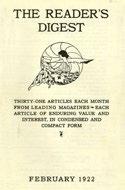

Many thousands of people would subscribe within a few years. Now, it’s published in 23 countries, and in 12 languages (including Slovenian and Cantonese). Of course, in 1922 there was no equivalent Digest on British shores, and it took until March 1938 for the UK edition to hit shelves. Subsequently, over 1,000 issues have been published, with the copy you’re holding in your very hands being the latest in a since unbroken line of publishing. In recent times, Reader’s Digest has become widely read online, and is available to read as an e-mag. Social media has also expanded the Digest’s reach and ensured that people can stay in touch with the magazine with greater ease.
One of the motivating forces behind Digest was to inject brightness and hope to the world through invigorating and uplifting articles. And that’s something that hasn’t changed, with recent features in our pages including an interview with Dr Edith Eger, a psychologist who survived the Holocaust, while another moving piece interviewed the heroes, activists, and survivors of the Grenfell tragedy. Thank you for your readership. n
144 • FEBRUARY 2022
100 YEARS
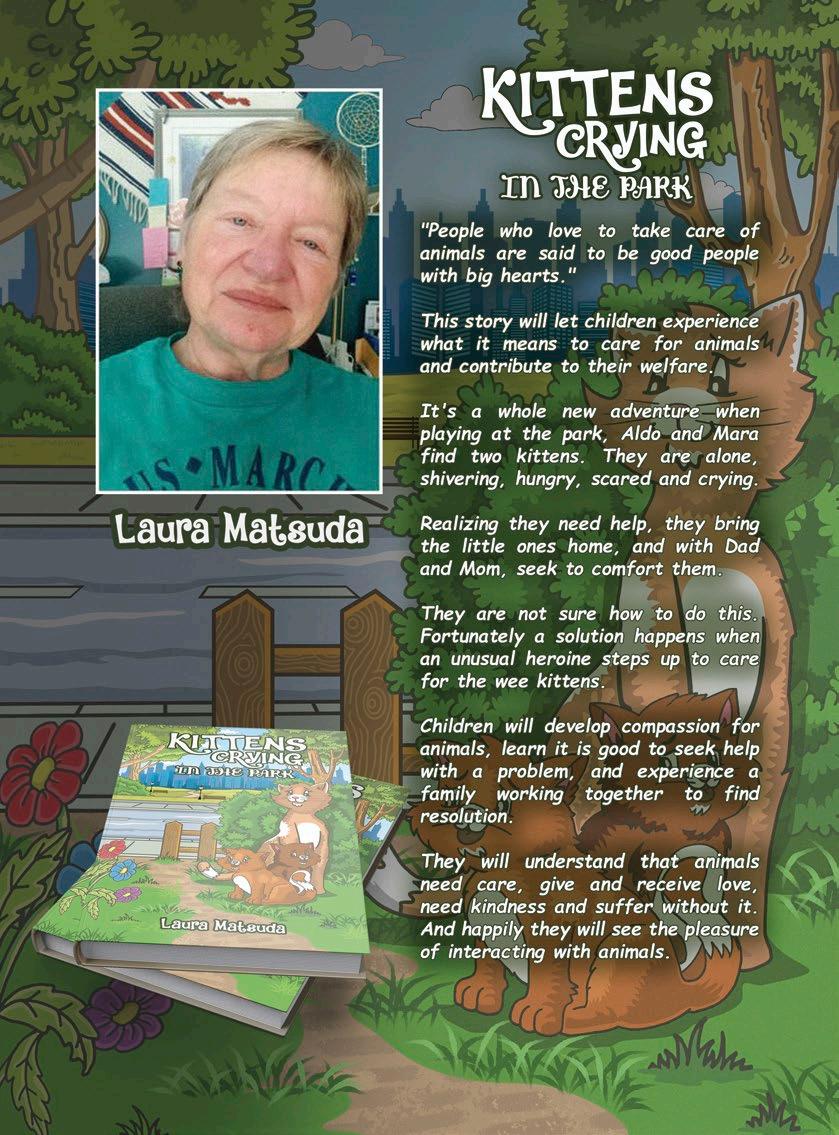
Immunace® was developed over 20 years ago by Vitabiotics’ experts. It was one of the first immune health supplements to pioneer the inclusion of vitamin D for the immune system.


Immunace® Original includes 24 vitamins and nutrients. †With vitamins D, C, zinc and selenium which contribute to the normal function of your immune system.
Immunace® Extra Protection is our advanced formula with the benefits of Immunace® Original, extra vitamin D and more.




From , Superdrug, Holland & Barrett, supermarkets, chemists, health stores www.immunace.com











with 10mcg vitamin D
No.1 Vitamin Company*
Nielsen GB ScanTrack Total Coverage Value and Unit Retail Sales 52 w/e 9 October 2021. To verify contact Vitabiotics Ltd, 1 Apsley Way, London, NW2 7HF. ORIGINAL EXTRA PROTECTION
UK Department of Health recommends that all adults should consider taking a daily supplement containing 10mcg of vitamin D, particularly in Autumn and Winter, as found in Immunace Original 2021-11-26_ADIMMCONP_E
Britain’s
*Source:
SUPPORT YOUR IMMUNE SYSTEM† The























 ANN TIMLETT, via email
ANN TIMLETT, via email










































































































 Mrs Verrell East Sussex
Mrs Verrell East Sussex


























































 illustration by Daniel Mitchell
illustration by Daniel Mitchell















































































































































































































